
- Memberships

Pareto Analysis explained plus example

Pareto Analysis: this article explains the theory of Pareto Analysis by Vilfredo Pareto in a practical way. After reading you will understand the basics of this problem solving tool. This article explains what the analysis is and which steps are needed to apply the analysis, along with an example.
What is the Pareto Analysis?
The Pareto Analysis, also known as the Pareto principle or 80/20 rule, assumes that the large majority of problems (80%) is determined by a few important causes (20%). This makes the tool very effective for determining where you should focus efforts to achieve improvements.
The founder of this analysis, Italian economist Vilfredo Pareto , discovered this when he was carrying out a study at the end of the 18th century in which he ascertained that 20% of the population owned 80% of the property.

This method was further developed by total quality management guru Joseph Juran (after 1940) and can be applied to various matters (for instance decision-making and other complex issues).
A few of the 80/20 rule examples from daily practice which are often correct are:
- 80% of the customer complaints ensue from 20% of the products or services delivered.
- 20% of the products or services yield 80% of the profits.
- 20% of the people responsible for sales generate 80% of the operational income.
- 80% of the system failures are caused by 20% of the system problems.
The principle of this method is based on the Zipf distribution (pattern in linguistics and a discrete probability distribution with parameters λ and N).
In addition to being a static technique, the Pareto Analysis is a creative and practical way of looking at the causes of problems. It stimulates ideas about thinking and organizing. This method helps identify the main causes (20%) that lead to 80% of the problems that need are to be solved.
As soon as the main causes have been identified, the diagnostic techniques such as the Ishikawa diagram or fishbone analysis can be used to identify and address the deeper causes of the problems.
Practice of the Pareto Analysis
In order to apply the analysis in practice some basic steps have been defined which can be followed to arrive at a thorough analysis.
Step 1: Measuring – identify the problems and document them in a table
Based on observations, interviews and reports, data can be collected from which problems can be deduced. Subsequently, these problems are documented in a table and grouped if possible.
It is important to apply the ‘cause-effect’ theory to each item so that the source of each documented problem can be found. There are several techniques that can help in this such as for example the Root Cause Analysis (RCA) .
Step 2: Determine their order of importance
Organize the inventoried problems in ranking order from the most important down to the least important in descending order. Make sure that the most important cause is documented first.
Step 3: Mark or score each recorded problem
Now that the problems have been identified, deduced and been put in order of importance, it is essential to link these to a mark or score. The way in which a score must be calculated depends on the type of problem that needs to be solved.
For example a financial approach (improvement of profits) will focus on how the score relates to what costs are involved with solving these problems. Is the focus on customer-orientation (improving customer satisfaction), then the focus is on the number of complaints that need to be solved.
Pareto Analysis example
An example is a computation of the cumulative percentages of problem costs, in other words, the number of times a department is faced with this problem or the opportunities of how a department can increase sales.
Step 4: Group the identified problem and add the marks or scores
The identified problems are grouped based on their causes. If, for example, there are five problems that lead to dysfunctional employees then put them together in one group. Now that all problems have been grouped, the marks or scores are added.
The group with the highest score must be given the highest priority in order so that they can be dealt with. This is where the most results can be obtained in terms of optimization.
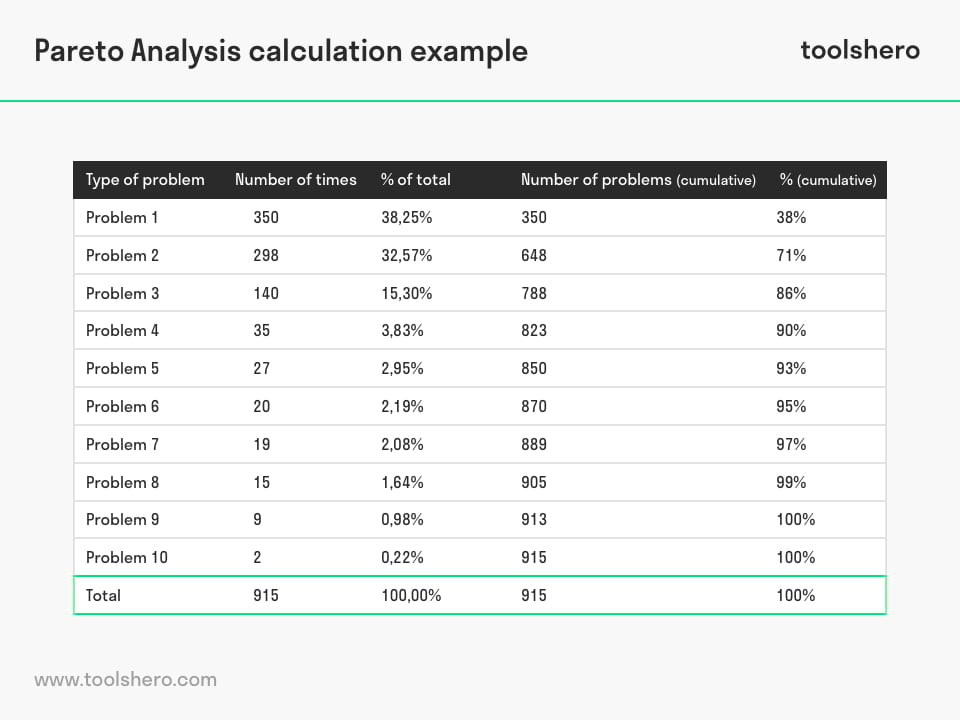
Figure 1 – Pareto Analysis Example
Pareto Analysis diagram
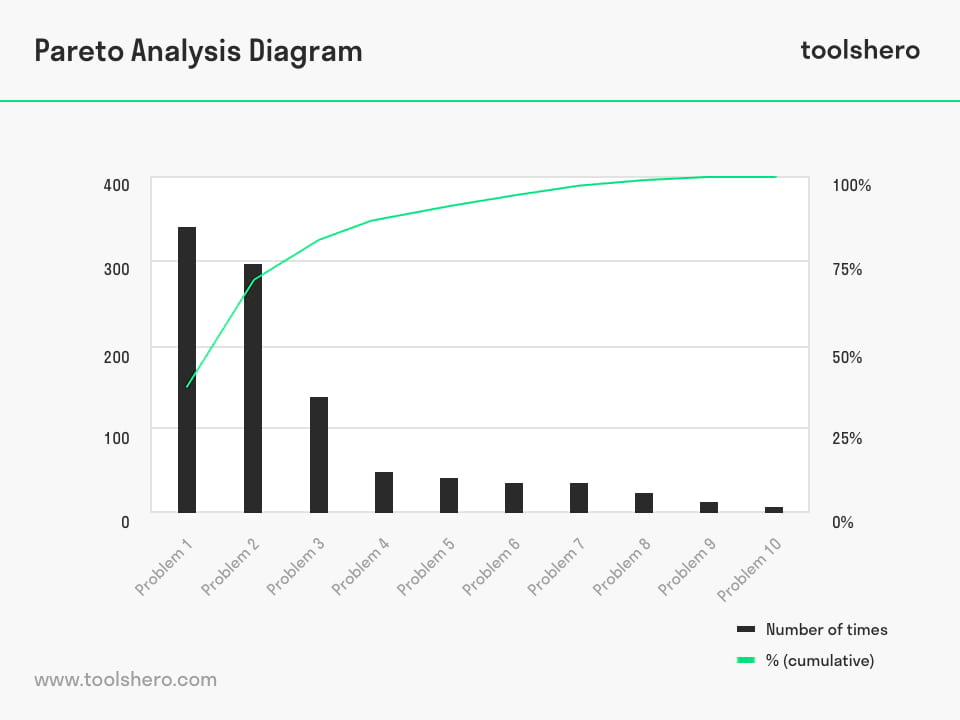
Figure 2 – Plotted Pareto Analysis Diagram
Step 5: Time to act, based on the Pareto Analysis
Using the information from step 4, an action plan can be drawn up in which performance improvement actions can be formulated.

It’s Your Turn
What do you think? Are you familiar with the Pareto Analysis or PA Diagram? Do you recognize the practical explanation or do you have more suggestions? What are your success factors for the good problem analysis and approach?
Share your experience and knowledge in the comments box below.
More information
- Fotopoulos, C., Kafetzopoulos, D., & Gotzamani, K. (2011). Critical factors for effective implementation of the HACCP system: a Pareto analysis . British Food Journal, 113(5), 578-597.
- Karuppusami, G., & Gandhinathan, R. (2006). Pareto analysis of critical success factors of total quality management: A literature review and analysis . The TQM magazine , 18(4), 372-385.
- Kaliszewski, I. (1994). Quantitative Pareto analysis by cone separation technique . Kluwer Academic Publishers .
How to cite this article: Mulder, P. (2012). Pareto Analysis . Retrieved [insert date] from Toolshero: https://www.toolshero.com/problem-solving/pareto-analysis/
Original publication date: 08/12/2013 | Last update: 05/22/2024
Add a link to this page on your website: <a href=”https://www.toolshero.com/problem-solving/pareto-analysis/”>Toolshero: Pareto Analysis</a>
Did you find this article interesting?
Your rating is more than welcome or share this article via Social media!
Average rating 4.2 / 5. Vote count: 13
No votes so far! Be the first to rate this post.
We are sorry that this post was not useful for you!
Let us improve this post!
Tell us how we can improve this post?

Patty Mulder
Patty Mulder is an Dutch expert on Management Skills, Personal Effectiveness and Business Communication. She is also a Content writer, Business Coach and Company Trainer and lives in the Netherlands (Europe). Note: all her articles are written in Dutch and we translated her articles to English!
Related ARTICLES

Convergent Thinking: the Definition and Theory

Vilfredo Pareto biography, quotes and books

Root Cause Analysis (RCA): Definition, Process and Tools

Soft Systems Methodology (SSM) by Peter Checkland

Artificial Intelligence (AI) explained

CATWOE Analysis: theory and example
Also interesting.

PDCA Cycle by Deming: Meaning and Steps

Straw Man Proposal: The basics and template

TRIZ Method of Problem Solving explained
One response to “pareto analysis explained plus example”.
Btw, I think it is: “80% of the system problems/defects are caused by 20% of the system failures “
Leave a Reply Cancel reply
You must be logged in to post a comment.
BOOST YOUR SKILLS
Toolshero supports people worldwide ( 10+ million visitors from 100+ countries ) to empower themselves through an easily accessible and high-quality learning platform for personal and professional development.
By making access to scientific knowledge simple and affordable, self-development becomes attainable for everyone, including you! Join our learning platform and boost your skills with Toolshero.

POPULAR TOPICS
- Change Management
- Marketing Theories
- Problem Solving Theories
- Psychology Theories
ABOUT TOOLSHERO
- Free Toolshero e-book
- Memberships & Pricing

Strategy Peeps: Streamlining Processes, Maximizing Efficiency - Bringing Order to Chaos
- Aug 5, 2023
Mastering Problem Solving with Pareto Analysis (80/20 rule)
Pareto Analysis is one of the most interesting guiding principle to efficiently allocate resources and address the most critical issues. Named after Italian economist Vilfredo Pareto, this technique helps organizations focus their efforts where they matter most. Want to understand Pareto Analysis, its significance, methodologies, and real-world applications? Let's see what we can do

What is Pareto Analysis?
Pareto Analysis, also known as the 80/20 rule, is a decision-making tool that suggests that a significant portion of results (80%) is usually derived from a small number of causes (20%). In other words, by identifying and addressing these vital few causes, organizations can achieve maximum impact and improve efficiency.
The Power of the 80/20 Rule
The Pareto Principle holds immense importance across various fields:
Business Management : Focus efforts on areas that yield the most substantial returns and prioritize resource allocation accordingly.
Quality Improvement : Identify and address the most significant factors contributing to defects or errors in a process.
Time Management : Concentrate time and energy on tasks that contribute the most to personal or organizational goals.
Steps to Conduct Pareto Analysis
Define the Problem : Clearly define the problem you want to analyze. This could be related to product defects, customer complaints, process inefficiencies, or any other relevant issue.
Data Collection : Gather data related to the problem. This could include quantities, frequencies, or impacts of various factors.
Create a Frequency Chart : Develop a frequency chart or histogram to visualize the occurrences of each factor.
Rank the Factors : Order the factors from highest to lowest based on their frequency or impact.
Calculate Cumulative Percentages : Calculate the cumulative percentage of each factor by adding up the percentages from the highest ranked factor.
Plot the Pareto Chart : Plot a bar chart with factors on the x-axis and their cumulative percentages on the y-axis.
Analyze the Chart : Identify the point at which the curve starts to level off. This is the point where diminishing returns occur.
Focus on the Vital Few : Concentrate your efforts on addressing the factors that contribute to the majority of the problem.
Real-Life Application of Pareto Analysis
Let's consider a practical example: A restaurant is receiving customer complaints about its service.
Problem : Customer Complaints
Factors : Rude Staff, Slow Service, Incorrect Orders, Cold Food, Noise
By conducting Pareto Analysis, the restaurant discovers that 80% of the complaints are attributed to just two factors: Slow Service and Incorrect Orders. By focusing on improving these areas, the restaurant can significantly enhance the overall customer experience.
Benefits of Pareto Analysis
Efficient Resource Allocation : Allocate resources, time, and efforts to areas that will yield the most substantial improvements.
Informed Decision-Making : Make informed decisions based on data and prioritize actions for maximum impact.
Problem Prioritization : Focus on addressing the most critical issues, leading to enhanced quality and efficiency.
Continuous Improvement : Implement targeted solutions to continuously refine processes and outcomes.
Pareto Analysis is more than just a mathematical/economical concept; it's a guiding principle for smart decision-making and impactful problem-solving. By identifying the vital few factors that contribute to the majority of a problem, organizations can achieve significant improvements with focused efforts.
Embrace the power of Pareto Analysis and unlock a world of insights that will empower you to make strategic choices, drive efficiencies, and achieve remarkable results. Apply the 80/20 rule and watch your efforts generate disproportionate success!
Recent Posts
Unveiling Customer-Centric Success: Generate Value through Lean Project Management
What is Lean Project Management?
What is Value Stream Mapping (VSM)? - 6 Steps to Leverage VSM for Optimal Process Performance
Careful With That Axe, Eugene
Thinking and ranting out loud - my own thoughts and comments written whenever the mood takes me. Nothing is safe, Chop Chop! Blog title from a song by Pink Floyd.
- Publications
- Photo Gallery
Monday, November 23, 2009
Problem-solving techniques: #1 pareto analysis, no comments:, post a comment.

The Pareto Chart: How to Solve Problems & Make Informed Decisions
I’ve just finished watching this Netflix docuseries and I can’t stop thinking about it.
The Last Dance .
It’s ten juicy episodes, full of massive egos, incredible basketball, and a banging 90’s hip-hop soundtrack. It’s a fantastically brutal account of how the Chicago Bulls came to dominate the basketball scene throughout the 1990s.
The team was led to countless victories by three key players: Michael Jordan, Scottie Pippen, and Dennis Rodman.
This, coincidentally, demonstrates the concept behind the Pareto chart, and this Process Street post perfectly.
I’ll explain what I mean by this later. First, let me go through what we’ll cover in this post:
What is a Pareto chart?
Where did the pareto chart come from, how to read a pareto chart, when to use a pareto chart, how to create a pareto chart with process street.
I’m excited to get started. So, my cagers, let’s take it to the hole!
I admit. I may have googled “ basketball terms ” for that sentence… what I’m basically saying is; C’mon you lot! Let’s go!
Remember math lessons as a kid? I mean before it began to get tricky with trigonometry and algebra. When it was working through straightforward sums and creating graphs? The ‘fun’ stuff.
Well, keep hold of that memory as it will come in handy for this post.
Because the Pareto chart is, essentially, a plain old bar graph.
A Pareto chart, in its simplest form, is a bar chart that arranges the bars from largest to smallest, from left to right. The bigger bars on the left are more important than the smaller bars on the right.
Like a lot of bar charts.
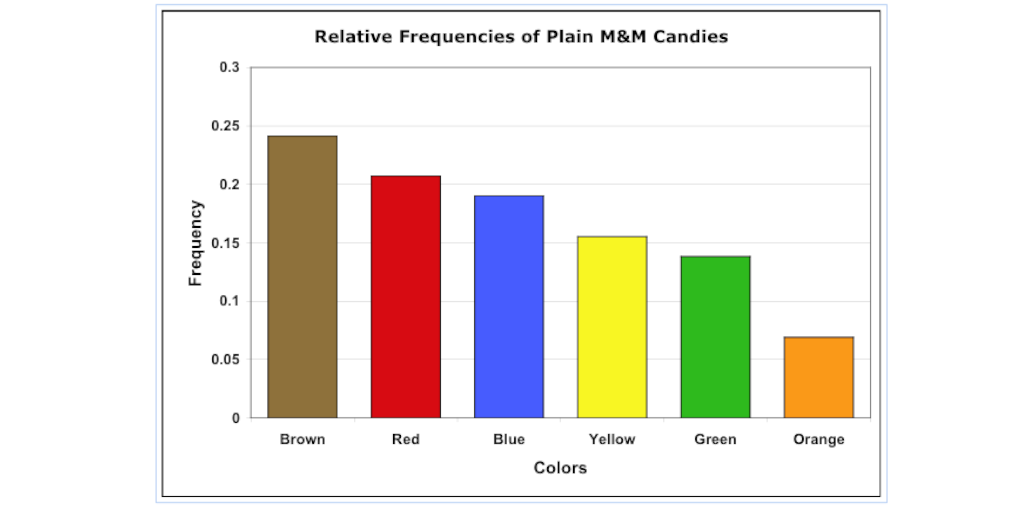
However, this simple little bar chart is different from the bar charts you created when you were six. This bar chart is used by organizations, in almost every industry, for root cause analysis . In other words, it’s a vital quality management tool .
A Pareto chart enables organizations to make decisions on where to focus their efforts so they get as much bang for their buck as possible.
How does a humble bar chart do that?! I hear you ask.
Well, it’s so simple it almost sounds silly.
By graphically separating the aspects of a problem, an organization can instantly see where to direct its improvement efforts. Focusing its efforts on reducing the largest bars in the chart, will do more for overall improvement than reducing the smaller ones.
Take this Pareto chart below as an example.
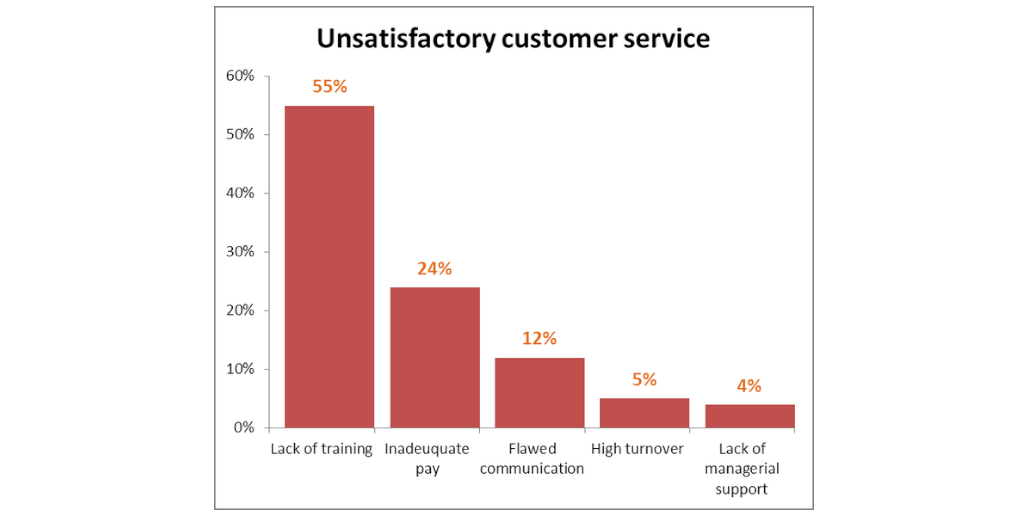
With a quick glance, we can instantly see that a lack of training and inadequate pay cause the highest number of customer service complaints.
The Pareto chart theory suggests that if the organization prioritized training and increasing pay, they would see the biggest improvement in customer service.
It’s a tool that’s been used for decades by problem solvers to separate the vital few factors from the trivial many and prioritize actions.
For those that are familiar with the 80/20 rule, the phrase ‘ separating the vital few from the trivial many ’ may have rung a few bells?
That’s because the Pareto chart is a visual representation of the 80/20 rule.
The 80/20 rule states that 80% of the results are determined by 20% of the causes. The Pareto chart displays the few, most significant defects, that make up most of the overall problem.
By ordering the bars from the largest to the smallest, a Pareto chart helps you to visualize which factors comprise the 20% that are the vital few, and which factors make up the trivial many.
“ The significant few things will generally make up 80% of the whole, while the trivial many will make up about 20% ” – Pareto Diagram , PQ Systems
While we’re on the subject of the 80/20 rule, for those of you who don’t know, the 80/20 rule is also referred to as the ‘Pareto principle’. This leads me, quite nicely, to talk about where the Pareto chart came from.
You’re going to love this.
This is the story behind where the Pareto chart came from.
The Pareto chart takes its name from a 19th-century Italian called Vilfredo Pareto, and as we touched on earlier, the concept is based on the 80/20 rule.
Pareto, a philosopher, economist, and keen gardener, had an epiphany one day, while out picking peas.

He noticed that roughly 20% of his pea plants seemed to generate around 80% of the peas.
Now, most of us might’ve thought; “ Hah! Well, would you look at that! ” and carried on with our daily lives.
But not Vilfredo Pareto.
This observation led him to think about uneven distribution , and where better to start with that concept than by looking at wealth.
He discovered that around 80% of the land in Italy was owned by 20% of the population.
He then investigated different industries and found that 80% of production typically came from only 20% of companies.
Although he researched and wrote papers on this theory, he never took it further than wealth and prosperity.
It was the “ Father of Quality Management ” Dr. Joseph M. Juran, who extended this theory into the business world.
Juran, while detecting manufacturing problems at Western Electric , noticed that a small number of defects in parts and machines seemed to cause most of the issues he found in quality.
He came across Pareto’s earlier work and found it made a lot of sense.
He recognized that “ the vital few and the trivial many ” pattern was a universal principle that could be applied to almost all organizations, in any industry, to help them make decisions on what to focus on to improve quality.
This theory is proven when you look at examples like these:
- 80% of web traffic comes from 20% of your site’s pages
- One search engine (Google) receives 64% of search queries
- 80% of the logic of a software program is run using 20% of the classes or code
- 3% of Guatemalans own 70% of the land in Guatemala
- 80% of the software errors are caused by 20% of the bugs
- 20% of your wardrobe is worn 80% of the time
- 80% of crimes are committed by 20% of criminals
- 80% of wins in sport are produced by 20% of the players on a given team (remember this one for later!)
So that’s how the Pareto principle came about.
The Pareto chart, being a visual representation of the Pareto principle, was developed to allow companies to see where the major causes of a problem were. This enabled them to focus their time and efforts on the greatest potential for improvement .
“ It’s common sense to focus on the ‘vital few’ factors. In the quality improvement arena, Pareto charts help teams direct their efforts where they can make the biggest impact ” – When to Use a Pareto Chart , The Minitab Blog
We all know how to look at a bar chart and work out what it’s telling us, but there’s a little more to interpreting a Pareto chart than meets the eye.
As we’ve previously covered, in its simplest form, a Pareto chart is a bar graph that shows where the biggest opportunities for quality and process improvement lie.
It’s simple, easy to read and there’s nothing wrong with using this method to decide where to focus your efforts.
However, there is another, arguably more accurate, way of interpreting a Pareto chart.
We can take the simple bar chart a step further by adding in a line.
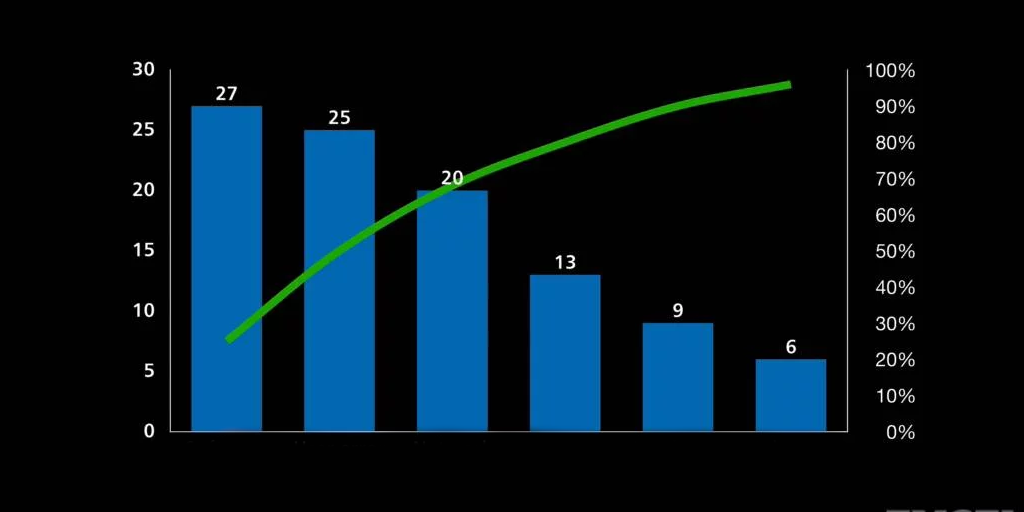
The line, like the one in the example above, is a cumulative percentage line.
Ok, I know. Earlier I urged you to remember the ‘fun’ math. I don’t remember line graphs and cumulative percentages being much fun either, but stick with me. It’s nowhere near as bad as Algebra or Pythagoras.
To understand how to read a Pareto chart, like the one above, we first need to understand the components of a Pareto chart and the relationship between each one.
So let’s start by looking at the basic structure of a Pareto chart, using the below ‘shirt defect’ chart as an example.
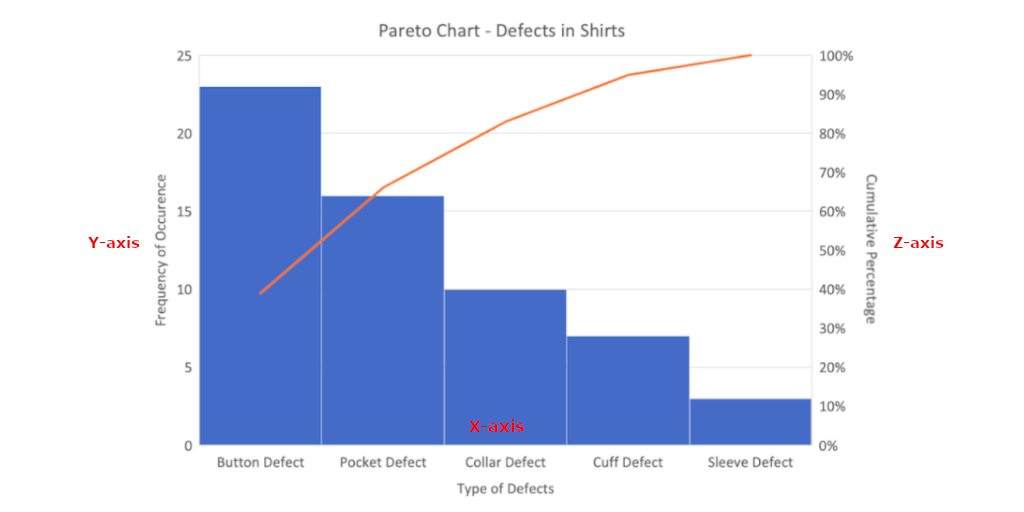
We can see that there are three axes in this chart: X, Y, and Z which represent the following:
- X-axis shows the different types, or categories, of defects
- Y-axis shows how often these defects occur
We’ll talk about the third axis in a second.
We can see that each vertical bar in the chart represents a type of defect and the height of each bar represents the frequency in which that type of defect occurs.
So, from the example above, we can see that button defects occur 23 times, whereas sleeve defects happen only three times.
We can also see that the bars are presented in descending order (from tallest to shortest) so we can instantly see which defects are most frequent at a glance.
Now we understand that bit, let’s bring in the third axis.
- Z-axis represents the cumulative percentage
The cumulative percentage indicates what percentage of all defects can be removed if the most important types of defects are resolved.
To plot the cumulative percentage line, you’ll need to get your calculator out and work out the cumulative percentage for each defect using this formula:
Total frequency of all defects / The frequency of each defect x 100.
Plot these percentages as you would on any normal graph and then join them up with a line.
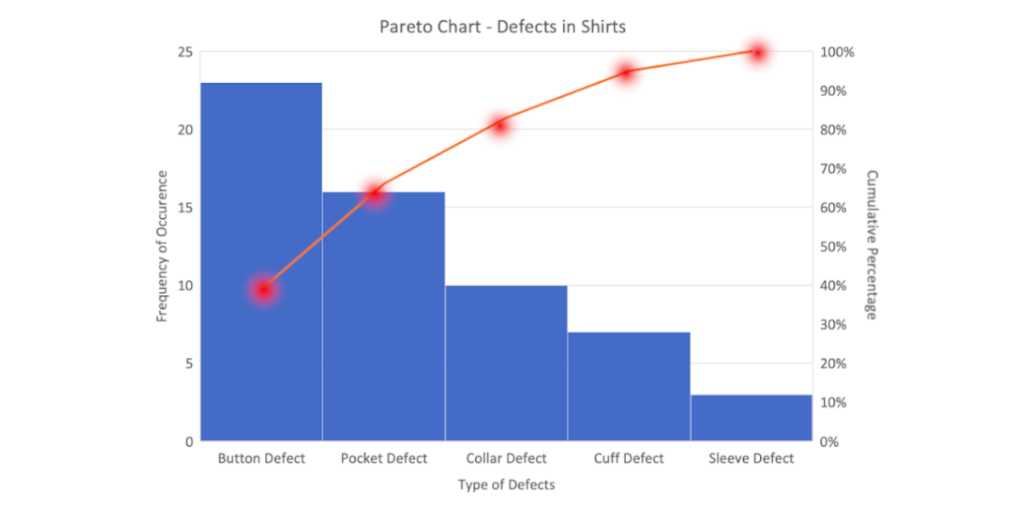
Now you have your cumulative percentage line, using the Pareto principle, find the 80% mark on the Z-axis, and draw a dotted line across until you hit your cumulative percentage line.
Then, immediately drop your dotted line downwards.
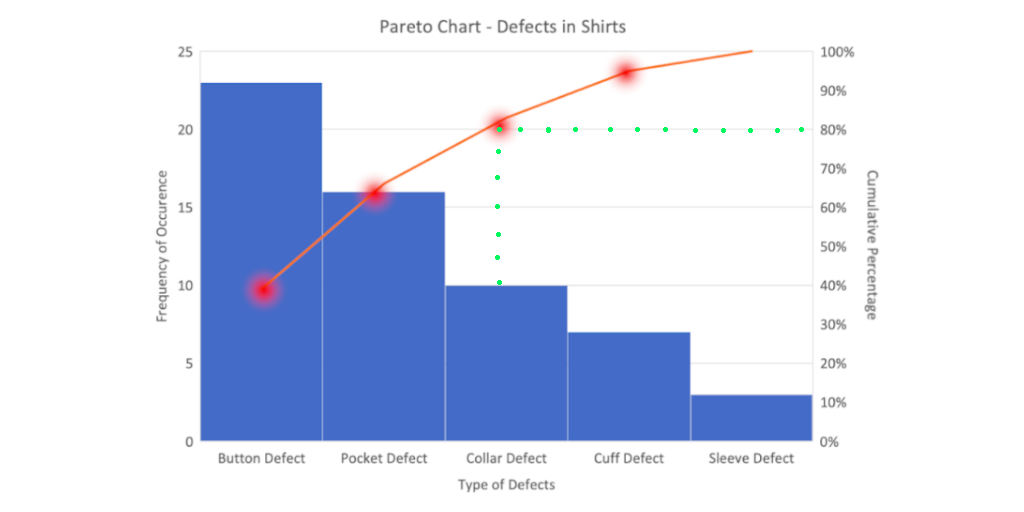
The defects to the left of this dotted line, on the X-axis, are the defects that, if addressed, will deliver the greatest benefit. These are the ‘vital few’ defects, out of the ‘trivial many’, to focus on.
Let’s go back to our shirt defect example. According to the Pareto principle, if we focused our efforts on resolving the pocket and button defects, we should see the biggest improvement in the quality of our shirts.
It’s worth noting that, in any Pareto chart, when the cumulative percentage line is steep, the types of defects are likely to have a significant effect. When the cumulative percentage line starts to flatten, the types of defects aren’t likely to influence the outcome as much, so they don’t deserve as much attention.
Once you’ve used a Pareto chart to decide what to focus your efforts on, it’s a great time to then bring something like the PDCA cycle into your organization to help you manage the changes you need to implement.
In fact, Process Street has created a few change management templates that you can access, for free, to help you with this.
PDCA Cycle Change Management Model Process Checklist
Click here to access the PDCA Cycle Change Management Model Process Checklist!
Satir Change Management Model Process Checklist
Click here to access the Satir Change Management Model Process Checklist
I’ve only given you two change management templates in this post, but we have heaps more for you to use. Take a look at this post .
My word. I have steam coming from my ears. I’ve had enough of math, fancy a game of basketball instead?
As we’ve already established, Pareto charts are used by organizations to figure out where the problems are and decide what to focus on to get the best results.
“ Pareto charts are most useful for identifying what the biggest issues regarding your business are. They also help you analyze how to present the issues that need tackling in a simpler, more understandable manner. In addition, they also help to guide where to look in terms of figuring out the frequency of a certain problem in your company ” – How to Do Pareto Chart Analysis , Tallyfy
Below are a few ways you might use a Pareto chart to make key decisions in your organization:
- You could use it to work out which top 20% of your company’s processes are causing 80% of the problems and focus on refining those processes.
- You could use it to establish which 20% of your clients are responsible for 80% of your sales and create a high-touch program for them.
- You could use it to assess all your upcoming projects, decide which ones will make the most difference, and start those first.
- You could use it to decide which tasks to prioritize , like the CEO of Dell does. He uses a Pareto chart on a daily basis to make sure he spends 80% of his time on the 20% of tasks that will generate the biggest results.
Speaking of daily tasks, once you’ve used the Pareto chart to decide what to focus on, you could use this Remote Daily Work Schedule Template to help keep you on track:
Although the checklist is for remote workers, you can adapt it if you’re office-based. I’ll tell you how to do that in a second.
So you can see that the Pareto chart can be been applied in all sorts of settings. And as it turns out…
“ It also applies to both the NBA and the WNBA. Specifically, in general, about 80% of a team’s wins are produced by a team’s top three players ” – The Pareto Principle Sheds Light On The WNBA’s Western Conference Contenders , Forbes
If you were a basketball coach, you could use a Pareto chart to determine which 20% of the team contribute to 80% of the wins, and focus your time and efforts on improving those players.
Kind of like what possibly happened between 1991 and 1998 with the Chicago Bulls.

As I touched on earlier, the Netflix mini docuseries ‘The Last Dance’ shows how the Chicago Bulls became unbeatable in the ’90s.
The team won the NBA championship six times over the course of eight years thanks to three players (Micheal Jordan, Scottie Pippen, and Dennis Rodman), and some sound decisions, made by head coach, Phil Jackson.
**Conspiracy alert!**

Surprisingly, the Netflix series doesn’t state whether Phil Jackson utilized the Pareto chart to make the critical decision to focus his coaching efforts on Jordan, Pippen, and Rodman. But I’d like to think it had a part to play in the Bull’s success.
( Maybe a 20% part ?!)
Now we know what the Pareto chart is, where it came from, how to read it, and when to use it, let’s talk about how to create one.
As we’ve discussed, one of the greatest uses for the Pareto chart is in quality control and process improvement.
This is something that Process Street is expert in.
Process Street is super-powered checklists .
Our state of the art business process management (BPM) software allows you to create templates, run individual checklists , and manage recurring tasks faultlessly.
Watch this introductory video to get a better idea about who we are and what we do:
So as you can see, you can check tasks off as you work through them, set deadlines, request approval from colleagues, assign tasks , and track each team member’s progress . You can also connect to thousands of apps through Zapier , webhooks, or API integration.
How can all this help you create a Pareto chart though?
Glad you asked.
You could create a template, and, each time you want to create a new Pareto chart, run a new checklist from this template.
It’s super easy.
All you’d need to do is create a new template and add the following 12 steps into your template, as tasks, that you can then work through:
Step 1: Identify the problem Define the problem as accurately as you can so you can work out all the various factors that may be contributing to it, in the next step.
Step 2: List the contributing factors Determine what root causes are contributing to the problem and put them into categories.
Step 3: Decide on the measurement Establish how you will measure the impact of each contributing factor or category. This is usually the number of occurrences or cost.
Step 4: Establish a time period Decide what period of time the Pareto chart will cover: One sprint? One full day? A week?
Step 5: Collect the data Collect the data for each of the categories you have chosen and place it into a table so you can work out your cumulative percentages easily.
Step 6: Draw the Y-axis and X-axis Label the Y-axis with the measurement and the X-axis with the categories.
Step 7: Construct and label bars for each category Place the tallest at the far left, then the next tallest to its right, and so on.
Step 8: Draw Z-axis Once you’ve drawn the right vertical axis, label it with percentages.
Step 9: Calculate your cumulative percentages Use this calculation to work out your cumulative percentages: Total frequency of all categories / The frequency of each category x 100.
Step 10: Plot and draw your cumulative percentage line Make sure that the last dot reaches 100% on the Z-axis (as all cumulative percentage must reach 100%)
Step 11: Establish what your focus should be Find 80% on the Z-axis and draw a horizontal line until it hits the cumulative percentage line. Whatever lies to the left of that point is your ‘vital few’.
Step 12: Implement the changes Using change management processes like the Lewins Change Management Model, or the ADKAR Model start to implement the changes that will cause the most affect.
That’s it! Simple.
If you’re a little unsure, don’t worry. To help get you used to the software, below are some similar problem solving, root cause analysis templates that you could use to get started:
FMEA Template: Failure Mode and Effects Analysis
Click here to access the FMEA Template: Failure Mode and Effects Analysis Template!
Root Cause Analysis Template
Click here to access the Root Cause Analysis Template!
SWOT Analysis Template
Click here to access the SWOT Analysis Template!
If you’re feeling a bit braver, you could edit the existing templates so they suit your organization better, or even create your own Pareto chart process template.
If you’re planning to go down this road, try adding some of these features into your template:
- Dynamic due dates
- Task permissions
- Conditional logic
- Approval tasks
- Embed widget
- Role assignments
These features will help you to automate your newly created processes.
I can’t even begin to tell you how much time and effort automating your business processes will save you. But I know a man who can.
Blake Bailey.
He ran the below Process Street webinar on advanced workflow automation. Watch it. It’ll explain everything there is to know about workflow automation, and I guarantee you’ll never create a manual, laborious process even again!
Or, check out these great articles on how you could automate your business:
- 24 Best apps & software to automate your small business
- Small Business Automation: A Guide To Getting Things Done
- 40 Marketing Automation Tools: The Best Software for Growing Your Business
- Add value to your firm with process automation services
- Top 5 Benefits of Business Automation in 2020
Speaking of great articles , we’ve written tonnes on quality management, process management , root cause analysis, and the like.
Check out a few of them below.
Pareto chart related articles
- How to Perform a Root Cause Analysis (Free Template)
- Best QMS Software for Quality Management Systems: Which is Right for You?
- What is ISO 9000? The Beginner’s Guide to Quality Management System Standards (Free ISO 9001 QMS Template)
- What is Quality Management? The Definitive QMS Guide (Free ISO 9001 Template)
- What is a Quality Management System? The Key to ISO 9000
- What is Porter’s Five Forces Model? Competitive Position Analysis Explained
- What is FMEA? A Practical Guide to Failure Analysis (Free Checklist)
- What is Process Mining? 9 Tools to Optimize Your Process Management
When you’re trying to get the most bang for your buck , focusing on the critical 20% is a huge time-saver. See what activities generate the most results and give them the appropriate attention.
So, my cagers, that’s it! But before I shoot my last shot, if a Pareto chart seems a bit basic, well, it is.
However…
“ Its very simplicity makes the Pareto chart applicable to a very wide range of situations, both within and beyond quality improvement ” – When to use a Pareto Chart , Minitab
Do you use the Pareto chart in your organization? If so, how do you find it? We’d love to hear your thoughts in the comments below. Who knows? You may even get featured in an upcoming article!
Get our posts & product updates earlier by simply subscribing
Amanda Greenwood
Amanda is a content writer for Process Street. Her main mission in life is to write content that makes business processes fun, interesting, and easy to understand. Her background is in marketing and project management, so she has a wealth of experience to draw from, which adds a touch of reality and a whole heap of depth to the content she writes.
Leave a Reply Cancel reply
Your email address will not be published. Required fields are marked *
Save my name, email, and website in this browser for the next time I comment.
Take control of your workflows today

Pareto Analysis

What is Pareto Analysis
Pareto Analysis (also referred to as Pareto Chart or Pareto Diagram) is one of the Seven Basic Quality Tools [1] for process improvement.
These seven basic tools form the fixed set of visual exercises most helpful in troubleshooting issues related to quality. They are called “basic” because they require little formal training in statistics and can effectively address most quality-related problems.
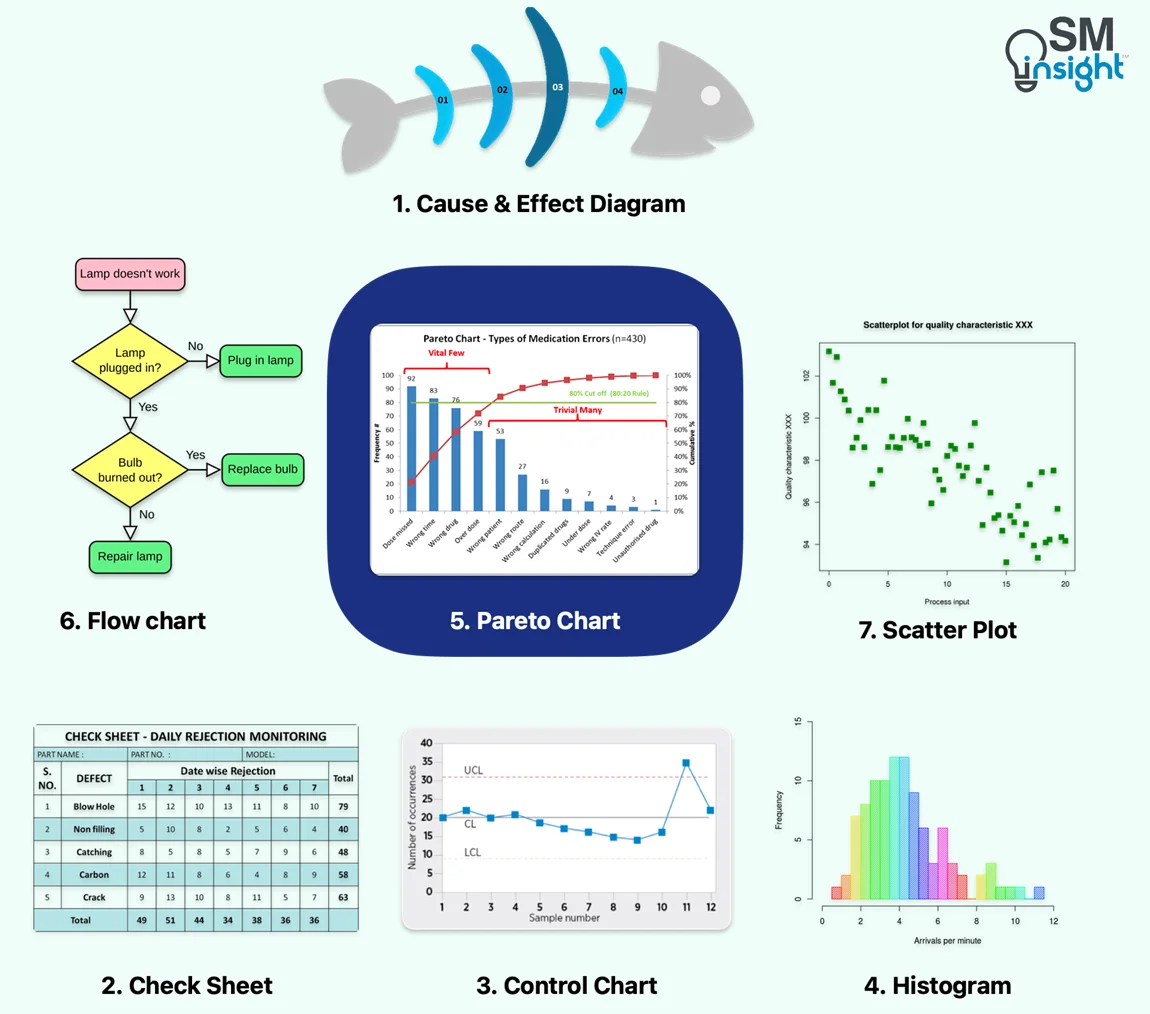
This article will focus comprehensively on the Pareto Analysis, its origin, how a Pareto Chart is constructed and its relevance in modern-day problem-solving.
Origin of Pareto Analysis
Pareto Analysis traces its roots to the Pareto Principle, first observed by the Italian sociologist and economist Vilfredo Pareto. [2] While studying income distribution across Italy in 1986, Vilfredo showed that 80% of income in the country was owned by 20% of the population.
Vilfredo’s work was extended by Joseph Juran [3] , an American engineer and well-known quality management advocate.
Juran theorized that losses are never uniformly distributed over the quality characteristics. Rather they are always maldistributed in such a way that a small percentage of the quality characteristics always contributes a high percentage of the quality loss.
This forms the basis of the Pareto Principle, which, in simple words, means “for many outcomes, roughly 80% of consequences come from 20% of causes” .
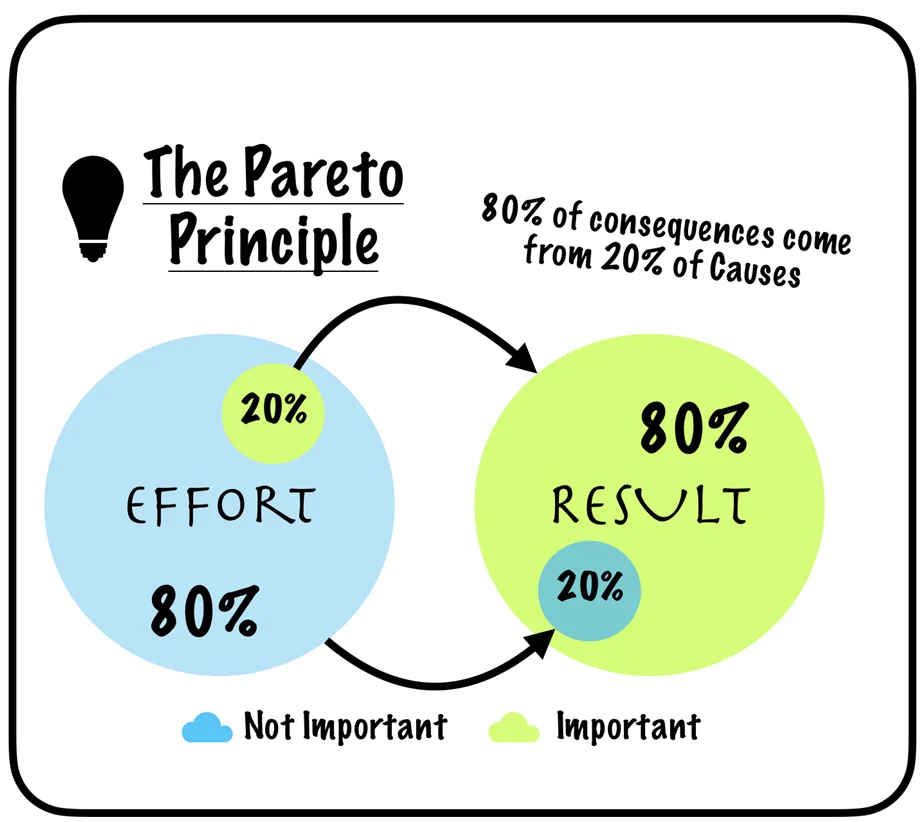
This principle is also known as The 80/20 Rule (most common), The Law of the Vital Few or The Principle of Factor Sparsity , which all interchangeably mean the same.
It is important to note that although many systems tend to follow an approximate 80-20 pattern, this is not an absolute or obligatory rule. The distribution can vary, such as 90-10 or 70-30, while still adhering to the underlying principle that many outcomes are a result of a few causes.
Why use Pareto Analysis?
Organizations have diverse goals and aspirations but in most cases, are constrained by resources (money, manpower, machines, technology etc.).
Under such limitations, Pareto Analysis can help create maximum impact with the least amount of effort. This enables teams to work more efficiently on specific initiatives. Targets can be achieved faster simply by prioritizing initiatives in the right order.
Other benefits include:
- Setting clear priorities for the organization
- Increased daily productivity
- Ability to portion work into manageable segments
- Focused strategy
Pareto Analysis optimizes the overall organization’s performance by pointing to the highest return activities that can be pursued for maximum benefits.
When to use a Pareto Analysis?
The most compelling use case of a Pareto Analysis is to optimize the utilization of an organization’s resources by focusing them on a few key areas rather than spreading them over many others that have little impact on results.
Pareto Analysis helps identify patterns that highlight the main reasons behind most of the challenges an organization is trying to solve.
But, to perform a Pareto Analysis, the process data must fulfill two criteria:
1) It must be possible to arrangeable the data into categories
The core part of the analysis involves breaking down complex issues into their constituent root causes so that the repeating causes can be prioritized according to the number of occurrences.
For example, if an automobile assembly manager wants to analyze failures in the production line, it must be possible to classify them into categories such as equipment failures, material shortages, worker absenteeism, and quality defects.
Without this classification, it will not be possible to prioritize one category over another.
2) The ranking of the categories should matter
If the ranking of categories does not matter, the data frequency is no longer relevant for decision-making.
For example, if the assembly line manager determines that addressing the top two categories, equipment-related issues, and material-related issues, will have the most significant impact on reducing delays, the exact frequency difference between these two categories becomes less important. The focus is on resolving both categories as they are the primary contributors to the delays.
In this case, the data frequency becomes less relevant because the primary goal is to address the critical categories and minimize their impact, regardless of the precise order between them.
A Pareto Analysis will not add value in such a case.
Components of a Pareto Chart
A Pareto Chart is a combination of a bar graph and a line graph. It consists of four major components:
| The category of data is plotted along the X-axis. In the below example, the categories are the causes of delay in an assembly line manufacturing setup. | |
| Occurrences of each of the categories are plotted along Y-axis. This represents the number of recorded cases where a particular cause led to the delay. | |
| The height of the bar represents the frequency of occurrence of a particular category. These bars must be arranged in descending order. | |
| Shows the cumulative percentage (on the y-axis) while traversing the categories from left to right. A secondary Y-axis with a 0 to 100% scale is used to plot the cumulative line graph. |
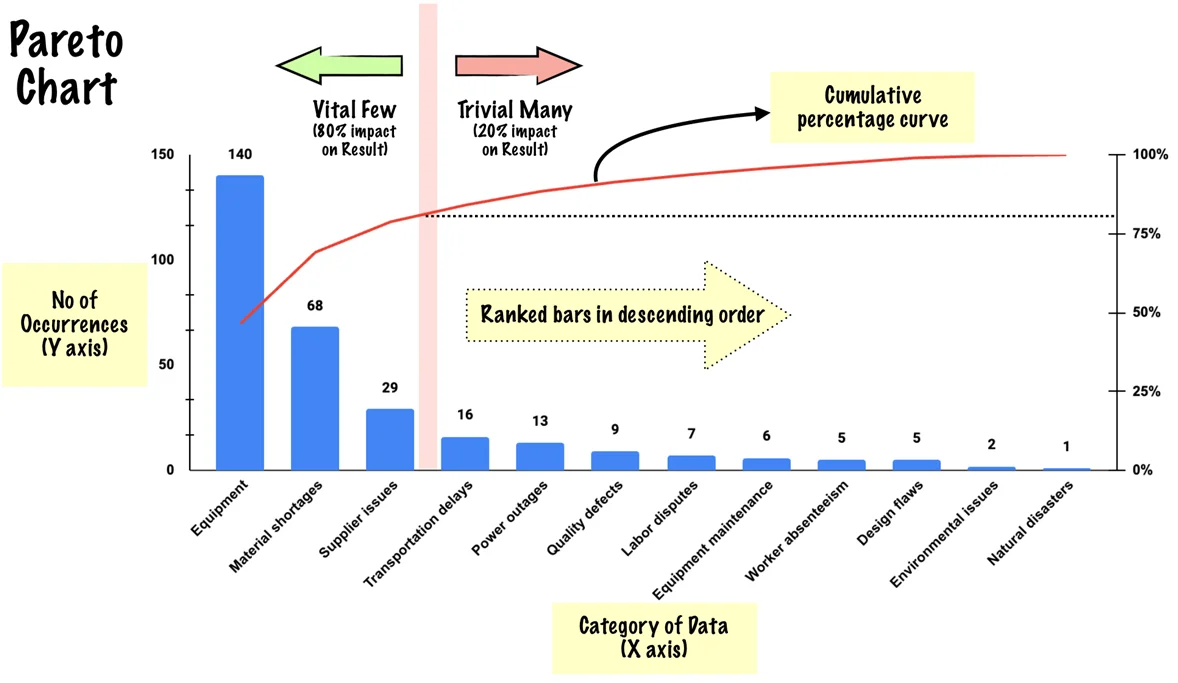
Constructing a Pareto Chart
To demonstrate the components and process of building a Pareto diagram, consider the example of a company that is facing delays in shipping products due to various problems in its production line.
The company has limited resources to spare and cannot focus on all the root causes. It must judiciously allot resources (manpower, management attention, funds etc.) such that chances of on-time delivery are maximized.
By performing a Pareto Analysis, the resulting Pareto Chart can help the company make the best use of its resources. The process involves the following steps:
Step 1 – Decide on the categories
Categories are the list of causes/events that contribute to a problem being addressed. This could be gathered through feedback from employees, clients, or customers.
It is important that the list of causes identified accurately reflect the issue. An analytical approach to preparing a root cause list could be by using a Five-Whys analysis.
In the case of the example considered, the company has identified a total of 12 causes that have led to the delays, which are:
| (1) Equipment failures | (7) Labor disputes |
| (2) Material shortages | (8) Design flaws |
| (3) Worker absenteeism | (9) Supplier issues |
| (4) Quality defects | (10) Equipment maintenance |
| (5) Power outages | (11) Natural disasters |
| (6) Transportation delays | (12) Environmental issues |
Step 2 – Establish a measurement metric
The next step is to identify a measurement metric that is most appropriate to the grouped categories.
These could range from the number of product defects per batch to the frequency of customer complaints, to how many resources it takes to manufacture a product to how long it takes to resolve customer complaints, etc.
In the case of the above example, the number of times a particular root cause was responsible for the delay is a good metric to consider.
Step 3 – Choose a timeframe to collect the data
This can be one work cycle, a sprint, one full day, one week, one month etc. In the case of the example, the company has chosen to record one week’s data.
It is important to choose a sufficiently broad timeframe to even out the impact of rare events and aberrations. For example, in the example’s case, if a day was selected instead of a week, it may not accurately capture the trends in material shortages or transportation delays. This could lead to misleading results.
Step 4 – Record the data over the selected timeline
Gather data on the number of times each chosen category was responsible for the delay. The measurement metric in this example case is the frequency, which was selected in Step-2. It could vary depending on the choice.
The recorded data must then be organized in a table according to the categories and timelines selected. In the case of the company’s example, the selected timeline is one week with 12 categories. Hence, the data tabulation will look as below:
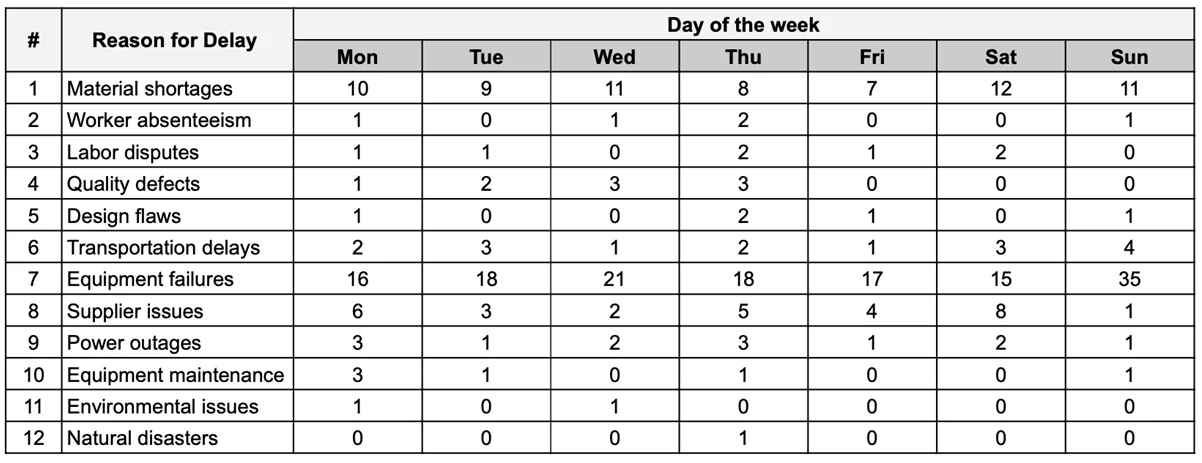
Step 5 – Organize the data
The output of this step is a table with categories sorted in descending order as per their occurrence over the selected period.
In the example case considered, the steps would involve aggregating the occurrences by adding totals to each category, constructing a smaller table (or hiding the daily data) and then sorting the data in descending order based on occurrences of each root cause.
The same is shown in the figure below:
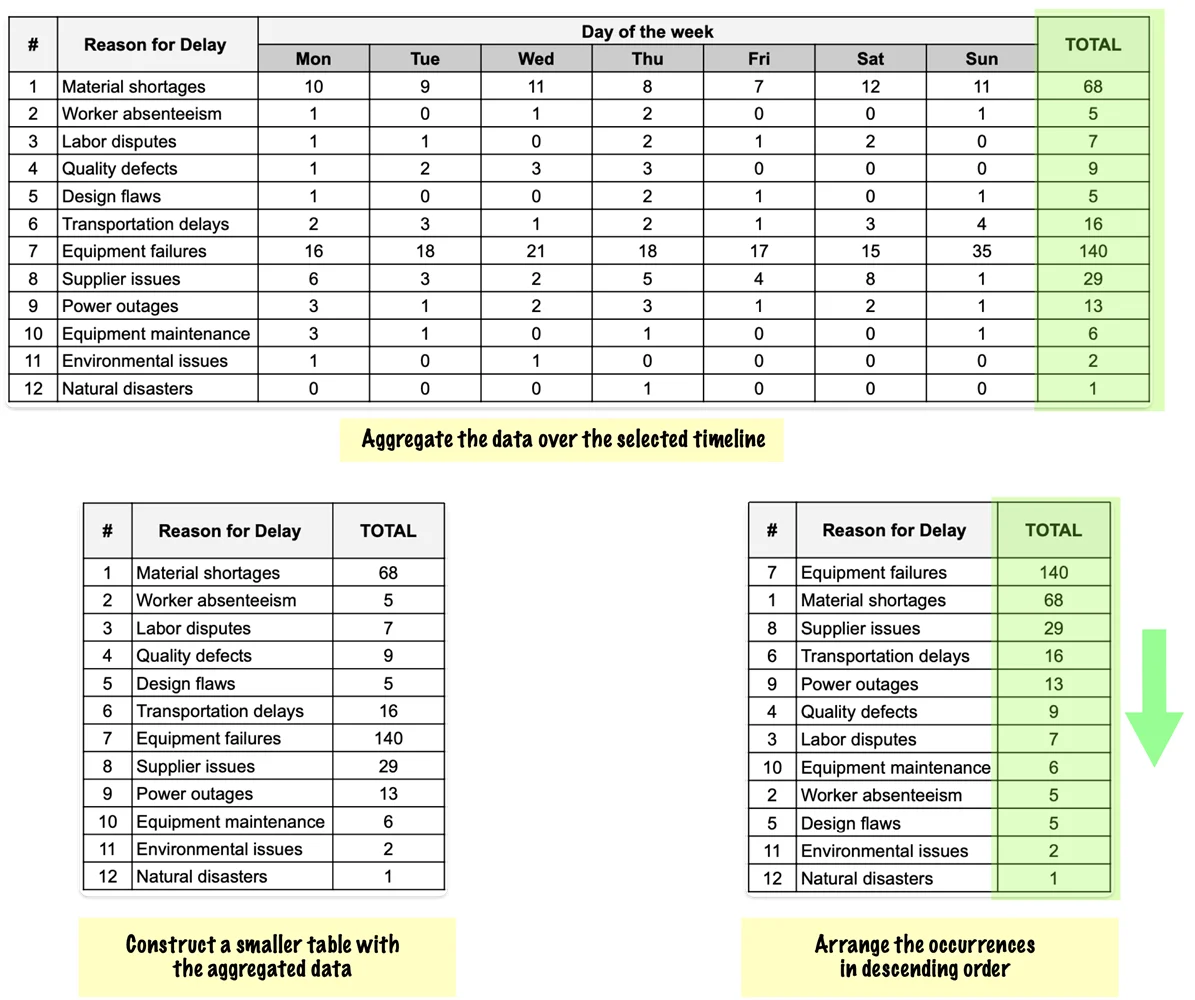
Step 6 – Calculate cumulative percentages
Cumulative percentages can be calculated using any of the spreadsheet applications. In the figure below, cumulative percentages are calculated for the example case using Google Sheets. The formula used can be seen in the image.
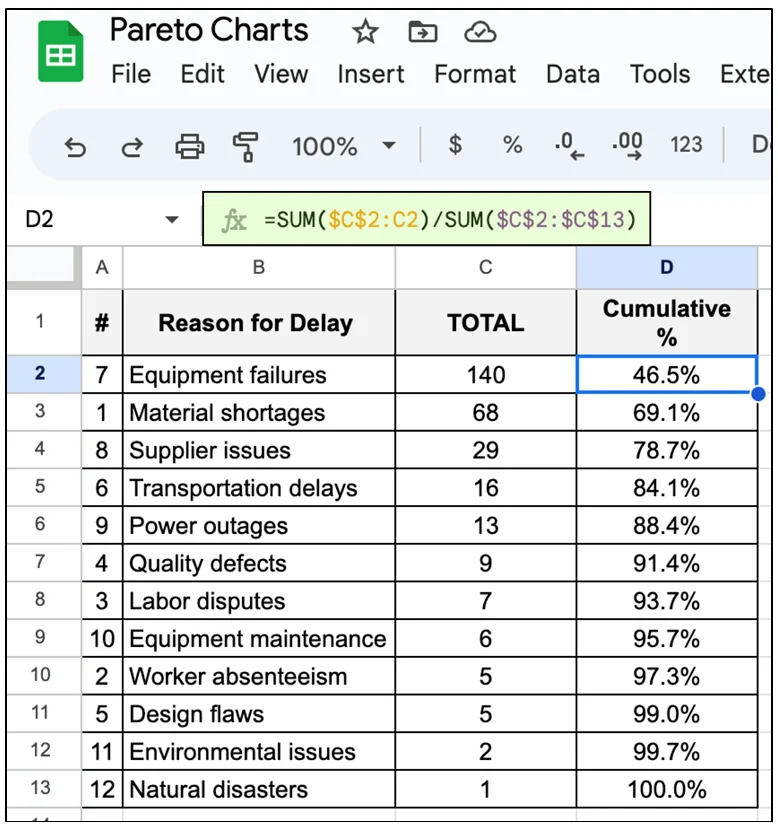
Step 7 – Construct the graph
This step involves graphing the data. A spreadsheet tool can be conveniently used to plot a bar graph (occurrences) and a line graph (commutive percentage).
In Google Sheets, this can be performed using a Combo Chart [4] , with achieves both objectives with the following steps:
- Select the data in the table
- Go to Insert -> Chart
- From the Chat Editor, change the chart type to Combo Chart [4]
- Set X-axis data as a category – In the example case “Reason for Delay”
- Set left Y-axis data as the frequency of occurrence – In the example case “Reason for Delay”
- Set the right Y-axis data as the cumulative percentage
With this, the Pareto chart will be ready and will look as under:
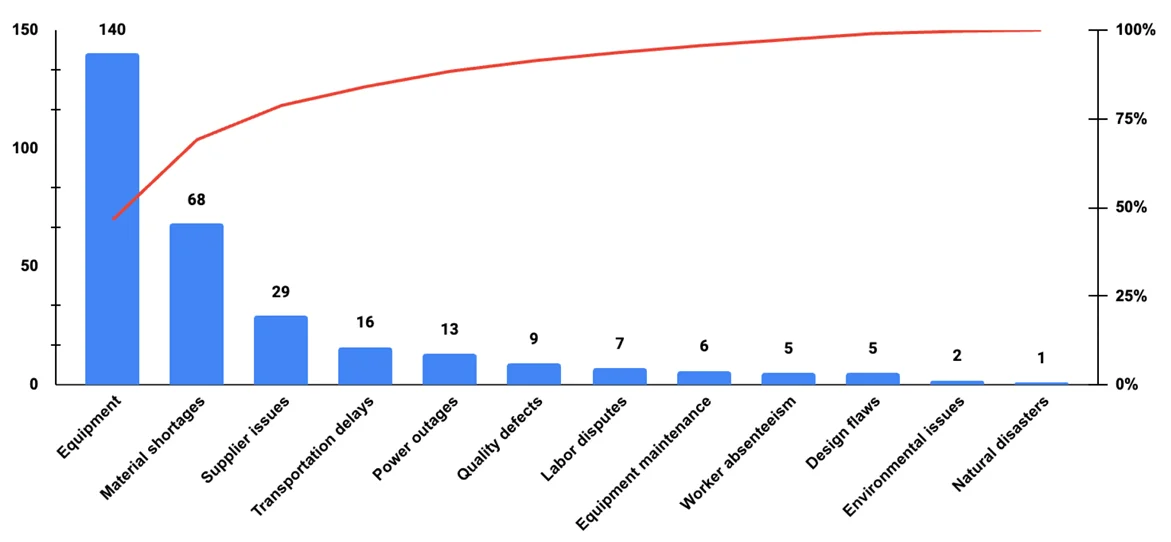
Interpreting a Pareto Chart
Once a Pareto Chart is constructed, clarity emerges on which few out of the many occurrences have the most impact on the results.
The Cumulative percentage curve makes it easier to visually answer the question – “Which 20% of the causes are responsible for 80% of the results?”
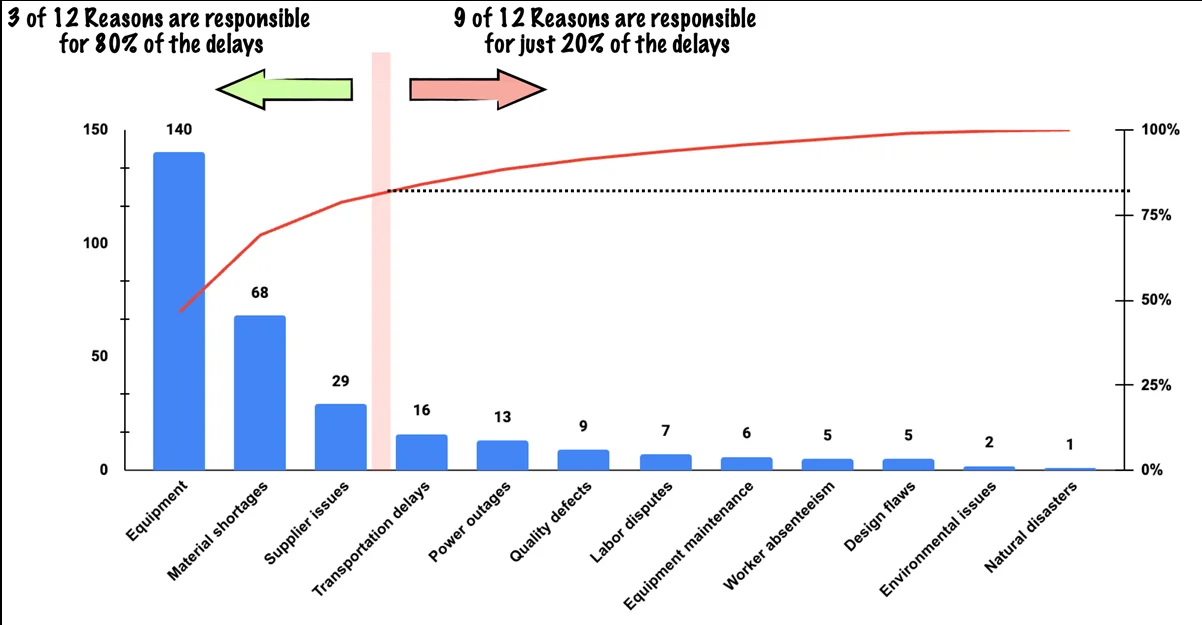
It can be seen from the example case chart above that out of 12 identified causes, just 3 contribute to over 80% of the delays.
With this, the company has a clearer picture of where to focus its efforts and deploy resources.
Limitations of Pareto Analysis
Although Pareto Analysis is a potent visual problem-solving tool, it does have certain limitations, such as:
Data quality – if the data is compromised by errors, inconsistencies, biases, or missing values, results can be misleading or inaccurate, leading to wrong decisions.
Root cause analysis : Pareto analysis helps to identify the frequency and impact of different causes of a problem, but it does not provide any insight into the underlying reasons or mechanisms behind them.
For example, a Pareto chart may show that half of all problems occur in shipping and receiving, but it does not explain why that is the case. To find out the root causes, additional tools such as the 5 Whys or Fishbone diagrams are needed.
Qualitative aspects : Pareto analysis focuses on quantitative data, such as the number of occurrences or the percentage of the impact of different causes. However, it does not account for qualitative aspects, such as the severity, urgency, or complexity of the causes.
For example, a Pareto chart may show that equipment failures are the most frequent cause of delays, but it does not indicate how severe or difficult to fix those failures are. Qualitative aspects may affect the priority and feasibility of addressing different causes.
Future scenarios : Pareto analysis is based on past or present data, which may not reflect future scenarios or changes in parameters.
For example, a Pareto chart may show that supplier issues are a minor cause of delays, but that may change if the supplier changes its policies or prices. Pareto analysis does not account for uncertainty or variability in the data or the environment. Therefore, it should be updated regularly and supplemented with other tools such as scenario analysis or risk analysis.
Varied Applications of Pareto Analysis
Pareto Analysis, with its versatile nature, finds applications across diverse industries and sectors. It aids in identifying critical issues, prioritizing tasks, and allocating resources effectively.
Some examples use cases of Pareto Analysis are:
| Manufacturing | Identifying major quality issues in production |
| Retail | Determining the most frequent customer complaints |
| Healthcare | Identifying the main causes of patient safety incidents |
| Logistics | Analysing the key factors leading to delivery delays |
| Banking | Identifying the most common sources of customer complaints |
| Software | Identifying the top software bugs affecting users |
| Hospitality | Determining the primary reasons for guest dissatisfaction |
| Construction | Analysing the main causes of project delays |
| Telecommunications | Identifying the major reasons for service outages |
| Energy | Determining the primary sources of equipment failures |
| Agriculture | Identifying the main factors affecting crop yield |
| Transportation | Analysing the primary causes of accidents or breakdowns |
| Education | Identifying the major obstacles to student learning outcomes |
| Insurance | Determining the most common causes of claim denials |
| Food Industry | Identifying the main sources of product contamination |
Pareto Analysis can even be applied at an individual level to identify the vital few factors that significantly impact personal productivity, thus aiding in effective time management, focused improvements, and better decision-making.
1. “THE 7 BASIC QUALITY TOOLS FOR PROCESS IMPROVEMENT”. American Society for Quality (ASQ) , https://asq.org/quality-resources/seven-basic-quality-tools . Accessed 29 Jun 2023
2. “Vilfredo Pareto”. Britannica, https://www.britannica.com/biography/Vilfredo-Pareto#ref37223 . Accessed 01 Jul 2023
3. ” Dr. Joseph M. Juran”. Juran.com, https://www.juran.com/about-us/dr-jurans-history/ . Accessed 01 Jul 2023
4. “Combo chart”. Google, https://support.google.com/docs/answer/9142593?sjid=5335603720602667500-AP#combo_chart&zippy=%2Ccombo-chart . Accessed 30 Jun 2023
- PEST & PESTEL Analysis
- SWOT Analysis - How to Do It Properly
- Value Chain Analysis
- SWOT analysis of Amazon 2023
Leave a Comment Cancel reply
Save my name and email in this browser for the next time I comment.
- Join Mind Tools

Pareto Analysis
Choosing the solution with the most impact.

© iStockphoto Mackan65
Use this approach to identify which challenges you should tackle first.
Imagine that you've just been promoted to head of department. You're brimming with ideas about how to improve things, so where do you start?
Ideally, you want to focus on fixing the problems that have the biggest impact. But how do you decide which one to tackle first?
Pareto Analysis is a simple decision-making technique for assessing competing problems and measuring the impact of fixing them. This allows you to focus on solutions that will provide the most benefit.
In this article, we'll show you how to carry out a Pareto Analysis, and explain how to use your findings to prioritize tasks that will deliver the greatest positive impact.
The 80/20 Rule
Pareto Analysis uses the Pareto Principle – also known as the "80/20 Rule" – which was coined by Italian economist, Vilfredo Pareto, in his 1896 book, "Cours d'économie politique." [1]
The Pareto Principle states that 80 percent of a project's benefit comes from 20 percent of the work. Or, conversely, that 80 percent of problems can be traced back to 20 percent of causes. Pareto Analysis identifies the problem areas or tasks that will have the biggest payoff. The tool has several benefits, including:
- Identifying and prioritizing problems and tasks.
- Helping people to organize their workloads more effectively.
- Improving productivity.
- Improving profitability.
The figures 80 and 20 aren't "set in stone," and should be taken as a guide. The Pareto Principle illustrates the lack of symmetry that often occurs between the work you put in and the results you achieve. For example, you might find that 13 percent of work could generate 87 percent of returns. Or that 70 percent of problems could be resolved by dealing with 30 percent of underlying causes.
Pareto Analysis Steps
Now, we'll take a look at how to carry out a Pareto Analysis:
1. Identify and List Problems
Write out a list of all of the problems that you need to resolve. Where possible, gather feedback from clients and team members. This could take the form of customer surveys, formal complaints, or helpdesk logs, for example.
2. Identify the Root Cause of Each Problem
Next, get to the root cause of each problem. Techniques such as the 5 Whys , Cause and Effect Analysis , and Root Cause Analysis are useful tools for this.
3. Score Problems
Now, score each problem that you've listed by importance. The scoring method that you use will depend on the sort of problem that you're trying to resolve.
For example, if you want to improve profits, you could score problems by how much they cost. Or, if you're trying to improve customer satisfaction, you might score them based on the number of complaints that you've received about each.
4. Group Problems Together
Use the root cause analysis that you carried out in Step 3 to group problems together by common cause. For example, if three of your problems are caused by lack of staff, you could put these into the same group.
5. Add up Scores for Each Group
Now, add up the scores for each group that you've identified. The one with the top score should be your highest priority, and the group with the lowest score your lowest priority.
6. Take Action
Finally, it's time to take action! Your highest scoring problem will likely have the biggest payoff once fixed, so start brainstorming ideas on how to solve this one first.
You may find that your lowest-scoring problems aren't worth bothering about, particularly if they are very costly to fix. Use your Pareto Analysis to save your energy and resources for what's important!
While this approach is great for identifying the most important root cause to deal with, it doesn't take into account the cost of doing so. Where costs are significant, you'll need to use techniques such as Cost/Benefit Analysis , and Net Present Value (NPV) and Internal Rate of Return (IRR) to determine which changes you should implement.
Finding This Article Useful?
You can learn another 55 decision-making skills, like this, by joining the Mind Tools Club.

Subscribe to Our Newsletter
Receive new career skills every week, plus get our latest offers and a free downloadable Personal Development Plan workbook.
Pareto Analysis Example
Jack has taken over a failing computer service center, with a host of problems that need resolving. His objective is to increase overall customer satisfaction.
He decides to carry out a Pareto Analysis to assess and prioritize the biggest issues facing the center. He starts by listing these (see the Problem column in the table, below). He then identifies the underlying causes behind each (see the Causes column). Finally, he scores each item by the number of customer complaints that each has received (see the Score column).
| Items | |||
|---|---|---|---|
| 1 | Phones aren't answered quickly enough. | Too few customer service staff. | 15 |
| 2 | Staff seem distracted and under pressure. | Too few customer service staff. | 6 |
| 3 | Engineers aren't well organized and often need to book second visits to bring extra parts. | Poor organization and preparation. | 4 |
| 4 | Engineers don't know what time they'll arrive. This means that customers may have to be in all day for an engineer to visit. | Poor organization and preparation. | 2 |
| 5 | Customer service staff don't always seem to know what they're doing. | Lack of training. | 30 |
| 6 | Customers are often booked in for an appointment with an engineer, only to discover that the issue could have been solved on the phone. | Lack of training. | 21 |
Jack uses his analysis to group problems together by cause, then adds up the scores for each group identified. He is now able to order the main causes affecting the center, starting with the one that has attracted the highest number of customer complaints:
- Lack of training (items 5 and 6) – 51 complaints.
- Too few service center staff (items 1 and 2) – 21 complaints.
- Poor organization and preparation (items 3 and 4) – 6 complaints.
Figure 1. Pareto Analysis of Computer Services Center

As you can see from figure 1, above, the business will benefit most from giving staff more training, so Jack should tackle this first. He could also look to increase the number of staff in the call center. However, it's possible that this won't be necessary – the provision of further training may help to reduce customer complaints and increase staff productivity.
Jack's Pareto Analysis has enabled him to quickly identify the areas of the business that face the biggest challenges, so he can focus his efforts where they are needed most and prioritize issues that will provide the biggest payoff to the business. This will likely save him a great deal of time and money that he might otherwise have spent trying to fix a range of different issues, some of which may have provided very little benefit.
Pareto Analysis is a simple decision-making technique that can help you to assess and prioritize different problems or tasks by comparing the benefit that solving each one will provide.
It's based on the Pareto Principle (also known as the 80/20 Rule) – the idea that 80 percent of problems may be the result of as little as 20 percent of causes.
To use Pareto Analysis, you first need to identify and list the problems that you face, and their root causes. Then, score each problem according to its impact (the scoring system that you use will depend on the types of problems that you are attempting to fix).
Group the problems together by cause and add up scores for each group. This will allow you to identify the problems that will have the biggest benefits if resolved.
Finally, use your findings to prioritize your workload, so that your efforts can be directed toward issues that are the most impactful, and away from problems that are less impactful.
This site teaches you the skills you need for a happy and successful career; and this is just one of many tools and resources that you'll find here at Mind Tools. Subscribe to our free newsletter , or join the Mind Tools Club and really supercharge your career!
Rate this resource
The Mind Tools Club gives you exclusive tips and tools to boost your career - plus a friendly community and support from our career coaches!

Comments (32)
- Over a month ago Michele wrote Hi Hinai, Like you, I also find the 80/20 rule to be very powerful prioritization tool. Michele Mind Tools Team
- Over a month ago Hinai wrote Pareto is very powerful tool to prioritize and identify the highest reason/stage/element and different things... Also it is one of the main tool in six-sigma problem solving methodology.
- Over a month ago Michele wrote Hi Lori, Pareto Analysis is an effective problem solving tool. It identifies which solution will achieve the best result. Thanks for your comment. Michele Mind Tools Team
Please wait...
- Free Activities |
- Free Assessments |
- Free Trainer Skills |
- Free Training Guides |
- Special Offer

How To Complete A Pareto Analysis: A Step-By-Step Guide
A Pareto analysis is a statistical tool used to identify the most important factors in a process or system.
A Pareto analysis helps determine which factors have the greatest cumulative effect and should therefore be prioritized for improvement.
Special Offer – Course Packs Only $10.00 Each
What is a Pareto Analysis?
A Pareto analysis in project management involves ranking factors by their frequency or impact.
The purpose is to identify the “vital few” causes that should be addressed versus the “trivial many”.
This technique helps corporate trainers to focus efforts on the 20% of causes that produce 80% of the problems or defects.
10 Characteristics of a Pareto Analysis
- Focuses on the most impactful factors.
- Shows relative importance of factors.
- Highlights root causes of problems.
- Allows prioritization of issues to address.
- Uses the 80/20 rule as a guideline.
- Relies on data collection and analysis.
- Presents data visually in a bar chart.
- Bars are arranged in descending order of frequency/impact.
- Cumulative line shows combined effect.
- Identifies cut-off for vital few factors.
10 Ways Pareto Analysis is Used at Work
- Identifying product defects and quality issues.
- Diagnosing equipment failures and downtime.
- Reducing customer complaints and returns.
- Improving manufacturing productivity.
- Streamlining processes to reduce costs.
- Prioritizing risk factors and mitigation strategies.
- Focusing improvement and Kaizen events.
- Targeting causes and effects of accidents and injuries.
- Concentrating on most profitable products/services.
- Optimizing marketing and sales efforts.
Features, Benefits and Challenges of Pareto Charts
- Visual bar graph format.
- Bars arranged by descending frequency/impact.
- Highlights vital few factors to focus on.
- Easy to understand graphical format.
- Helps guide data-driven decisions.
- Allows prioritization of issues.
- Identifies cut-off for actionable factors.
Challenges:
- Dependent on accurate data collection.
- Open to bias in classification of factors.
- Does not consider cost/effort to address factors.
- Can oversimplify root cause analysis.
Tips and Techniques for Pareto Analysis
- Clearly define the problem or issue being analyzed.
- Identify all potential factors related to the issue.
- Collect accurate data on the frequency or impact of each factor.
- Carefully categorize the factors for analysis.
- Arrange the factors in descending order of frequency/impact.
- Identify the cut-off for the vital few factors.
- Focus efforts on the top 20% of factors identified.
- Continually collect data to re-analyze and validate results.
- Use Pareto analysis along with other problem-solving tools.
Example Uses of Pareto Analysis at Work
- Analyzing reasons for customer churn to identify key retention strategies.
- Examining equipment downtime to prioritize maintenance efforts.
- Reviewing injury reports to develop targeted safety programs.
- Studying product returns to improve quality processes.
- Evaluating sales data to focus marketing on best-selling items.
- Assessing workflow interruptions to improve processes.
- Reviewing project risks to prioritize mitigation plans.
- Analyzing employee training needs to target key development areas.
Here are the key steps involved in conducting a Pareto analysis:
Define the problem or issue to analyze
- Clearly identify the specific problem, defect, error, or issue that you want to analyze with Pareto.
Identify the potential causes or factors
- Brainstorm all the possible factors, causes, or variables that could be contributing to the problem.
Collect data on the frequency or impact
- Gather data on how often each cause occurs or its relative severity or impact.
Categorize the causes
- Group related causes into distinct categories for analysis. Avoid overlapping categories.
Arrange the categories in descending order
- Sort the categories from most frequent or highest impact to least.
Create a bar chart
- Make a bar chart with the causes on the x-axis and the frequency or impact on the y-axis.
Add a cumulative line
- Add a cumulative percentage line to show the cumulative effect.
Analyze the chart and identify the vital few
- Look for the big drop-offs in frequency/impact to identify the “vital few” causes.
Focus efforts on the vital few
- Target the top 20% of causes for solutions to have the biggest impact.
Continue to measure and monitor results
- Collect ongoing data and redo the Pareto analysis to assess improvements.
Following these steps will allow you to leverage Pareto analysis to focus your attention on the factors that matter most for solving problems.
The key is concentrating efforts on the vital few causes that drive the majority of the impact.
Pareto analysis is a simple but powerful tool that focuses efforts on the most impactful factors to drive improvement. By visually ranking causes, it identifies the vital few drivers to address.
Pareto analysis leads to data-driven decision making, more efficient resource allocation, and better results.
With its focus on leveraging the 80/20 rule, Pareto analysis encourages focusing efforts where they will have the greatest effect.
By continually applying this statistical technique, organizations can consistently identify and prioritize the root causes of problems.
For more suggestions, check out our special offers and corporate training material .
Understanding The 80/20 Rule In Project Management
Practical Examples Of Cause And Effect Analysis In Action
5 Communication Styles: Learn Assertive, Aggressive, Passive, And More!
Team Charter Meeting: A Guide To Bringing Success To Your Team
Guide To Setting Up A Training Room: Maximizing Engagement And Learning
Unlock Productivity With Mind Maps
Understanding the pygmalion effect: impact and implications.

About Your Training Course Materials
The moment you download your training course material and free training resources, they’re ready for whatever you want to use them for. And no matter the courses you choose, they give you everything you’ll need. Whether you’re jumping between delivering courses, creating workshops for online classes, or improving the skills of teams, the training course material brings more focus and saves you time for everything you do .
These training course materials and free training resources leverage the power of editable training content to deliver practical training courses that improve skills and productivity , including corporate training , employee development , and leadership development .
With access to a broad collection of training resources that include focused and editable workbooks, slides, and guides, you can do everything from being ready to deliver a course you need to instantly enhance the range of courses you already provide to exploring new training courses you can offer.
Catherine Fitzgerald (Founder Of Oak Innovation)
Training Course Materials For Everyone
Introducing an entirely new level of training course material. And the most significant breakthrough in training yet for Oak Innovation. Editable content optimises your courses to dramatically increase the learning available — adding a huge effectiveness boost for even the most expert courses.
Thanks to targeted training content , training courses will be more effective than ever. This brings greater scope and efficiency to your courses, enabling them to be more meaningful.
For the first time, Oak Innovation features more editable content . Combined with the expert training guides, it enables you to deliver more courses and allows your courses to provide more interactive workshops.

Course Materials
Get everything that you need., popular today. explore what’s popular right now..

ADD TO CART
52 Courses For Only $10.00 Each

Leadership Training Materials

Problem Solving Skills

Conflict Resolution Skills

Project Management Skills

Corporate Culture

Coaching And Mentoring Skills

Time Management Skills

Management Skills For New Managers

Leadership Influence Skills

Change Leadership Skills

Sales Skills
Do even more with oak innovation premium content and free training resources..

Trusted By Customers Worldwide . Even More Reasons To Shop With Us.

Benefits. Find What Works For You.

Peace of mind.
You get to deliver training courses anytime, anywhere.
Save time and effort.
You'll spend less time creating content.
Instant access.
You get everything you need.
The Best Place To Get Premium And Free Training Resources .
For Trainers Supercharge your training programs with ease! Imagine saving time and money while delivering powerful training sessions that captivate and inspire every time. You can achieve just that with our affordable, content-rich training course materials. Our expertly designed resources ensure smooth delivery, superior understanding, and long-lasting retention.
Wave goodbye to the tedious process of researching and developing training course materials from scratch. Our comprehensive materials eliminate costly trial-and-error and guarantee measurable success from the start.

For Educators Dive into our all-inclusive training courses or amplify your existing training materials with our versatile modules. Infuse your sessions with innovative models and engaging concepts that are proven to work, making your training effective and thrilling.
Engaging delegates can be challenging, even for seasoned trainers. Our materials are crafted to boost interaction, prevent boredom, and enhance your confidence, ensuring every session is seamless and dynamic.
With our expertly designed course materials, you can eliminate training stress and maximize your return on investment. Deliver exceptional training experiences and watch your team soar to new heights!
For People Managers Unleash your leadership potential and ignite your team’s professional growth! As a leader, your mission is to develop and support your team. Now, it’s time to discover the trainer within you and take charge of your team’s advancement with our dynamic training course material packages, training materials, and free training resources.
Our meticulously structured and brilliantly organized training course material transforms anyone with any presentation skills into a confident and effective trainer. Each package is infused with helpful tips and insights at critical stages to keep the momentum high and ensure every training session is impactful.

Customize Your Training Package To Fit Your Needs! Transform your training sessions with our fully customizable training course materials. Tailor your content to meet your training goals and your audience's needs. Rebrand the materials with your logo, ensuring your unique voice without the hassle of creating training content from scratch.
Add Other Courses Enhance your training programs with individual standalone training packs. Focus on specific topics or seamlessly integrate your existing course materials to create bespoke learning courses that meet your requirements.
Supercharge Team Engagement Transform team meetings into energetic, learning-packed sessions with our professional training course materials.
Versatile Learning Opportunities Seamlessly weave bite-sized learning into team meetings and collaborations to spotlight essential skills and concepts.

Effortless Implementation Our training course materials enable smooth, on-the-go workplace learning, ensuring you and your team unlock your full potential.
Seize Control Revolutionize your team’s development and training sessions with our expertly crafted training course material. Empower your team and soar to new heights of excellence together!
Engage And Grow With Activities, Exercises, And Games Our training packages contain easy-to-follow activities, interactive exercises, and engaging training games. These free training resources address key learning points and offer creative ideas to enrich your training course materials, ensuring a dynamic and immersive learning environment.
Why Choose Us? Unlike generic, off-the-shelf training providers, our materials prioritize practicality over everything. Our soft skills topics are meticulously developed to foster specific skills and mindsets through hands-on learning and innovative training models.

Proven Success For All Trainers Designed for people managers, trainers and trainees alike, our materials have been tested in real-world settings. Suitable for everyone from line staff and first-time instructors to senior management, our courses ensure successful delivery and impactful learning.
Take Your Training To The Next Level! Choose our customizable, engaging, and expertly crafted training materials to deliver unparalleled training experiences and empower your team with the skills they need to be successful.

Course Materials Library
Unlimited access to all our course materials..
- RCA 101 – 5-Why Analysis (Free Training)
- RCA201 – Basic Failure Analysis
- RCA 301 – PROACT® RCA Certification
- RCA401 – RCA Train The Trainer
- Other Trainings
- 5 Whys Root Cause Analysis Template
- RCA Template
- Chronic Failure Calculator
7 Powerful Root Cause Analysis Tools and Techniques

By Sebastian Traeger
Updated: April 21, 2024
Reading Time: 5 minutes
1. The Ishikawa Fishbone Diagram (IFD)
2. pareto chart, 4. failure mode and effects analysis (fmea), 5. proact® rca method, 6. affinity diagram, 7. fault tree analysis (fta).
With over two decades in business – spanning strategy consulting, tech startups and executive leadership – I am committed to helping your organization thrive. At Reliability, we’re on a mission to help enhance strategic decision-making and operational excellence through the power of Root Cause Analysis, and I hope this article will be helpful! Our goal is to help you better understand these root cause analysis techniques by offering insights and practical tips based on years of experience. Whether you’re new to doing RCAs or a seasoned pro, we trust this will be useful in your journey towards working hard and working smart.
Root Cause Analysis (RCA) shines as a pivotal process that helps organizations identify the underlying reasons for problems, failures, and inefficiencies. The goal is simple: find the cause, fix it, and prevent it from happening again. But the process can be complex, and that’s where various RCA techniques come into play.
Let’s dive into seven widely utilized RCA techniques and explore how they can empower your team’s problem-solving efforts.
Named after Japanese quality control statistician Kaoru Ishikawa, the Fishbone Diagram is a visual tool designed for group discussions. It helps teams track back to the potential root causes of a problem by sorting and relating them in a structured way. The diagram resembles a fishbone, with the problem at the head and the causes branching off the spine like bones. This visualization aids in categorizing potential causes and studying their complex interrelationships.
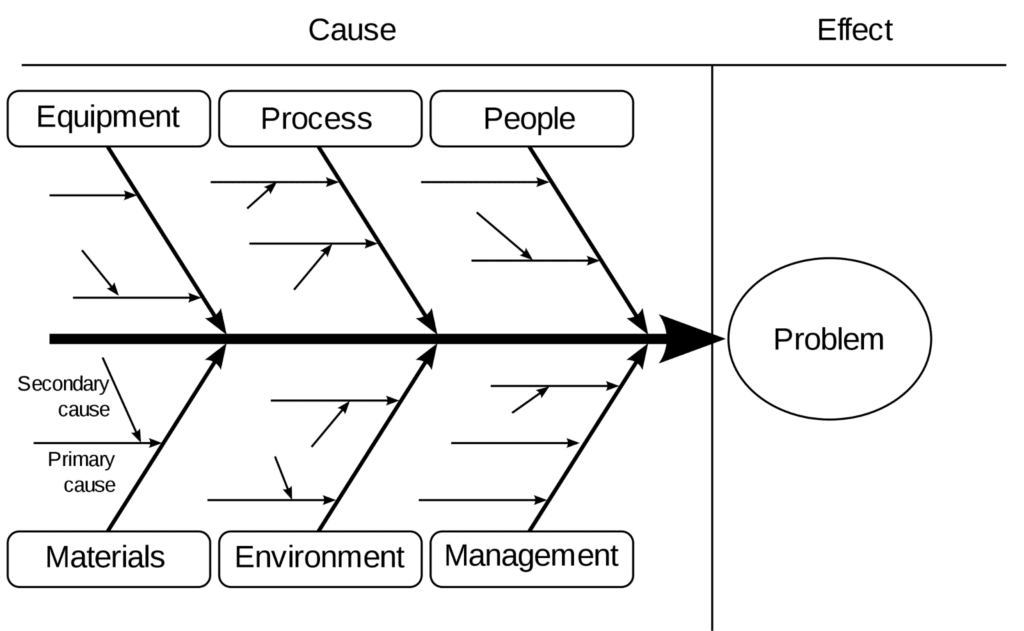
The Pareto Chart, rooted in the Pareto Principle, is a visual tool that helps teams identify the most significant factors in a set of data. In most situations, 80% of problems can be traced back to about 20% of causes. By arranging bar heights from tallest to shortest, teams can prioritize the most significant factors and focus their improvement efforts where they can have the most impact.
The 5 Whys method is the epitome of simplicity in getting to the bottom of a problem. By repeatedly asking ‘why’ (typically five times), you can delve beneath the surface-level symptoms of a problem to unearth the root cause. This iterative interrogation is most effective when answers are grounded in factual evidence.

When prevention is better than cure, Failure Mode and Effects Analysis (FMEA) steps in. This systematic, proactive method helps teams identify where and how a process might fail. By predicting and examining potential process breakdowns and their impacts, teams can rectify issues before they turn into failures. FMEA is a three-step process that involves identifying potential failures, analyzing their effects, and prioritizing them based on severity, occurrence, and detection ratings.

The PROACT ® RCA technique is a robust process designed to drive significant business results. Notably used to identify and analyze ‘chronic failures,’ which can otherwise be overlooked, this method is defined by its name:
PReserving Evidence and Acquiring Data: Initial evidence collection step based on the 5-P’s – Parts, Position, People, Paper, and Paradigms.
Order Your Analysis Team and Assign Resources: Assembling an unbiased team to analyze a specific failure.
Analyze the Event: Reconstructing the event using a logic tree to identify Physical, Human, and Latent Root Causes.
Communicate Findings and Recommendations: Developing and implementing solutions to prevent root cause recurrence.
Track and Measure Impact for Bottom Line Results: Tracking the success of implemented recommendations and correlating the RCA’s effectiveness with ROI.
PROACT® RCA excels in mitigating risk, optimizing cost, and boosting performance, making it a valuable addition to any RCA toolkit.
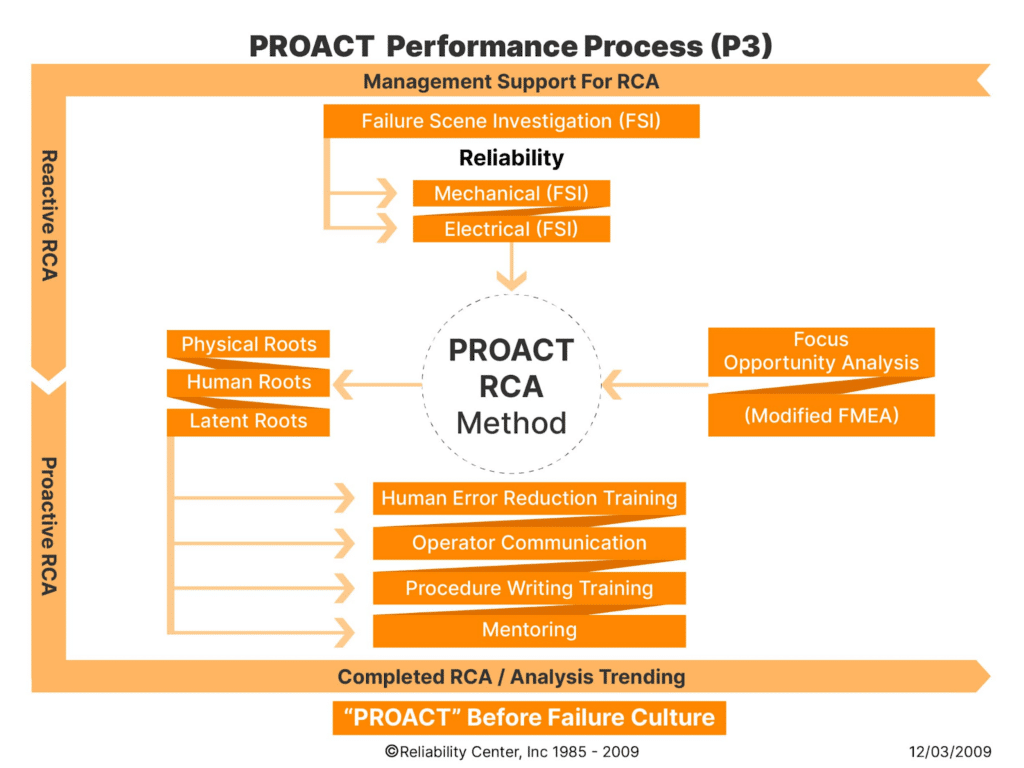
The Affinity Diagram is a powerful tool for dealing with large amounts of data. It organizes a broad range of information into groups based on their natural relationships, creating a clear, visual representation of complex situations. It’s particularly beneficial for condensing feedback from brainstorming sessions into manageable categories, fostering a better understanding of the broader picture.
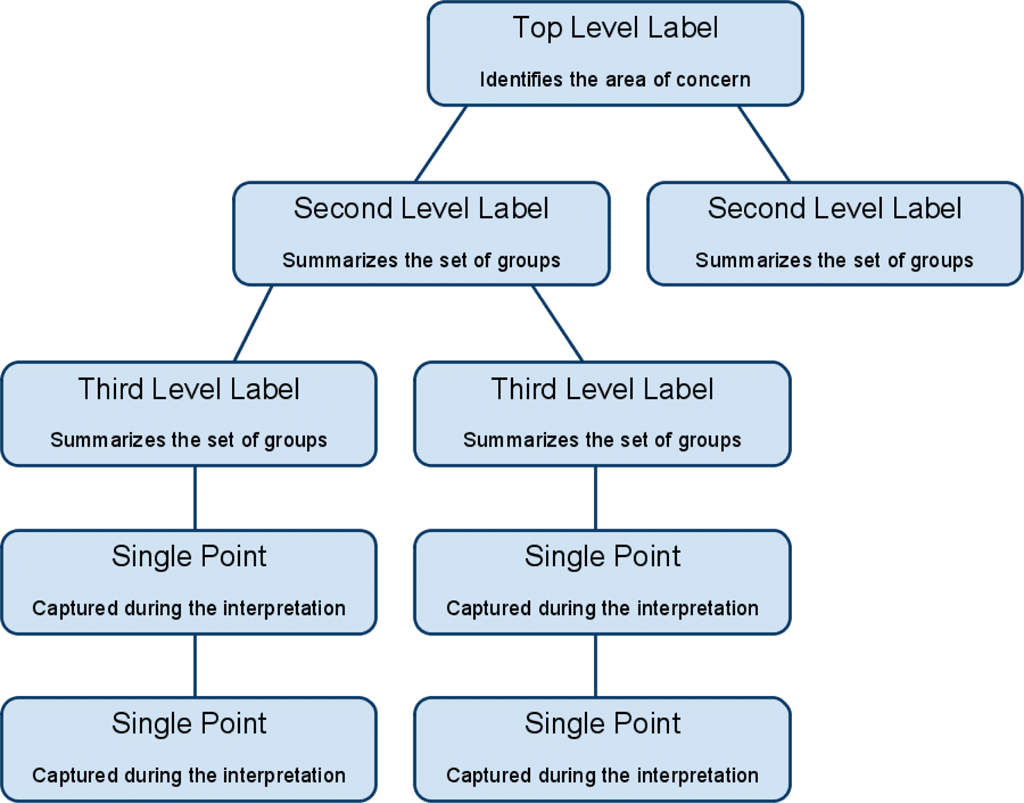
Fault Tree Analysis (FTA) is a top-down, deductive failure analysis that explores the causes of faults or problems. It involves graphically mapping multiple causal chains to track back to possible root causes, using a tree-like diagram. FTA is particularly useful in high-risk industries, such as aerospace and nuclear power, where preventing failure is crucial.

Each RCA technique provides a unique approach for viewing and understanding problems, helping you pinpoint the root cause more effectively. The key is to understand when and how to use each tool, which can significantly enhance your team’s problem-solving capabilities.
Power up your RCA analysis with our EasyRCA and revolutionize your problem-solving process. Start Your Free Trial.
| Ishikawa Fishbone Diagram | Visual representation of complex relationships | When there are many possible causes to a problem |
| Pareto Chart | Prioritizes problem areas based on impact | When trying to identify the most significant causes |
| 5 Whys | Simple, iterative problem-solving technique | When the problem is straightforward and the solution is not immediately apparent |
| FMEA | Proactive, preventative approach | When addressing complex processes that could lead to serious consequences if failed |
| PROACT® RCA Method | Comprehensive, result-driven approach | When dealing with chronic, recurrent failures |
| Affinity Diagram | Groups large data into manageable categories | When trying to find patterns and connections in large amounts of data |
| Fault Tree Analysis (FTA) | Visual mapping of causal chains | When working in high-risk industries where prevention is crucial |
In conclusion, the techniques presented offer a diverse set of tools to help organizations address problems and inefficiencies effectively. From visual representations like the Ishikawa Fishbone Diagram and Pareto Chart to more proactive approaches such as the 5 Whys and Failure Mode and Effects Analysis (FMEA), each technique provides a unique perspective on identifying and mitigating root causes.
The PROACT® RCA Method stands out for its comprehensive process, particularly suited for chronic failures. Additionally, the Affinity Diagram and Fault Tree Analysis (FTA) contribute valuable insights by organizing data and exploring causal chains, respectively. Leveraging these techniques strategically enhances a team’s problem-solving capabilities, enabling them to make informed decisions and drive continuous improvement.
I hope you found these 7 techniques insightful and actionable! Stay tuned for more thought-provoking articles as we continue to share our knowledge. Success is rooted in a thorough understanding and consistent application, and we hope this article was a step in unlocking the full potential of Root Cause Analysis for your organization. Reliability runs initiatives such as an online learning center focused on the proprietary PROACT® RCA methodology and EasyRCA.com software. For additional resources, visit our Reliability Resources .
- Root Cause Analysis /
Recent Posts
Post-Incident Analysis for Enhanced Reliability
How To Conduct Incident Analysis?
The Role of Artificial Intelligence in Reliability Engineering
Ultimate Guide to Swiss Cheese Model and Its Applications
Root Cause Analysis Software
Our RCA software mobilizes your team to complete standardized RCA’s while giving you the enterprise-wide data you need to increase asset performance and keep your team safe.
Root Cause Analysis Training
[email protected]
Tel: 1 (800) 457-0645
Share article with friends:
Pareto Principle (The 80-20 Rule): Examples & More
Olivia Guy-Evans, MSc
Associate Editor for Simply Psychology
BSc (Hons) Psychology, MSc Psychology of Education
Olivia Guy-Evans is a writer and associate editor for Simply Psychology. She has previously worked in healthcare and educational sectors.
Learn about our Editorial Process
Saul McLeod, PhD
Editor-in-Chief for Simply Psychology
BSc (Hons) Psychology, MRes, PhD, University of Manchester
Saul McLeod, PhD., is a qualified psychology teacher with over 18 years of experience in further and higher education. He has been published in peer-reviewed journals, including the Journal of Clinical Psychology.
On This Page:
Key Takeaways
- The Pareto Principle, also known as the “80/20” rule, states that for many events, roughly 80% of effects come from 20% of the causes.
- The Pareto Principle can be applied to a variety of situations, including business, economics, and quality control.
- The Pareto principle is named after economist Vilfredo Pareto, who discovered this pattern in his studies of wealth distribution in societies.
- The Pareto Principle is often touted as a powerful tool for productivity and business management; however, it has received a great amount of criticism for likely being more the result of statistical manipulation than a “universal law.”
- If not used correctly, the Pareto Principle can lead to an excessive focus on short-term gains over long-term planning and stability.
- When used correctly, the Pareto Principle can help prioritize tasks, optimize resources, and improve overall efficiency. It provides a useful framework for understanding complex systems and identifying key areas for improvement.

What is the Pareto Principle?
The Pareto Principle, also known as the 80-20 rule, is a concept that many have adopted for their life and time management. It is the idea that 20% of the effort, or input, leads to 80% of the results or output. The point of this principle is to recognize that most things in life are not distributed evenly.
The key to the Pareto Principle is to identify that around 20% of one’s actions on the most productive tasks lead to the most success. This principle requires and enables us to spot the few important things that are happening and ignore the mass of unimportant things.
Essentially, if we spend a short amount of time on what is really important, this will yield greater results than focusing on as many things as possible.
The Pareto Principle is a concept that has shown to be powerful when applied to many areas of life, including in business, relationships, learning, and marketing, to name a few.
For example, in any retail organization, the Pareto Principle states that 80% of the sales will be accounted for by 20% of the customers.
What is the idea behind the Pareto Principle?
The Pareto Principle was named after Italian economist Vilfredo Pareto who, in the late 19th Century observed that 80% of the wealth in Italy was owned by 20% of the people.
When testing this principle, he also found that 80% of the wealth and land in almost all countries was controlled by 20% of the people (Pareto, 1906). He also found this to be true when he observed his garden, finding that 20% of the pea pods yielded 80% of the peas.
In the early 1950s, the psychologist Joseph Juran expanded on this idea, arguing that it could also be applied to management and even as a “universal principle”.
He believed that 80% of a company’s revenue would come from 20% of its customers, and that 80% of production problems would be caused by only 20% of all possible sources of error.
Juran (2005) also coined the terms “vital few” and “useful many” or “trivial many” to refer to those few contributions that result in the bulk of the effect, and the many that have only a small impact.
The term Pareto Principle was not coined by Pareto, but by Dr Joseph Juran in the 1940s. Juran found that through applying Pareto’s observations to his field of operations management, he could help businesses improve their production by noticing that 80% of the production problems were caused by 20% of the production methods.
Through this observation, Juran could focus on reducing the 20% of problems to increase production quality. This strategy he named the Pareto Principle while also noting that one should focus on the ‘vital few’ and ignore the ‘trivial many’ to have the greatest success.
Over time, many other organizations and individuals have further developed and refined this principle, leading to its widespread use today in fields from business to agriculture to healthcare.
While there is still some debate over exactly how the Pareto Principle should be applied in different situations, it remains a popular and powerful tool for understanding complex systems.
Whether someone is trying to understand why their sales numbers are not meeting their targets or trying to optimize an agricultural system for maximum yield, understanding and applying the Pareto Principle can often help them identify key areas for improvement.
Some examples of the Pareto Principle could involve:
- 80% of profits come from 20 % of the products or services a company sells.
- Fixing the top 20 % of the most reported bugs in a software program also eliminates 80 % of related errors and crashes.
- Wearing 20 % of one’s clothes 80 % of the time
Time management
Time management is the most common use of the Pareto Principle. Many people tend to thinly spread out their time instead of focusing on the most important task.
Likewise, there is the idea that people must work excessively long hours to produce good outcomes. This type of thinking can create an unequal work-life balance, resulting in burnout and overall decreased productivity.
With the Pareto Principle, you can save time on work tasks and get more done in a shorter span of time.
For instance, you could spend some time at the start of the week planning out what you are going to focus on during the workdays, usually the most important tasks.
While this may feel like a waste of time, in the long run it can help you to focus and cut down work time.
You may find that you have more time to devote to other activities outside of work such as personal development, relaxation, mental health, and building relationships.
Relationships
With relationships, many people may want to have as many friends as possible, but they find they become overwhelmed with trying to maintain these relationships or find they don’t have high quality friendships with anyone.
Using the Pareto Principle, you can look at the friends you have and work out how much time you spend with each of them compared to the amount of value they give you.
Through this analysis, determine which 20% of your relationships are valuable and supportive of you. According to the Pareto Principle, if you spend 80% of your time socializing with this 20%, your personal gains will be greater.
In a relationship with a partner, it may be helpful to consider that 80% of the problems faced in the relationship are likely caused by 20% of the couple’s actions or behaviors.
The Pareto Principle can be used to identify the root causes of your conflicts with your partner, communicate about them, and focus on improving them together.
Goal setting
Often, people have never-ending to-do lists or they end up doing the least important tasks on their lists first, then find they are not motivated to complete the more important tasks.
A way to use the Pareto Principle is to write down all your goals you want to complete on a given day. Ask yourself, if you could only accomplish one of the goals on that list today, which one would have the greatest positive impact on your life?
It may be helpful to think of the consequences that can come as a result of not completing that task today. Next, pick the second most important goal, and so on.
What you will find is that you will have determined the most important 20% of your goals that will help you the most. You can then ensure you focus on completing this 20% before moving onto any other goals.
Problem-solving
The Pareto Principle can be used to help you make the best decision in problem-solving circumstances.
To help to prioritize solutions, you can follow the below steps:
Identify the problems that you are trying to find a solution to.
Identify what the causes of these problems are.
Categorize your problems into similar groups based on which ones have similar root causes. This can help you decide if one solution can resolve multiple problems.
Assign a value to each of the problems based on their impact if they were or were not resolved. You could rate them between 1-10 if this helps.
Develop a plan to focus on the top 20% of the problems that will result in 80% of the results.
Social Interactions
The Pareto Principle can also be seen in everyday situations, such as work meetings. , imagine that a work meeting has 10 attendees.
It is likely that only a few people will do most of the talking, while the rest will listen or say very little.
In this case, the 80:20 rule applies, with 80% of the talking being done by 20% of the people in the room.
Similarly, this principle can also be applied to decision-making.
In any group decision-making situation, it is often true that 80% of the decisions are made by 20% of the people involved.
This is because some people are naturally more vocal and opinionated than others, and their opinions tend to hold more sway.
The Pareto Principle is often used as a way to help students focus on their studying.
The idea is that if a student can identify the 20% of material that will be on the test, they can focus their studying on that 20% and still get a good grade.
This principle can be applied in a number of ways. For example, a student might look at their past tests and quizzes to see which topics were covered most often.
They could also ask their teacher or classmates what they think will be on the upcoming test. Once the student has a list of topics, they can start to focus their studying on those areas.
The Pareto Principle can also be applied to individual questions on a test.
For example, if a multiple choice question has four possible answers, it might be worth spending more time studying that question if you have identified that one of the answers is correct 80% of the time.
Overall, the key to implementing the Pareto Principle successfully involves taking an analytical approach and focusing on those topics or questions that are most likely to matter.
This can help students study more efficiently and improve their performance as a result.
The effectiveness of this principle has been widely studied, and there is some evidence that it can be quite effective in helping students prepare for tests.
For example, a 2014 study found that when students used a computer program based on the Pareto Principle to choose which material they would study, they performed better on a test compared to students who did not use the program.
Given these results, it seems likely that the Pareto Principle can help students improve their performance in school by helping them focus their studying on key areas of the curriculum.
By identifying and understanding the material that is most important to learn, students can spend less time reviewing concepts they already know and more time on those that need improvement (Dunnford, Su, & Tamang, 2014).
Income Inequality
Pareto’s initial 1906 observation that 80% of Italy’s land was controlled by 20% of people mirrors today’s estimate that 20% of the world’s population controls 82.7% of wealth.
This phenomenon, known as income inequality, is a major concern for policy makers and social scientists around the world.
One potential explanation for this disparity is that the wealthy 20% are better able to take advantage of opportunities and resources than their less fortunate counterparts.
For example, they may have greater access to education or better job prospects due to family connections or networks of influence.
In addition, those in the top quintile may be more likely to engage in tax avoidance strategies and other financial maneuvers that help them accrue even more wealth (Bommier & Zuber, 2012).
Another possible factor influencing income inequality is structural changes in the economy over time.
For example, technological advances such as automation and artificial intelligence have led to an increased demand for highly-skilled workers who can operate these new technologies, while displacing low-skilled workers who are unable to keep up with the pace of change.
As a result, those with higher education levels and skills tend to enjoy higher wages and greater economic stability than those without.
As this gap widens, those in the top quintile accumulate a greater and greater percentage of the world’s net wealth (Bommier & Zuber, 2012).
Implementing the Pareto Principle
There are many ways in which you can apply the Pareto Principle to any situation. Success can be found in many aspects of life if you plan and apply the 80-20 rule.
It often begins with having a goal and living with feeling limited. To live without limits, try applying the three Cs: clarity, competence, and concentration, to any situation.
Having clarity means that you have a clear idea of who you are, what you want and where you are going.
You ensure you write down your goals and make plans to achieve them, with the more progress made, the greater confidence you will gain. Having this clarity can help you to remain focused on your goals.
Many people try to become competent at many things at once but because they are spreading themselves so thinly, they may never become highly skilled at any one thing.
Applying competence means that you can become skilful in the key areas of your choice through applying the Pareto Principle to a few select skills.
You can become outstanding in the 20% of tasks that contribute to 80% of your results.
Concentration
This entails having the self-discipline to stay focused on one task until completion. Persevering, without distraction, towards accomplishing your goals can help to live a life without limitations.
You can help to concentrate by abandoning the activities that are taking up too much of your time and are not valuable.
As you focus on doing what you are passionate about and become skilled in those areas, you can make a big difference in your life. You begin to think in terms of possibilities rather than impossibilities.
Understand your constraints
With any goal that you have, there is always likely to be a constraint which has potential to stop you being productive.
Spend some time considering what is standing between you and your goals – is it your environment or skill level? Or are you making excuses?
Once you identify what your constraints are, you can exert energy into alleviating this constraint. When you have done this, you can maximise the time where you are actually going to engage in a high priority task and the process should be a lot smoother.
Re-organize your to-do list
While to-do lists are definitely useful, try not to let anything and everything onto the list. Be more ruthless with what is higher priority and what doesn’t need to be on the list.
An endless list can feel overwhelming and is likely to be unachievable.
Determine what items need to be completed that day or week and take off items which can wait until a later time.
Prioritize tasks based on their perceived impact.
This can be measured by estimating how much of the overall goal each task will contribute to, as well as how long it is likely to take (Backhaus, 1980).
Perhaps put these items on a separate list titled ‘low priority’ and reach for this list when you have spent enough time on your high priority tasks and when your motivation is lower.
The next step involves focusing on completing the most impactful tasks first, using techniques like time boxing and focusing on one thing at a time (known as “single-tasking”).
This may require initially setting aside less important tasks, which can be frustrating. However, in the long run, this approach is more likely to lead to successful completion of goals and a better use of time (Backhaus, 1980).
Specifically, to the workplace, the Pareto Principle can be used to increase effective leadership. Leaders can prioritize tasks to ensure their team is working most effectively and staying focused on specific initiatives.
Resources such as time, money, supplies, and efforts are less likely to be wasted in areas where it will have least output.
The Pareto Principle can also help to increase profits since workplace leaders can reassign high-performing employers to the biggest accounts or high-priority tasks and boost their skills through training to increase revenue.
The Pareto Principle can also highlight the 20% of products or services that generate 80% of revenue, so these can be focused on and offered more.
In general, some other advantages of using the Pareto Principle include:
Greater productivity
Efficient use of energy
Better problem-solving skills
Improved decision-making skills
Being able to create the maximum amount of impact with least amount of work
Increased self-confidence
Clearer prioritizes
Can portion work into manageable segments
More time to do the things you enjoy
Less likely to feel burnt out
Can be informed on what needs fixing
The Pareto Principle is not a mathematical law, rather it is an observation. This means that it is not true for every case and shouldn’t be taken as absolute.
Variations of the Pareto Principle can occur such as 30% of employers being responsible for 60% of sales, so the 80-20 rule does not always apply.
A common misconception of the Pareto Principle is that with 20% effort, you can gain 80% results, which is not necessarily the case.
The percentages do not refer to the effort applied, but the causes and consequences you are working on. To achieve 80% results, you still need to put in 100% effort into that 20% focus.
The Pareto Principle can be easy to misinterpret. Some may think that they should focus all their attention on the 20% that is high priority and forget about the rest of their tasks.
However, you shouldn’t neglect the 80% of smaller tasks such as responding to work emails, as this can build up and become a bigger problem overtime.
The challenge is to find the right balance when it comes to the Pareto Principle. Perhaps you can do the least important tasks at times when you feel less productive to do priority tasks.
Lastly, the Pareto Principle can only apply to the past. Meaning, it reflects data from the past and can be useful for planning what you could do, but it will not make predictions for the future.
Circumstances can change and evolve meaning that the Pareto Principle may not always be useful for designing future strategies.
Critics have also pointed out that the principle can lead to an overemphasis on a small number of critical factors at the expense of others.
In business, for example, this might mean focusing too much on improving sales from existing customers rather than exploring new markets or products.
Others argue that the Pareto Principle reinforces inequalities by giving more power and influence to those who already hold a disproportionate share of wealth or influence (Backhaus, 1980).
Time Management Tactics
Track your time.
A useful technique to establish where all your time is being spent is to log everything you do on a typical day or week.
Go about your time as normal and log everything you do without judgement. After doing this, you may find that you have a lot of gaps where nothing gets done or you spend a lot of energy on tasks that are of low value.
Look at how many hours in your day are dedicated towards tasks that are going to help you achieve your goals. You may find that you spend a short amount of time on achieving your goals, but you often get distracted by other tasks.
Having a log of your time is valuable data you can use to make better use of your day or week.
Start with the most important tasks first
Once you have identified what you should spend 20% of your time on, you can then ensure that you get this done at a time of day when you find you are most productive.
For many people, their most productive time is first thing in the morning. Instead of spending the first part of your day doing low value tasks such as answering emails, it may be more helpful to dedicate this time to your high priority task.
You should find that if you start with the hardest but most rewarding task in the morning, everything else in your day is easier to complete.
Eliminate distractions
With all the distractions or interruptions, the working day can end before you know it. While this may be of benefit to people, you might find that you have finished the day having not been productive at all.
Try to decipher what your main distractions are, whether they be your phone or other non-work-related tasks and put these aside.
This does not only need to be put to one side during your 20%, but for the whole of your workday, if possible, so the whole day goes smoothly without interruption.
To help you manage the time you want to work on a high priority task, enter a block of time in your calendar that you will use to dedicate only to this task.
This is called timeboxing. This box of time can be treated like a scheduled event which must be stuck to and not postponed or canceled.
You can proactively decide how much time will be spent on the task and you can schedule it for a time of day when you feel the most motivated.
You should put aside any distractions during this timebox and dedicate the time only for deep work on the most important tasks.
This can help people who find they procrastinate a lot. It may help you to stop worrying about getting the difficult task done if you know that you have a dedicated timebox coming up in which you can complete the task.
96-minute rule
A similar time management technique to timeboxing is the 96-minute rule. A typical workday is around 8 hours, so 20% of this workday is 96 minutes, however you can adjust the times if the length of your workday differs.
Using the Pareto Principle, you can spend 20% of your workday focused on a high value task. During this time, you remove distractions and put in high effort and intentional focus for the whole of that 20%.
The idea is that you will have completed around 80% of what you wanted to achieve that day in just 20% of the time.
This does not necessarily mean you should end your workday after 96 minutes, but that you can use the remainder of your time on the smaller, less important tasks that you want to get done.
Further Information
Piantadosi, S., Byar, D. P., & Green, S. B. (1988). Dunford, R., Su, Q., & Tamang, E. (2014). The pareto principle.
Brynjolfsson, E., Hu, Y., & Simester, D. (2011). Goodbye pareto principle, hello long tail: The effect of search costs on the concentration of product sales. Management Science, 57(8), 1373-1386.
Backhaus, J. (1980). The pareto principle. Analyse & Kritik, 2 (2), 146-171.
Bommier, A., & Zuber, S. (2012). The Pareto principle of optimal inequality. International Economic Review, 53 (2), 593-608.
Dunford, R., Su, Q., & Tamang, E. (2014). The pareto principle.
Juran, J., Taylor, F., Shewhart, W., Deming, E., Crosby, P., Ishikawa, K., … & Goldratt, E. (2005). Quality control. Joseph M. Juran: Critical Evaluations in Business and Management , 50.
Pareto, V. (1906). L”ofelimità nei cicli non chiusi. Giornale degli economisti , 33, 15-30.
Mastering Pareto Analysis: Problem Solving & Process Optimization Guide

| Key Term | Definition | Application or Example |
|---|---|---|
| Pareto Analysis | A decision-making technique to identify the most critical factors, issues, or problems. | Used in manufacturing, Pareto Analysis could identify the primary causes of defects. |
| Pareto Principle | The 80/20 rule states that approximately 80% of effects result from 20% of causes. | In sales, it is often observed that 80% of revenue is generated by 20% of customers. |
| Pareto Chart | A graphical representation of the distribution of problems and their cumulative percentage impact. | In a software company, a Pareto Chart could visualize bug categories and frequency. |
| Data Collection | Gathering relevant data to quantify the impact or frequency of identified issues. | A software company collects data on the frequency of customer-reported bugs. |
| Issue Ranking | Arranging issues based on their magnitude, impact, or frequency. | The software company ranks bug categories by the number of times they have been reported. |
| Issue Analysis | Using a Pareto Chart to identify the most significant problems and prioritize efforts accordingly. | The company uses the chart to determine that User Interface and Performance bugs are the primary concerns. |
| Solution Implementation | Addressing prioritized issues and implementing solutions. | The company addresses User Interface and Performance bugs to reduce the number of customer complaints. |
| Progress Monitoring | Continuously monitoring the progress and impact of implemented solutions. | The company keeps a regular check on the number of customer-reported bugs after solutions are implemented. |
| Root Cause Pareto Analysis | Identifying the underlying causes of the problems or issues. | Once primary issues are identified, the company works to understand their root causes for more permanent solutions. |
| Resource Allocation | Assigning available resources to address the most impactful problems. | The company allocates developers to address the most prevalent bug categories. |
Pareto Analysis is a powerful problem-solving tool and process improvement technique that helps businesses and organizations identify the most significant problems and prioritize their efforts for maximum impact. This academic blog post will explore the meaning, application, and benefits of Pareto Analysis and delve into various examples and case studies from different industries. As a result, organizations can achieve more efficient and effective outcomes by leveraging the Pareto Principle, also known as the 80/20 rule or Pareto's Rule.
Understanding Pareto Analysis and the Pareto Principle
Pareto Analysis Definition: Pareto Analysis is a decision-making technique to identify the most critical factors, issues, or problems. This method involves the application of the Pareto Principle, which states that approximately 80% of effects result from 20% of causes.
Pareto Principle: The 80/20 Rule
The Pareto Principle, or the 80/20 rule, was first introduced by Italian economist Vilfredo Pareto in the early 20th century. The principle emphasizes that a small number of inputs (20%) contribute to a large percentage (80%) of outcomes. In problem-solving, this translates to the idea that focusing on the most significant problems first can lead to significant improvements.
Pareto Analysis Meaning and Purpose
Pareto Analysis prioritizes issues, identifies root causes, and allocates resources efficiently. As a result, organizations can substantially improve with limited resources by focusing on the most significant problems, making Pareto Analysis a valuable tool for continuous process improvement.
The Process of Conducting Pareto Analysis
Pareto Chart Analysis: Pareto Analysis often uses a Pareto Chart, a graphical representation of the distribution of problems, causes, or issues. A Pareto Chart consists of a bar chart and a line graph, with the bars representing the frequency or magnitude of problems and the line indicating the cumulative percentage.
Unlocking Problem Solving Skills: Bertrand Russell's Habits
How Darwin Cultivated His Problem-Solving Skills
The Wisdom of Jefferson: Moving, Doing, Thinking
Critical Chain Project Management: Enhancing Efficiency in Task Execution
Pareto Analysis Steps
Identify the problems or issues: Begin by compiling a comprehensive list of the issues that must be addressed.
Collect data and categorize: Gather relevant data on the problems, then categorize and quantify them based on their impact or frequency.
Rank the issues: Rank the problems in descending order based on their magnitude, impact, or frequency.
Create the Pareto Chart: Plot the data on a Pareto Chart, illustrating the distribution and cumulative percentage of the issues.
Analyze and prioritize: Use the Pareto Chart to identify the most significant problems and prioritize your efforts accordingly.
Implement solutions and monitor progress: Address the prioritized issues, implement solutions, and continuously monitor the progress and impact of these efforts.
Pareto Analysis Examples and Case Studies
Pareto Analysis Example in Manufacturing: In a manufacturing setting, Pareto Analysis can identify the root causes of defects or issues in the production process. By collecting data on the frequency and impact of each deficiency, a Pareto Chart can be created to visualize the distribution of problems. Focusing on the top 20% of issues, which typically contribute to 80% of the overall defects, allows the organization to prioritize and allocate resources effectively.
Example of a Pareto Chart Analysis (Table):
Imagine a software company is experiencing a high number of customer-reported bugs. They collect data on the frequency of each bug category and create the following table:
| Bug Category | Frequency | Cumulative Frequency | Cumulative Percentage |
|---|---|---|---|
| User Interface | 150 | 150 | 37.5% |
| Performance | 100 | 250 | 62.5% |
| Compatibility | 60 | 310 | 77.5% |
| Security | 40 | 350 | 87.5% |
| Installation | 30 | 380 | 95.0% |
| Localization | 20 | 400 | 100.0% |
In this example, the software company can see that User Interface and Performance bugs account for 62.5% of all reported issues. The company can significantly reduce the number of customer-reported bugs by addressing these two categories. The table forms the basis for creating a Pareto Chart, which visually represents the distribution of issues and helps prioritize problem-solving efforts.
Pareto Chart Example with Explanation
Consider a software development company that wants to reduce the number of customer-reported bugs. By collecting data on the frequency of different bug categories, the company can create a Pareto Chart to identify the most significant issues. For example, the chart might reveal that 80% of customer complaints result from 20% of bug categories. By prioritizing these categories and addressing their root causes, the company can significantly improve the customer experience and reduce the overall number of reported issues.
Pareto Law 20/80 in Problem-Solving
The Pareto Law 80/20 concept can be applied to various industries and scenarios in problem-solving. For example, in sales, it is often observed that 80% of revenue is generated by 20% of customers. Therefore, businesses can optimize their sales strategies and achieve better results by focusing on these top customers and understanding their needs and preferences.
Root Cause Pareto Analysis
Root cause Pareto Analysis involves identifying the underlying causes of the most significant problems, as highlighted by the Pareto Chart. By addressing these root causes, organizations can achieve long-term improvements and prevent future issues from arising.
Pareto Analysis Case Study
Consider a healthcare organization experiencing long patient wait times in its emergency department. By conducting a Pareto Analysis, the organization identifies the primary factors contributing to the delays, such as inefficient patient triage and understaffing during peak hours. By focusing on these critical issues and implementing targeted solutions, the organization can significantly reduce wait times and improve patient satisfaction.
Key Takeaways and Best Practices
A. pareto analysis benefits.
Prioritization: Pareto Analysis helps organizations prioritize issues and focus on the most significant problems first.
Resource allocation: By concentrating on the top 20% of issues, organizations can allocate resources more efficiently and achieve better results.
Continuous improvement: Pareto Analysis is a valuable tool for ongoing process improvement, as it enables organizations to identify and address problems consistently.
Root cause analysis : Identifying and addressing the root causes of issues ensures long-term improvements and reduces the likelihood of recurring problems.
Best Practices for Conducting Pareto Analysis
Use accurate and reliable data: The quality of your Pareto Analysis depends on the data quality used. Ensure that you collect accurate and reliable data from relevant sources.
Regularly update your analysis: Review your Pareto Analysis to account for changes in your organization, industry, or market.
Involve stakeholders: Ensure stakeholders' perspectives and expertise are considered during the analysis.
Implement and monitor solutions: After prioritizing issues, implement targeted solutions and continuously monitor progress to assess their effectiveness.
Communicate results: Share the findings and insights from your Pareto Analysis with relevant stakeholders to foster a culture of continuous improvement and data-driven decision-making.
Pareto Analysis is a powerful problem-solving and process improvement technique that leverages the Pareto Principle to enable organizations to focus on the most critical issues and achieve significant improvements. By understanding and applying Pareto Analysis, businesses can prioritize their efforts, allocate resources efficiently, and implement data-driven solutions to drive success. Whether in manufacturing, healthcare, or software development, Pareto Analysis offers a valuable and versatile approach to tackling complex problems and achieving meaningful results.
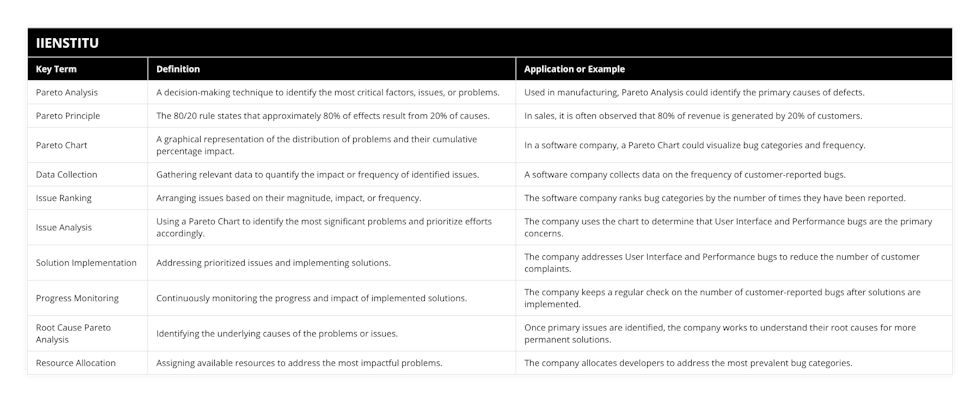
What is the primary purpose of Pareto Analysis?
The primary purpose of Pareto Analysis is to prioritize issues, identify root causes, and allocate resources efficiently by focusing on the most significant problems. This approach helps organizations achieve substantial improvements with limited resources.
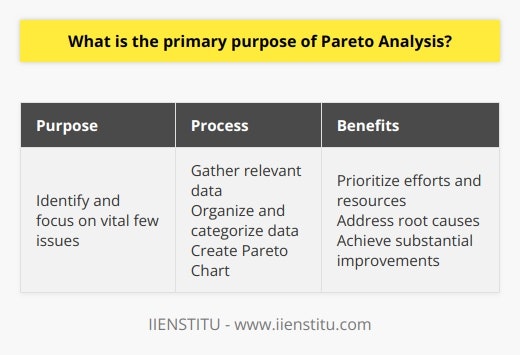
How does the Pareto Principle, or the 80/20 rule, apply to problem-solving?
The Pareto Principle, also known as the 80/20 rule, states that approximately 80% of effects result from 20% of causes. In problem-solving, this translates to the idea that focusing on the most significant problems first can lead to substantial improvements with limited resources.
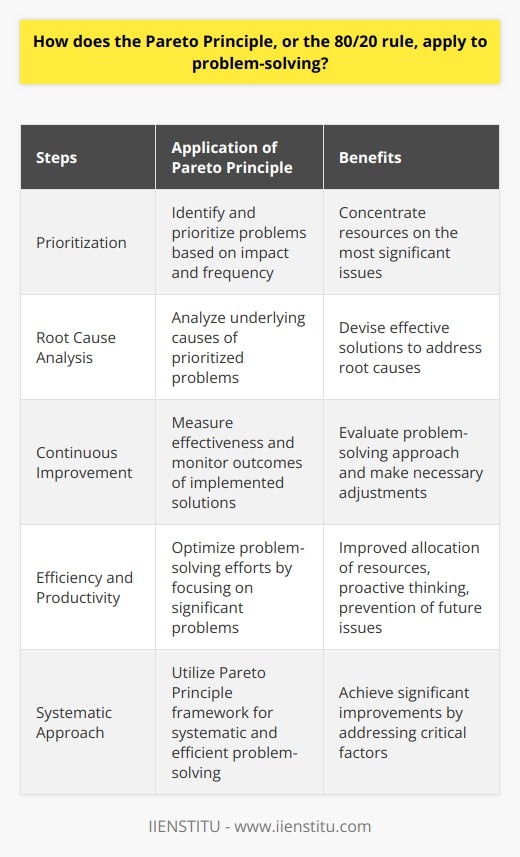
What are some benefits of conducting Pareto Analysis in an organization?
Some benefits of conducting Pareto Analysis include prioritizing issues, enabling efficient resource allocation, promoting continuous improvement, and identifying root causes of problems for long-term improvements and prevention of future issues.
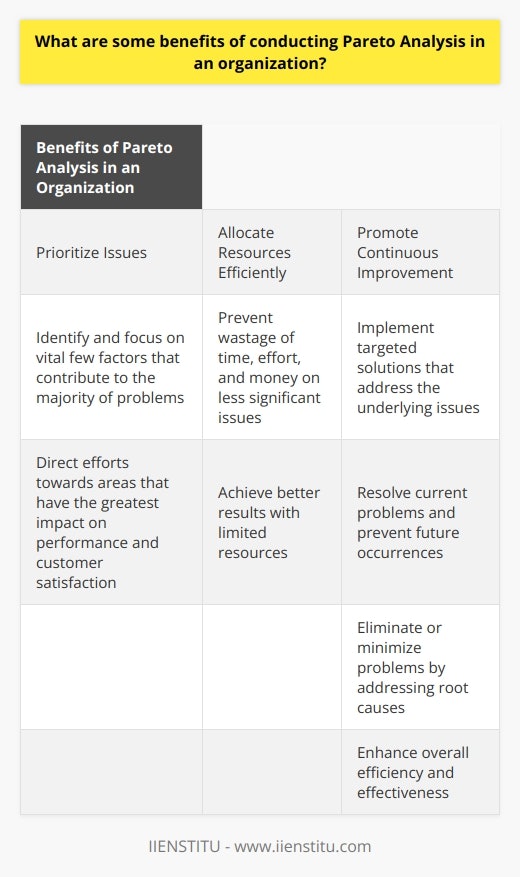
Pia Prebensen is a personal growth expert who helps people identify and overcome their limiting beliefs. She has been featured in various online and print publications, including Elite Daily and The Huffington Post.
Born and raised in Denmark, Pia has always been fascinated by human behavior and the inner workings of the mind.

What is Problem Solving? How to Do It? Step-by-Step Techniques

Mastering SCAMPER for Enhanced Creativity & Innovation

Unraveling Edward de Bono's Six Thinking Hats Technique

A Comprehensive Guide to Decision Matrices

A Comprehensive Guide to Root Cause Analysis

SWOT Analysis: Meaning, Examples and Personal Applications
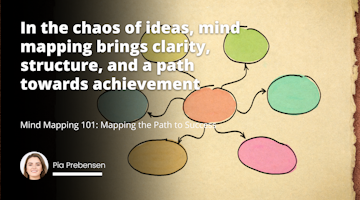
Mind Mapping 101: Mapping the Path to Success


Definition of Problem-Solving With Examples
- Search Search Please fill out this field.
What Is Pareto Analysis?
Understanding pareto analysis, how to create a pareto chart.
- Pros and Cons
The Bottom Line
- Business Essentials
Pareto Analysis: Definition, How to Create a Pareto Chart, and Example
:max_bytes(150000):strip_icc():format(webp)/wk_headshot_aug_2018_02__william_kenton-5bfc261446e0fb005118afc9.jpg)
Julie Bang / Investopedia
Pareto analysis is a decision making tool premised on the idea that 80% of a project’s benefit can be achieved by doing 20% of the work—or, conversely, 80% of problems can be traced to 20% of the causes. In other words, it posits that not all inputs have the same or even proportional impact on a given output.
Pareto analysis will typically show that a disproportionate improvement can be achieved by ranking various causes of a problem and by concentrating on those solutions or items with the largest impact. It is a technique for getting the necessary facts to set priorities.
Pareto analysis is mainly used for business decision making but also has applications in several different fields from welfare economics to quality control. A common part of Pareto analysis is to graphically depict the occurrence of each variable being tracked. This depiction is called a Pareto chart.
Key Takeaways
- Pareto analysis states that 80% of a project’s benefit or results are achieved from 20% of the work—or, conversely, 80% of problems can be traced to 20% of the causes.
- As a decision-making technique, Pareto analysis statistically separates a limited number of input factors—either desirable or undesirable—which have the greatest impact on an outcome.
- Each problem or benefit is given a numerical score based on the level of impact on the company; the higher the score, the greater its impact.
- Modern-day applications of Pareto analysis are used to determine which issues cause the most problems within different departments, organizations, or sectors of a business.
- By allocating resources to issues with higher scores, companies can use Pareto analysis to solve problems more efficiently because they can target those problems that have a greater impact on the business.
In 1906, Italian economist Vilfredo Pareto discovered that 80% of the land in Italy was owned by just 20% of the people in the country. He extended his research and determined that this disproportionate wealth distribution was the same across Europe. The 80-20 rule was formally defined as follows: The top 20% of a country’s population accounts for an estimated 80% of the country’s wealth or total income .
Joseph Juran, a Romanian-American business theorist, discovered Pareto’s research in 1937, approximately 40 years after it was published. Juran proceeded to rename the 80-20 rule as “ Pareto’s Principle of Unequal Distribution .”
Juran extended Pareto’s principle to the business world in order to understand whether the rule could be applied to problems faced by businesses. He observed that in quality control departments, most production defects resulted from a small percentage of the causes of all defects. So, by extension, 80% of the problems are caused by 20% of the defects; Juran’s work implies that if you focus on fixing that 20%, you could have a big impact with minimal effort.
Pareto analysis saves the most scarce resource, which is time, in the area of solving problems.
Modern-day applications of Pareto analysis are used to determine which issues cause the most problems within different departments, organizations, or sectors of a business. Typically, Pareto analysis is employed by business managers , whose approach usually involves conducting a statistical analysis, such as a cause-and-effect analysis, to produce a list of potential problems and the outcomes of these problems.
Following the information provided by the cause-and-effect analysis, the 80-20 rule can be applied. Here are some scenarios relevant to businesses where Pareto analysis might be applicable:
- Sharing information about defects/errors with high-priority stakeholders.
- Prioritizing defects or tasks according to their severity; i.e., according to their impact on a system or business.
- Analyzing data or errors/defects.
Joseph Juran, a Romanian-American engineer and management consultant, coined the terms “vital few,” “useful many,” and “trivial many” to refer to the few contributions that account for the bulk of the effect, and to the many other contributions that account for a smaller proportion of the effect.
Steps of Pareto Analysis
By applying the 80-20 rule, problems can be sorted based on whether they affect profits, customer complaints, technical issues, product defects, or delays and backlogs from missed deadlines. Each of these issues is given a rating based on the amount of revenue or sales and time lost, or the number of complaints received.
Here is a basic breakdown of the steps of Pareto analysis:
- Identify the problem or problems.
- List or identify the cause of the issues or problems, noting that there could be multiple causes.
- Score the problems by assigning a number to each one that prioritizes the problem based on the level of negative impact on the company.
- Organize the problems into groups, such as customer service or system issues.
- Develop and implement an action plan, focusing on the higher-scored problems first, in order to solve the problems.
Not all problems will have a high score, and some smaller problems may not be worth pursuing initially. By allocating resources to high-impact issues or higher scores, companies can solve problems more efficiently by targeting the issues that have a major impact on profits, sales, or customers.
A common part of Pareto analysis is to graphically depict the occurrence of each variable being tracked. This depiction is called a Pareto chart, and it organizes and displays information to show the relative importance of various problems or causes of problems.
It is similar to a vertical bar graph in that it puts items in order (from the highest to the lowest) relative to some measurable effect of interest: frequency, cost, or time. Here is the process of making a Pareto chart.
- Develop a list of problems to be compared.
- Develop a standard measure for comparing the items—for example, how often it occurs: frequency (e.g., utilization, complications, errors); how long it takes (time); and how many resources it uses (cost).
- Choose a time frame for collecting the data.
- For each item, tally how often it occurred (or cost or total time). Then, add these amounts to determine the grand total for all items.
- Find the percent of each item in the grand total by taking the sum of the item, dividing it by the grand total, and multiplying by 100.
- List the items being compared in decreasing order of the measure of comparison; e.g., the most frequent to the least frequent. The cumulative percent for an item is the sum of that item’s percent of the total and that of all the other items that come before it in the ordering by rank.
- List the items on the horizontal axis of a graph from highest to lowest. Label the left vertical axis with the numbers (frequency, time, or cost).
- Label the right vertical axis with the cumulative percentages (the cumulative total should equal 100%).
- Draw in the bars for each item.
- Draw a line graph of the cumulative percentages. The first point on the line graph should line up with the top of the first bar.
The final step is analysis. You can analyze a Pareto chart by identifying those items that appear to account for most of the difficulty. In the example below, the Institute for Healthcare Improvement identified three vital types of errors discovered during surgical setup.
Advantages and Disadvantages of Pareto Analysis
In the most general sense, the advantage of Pareto analysis is that it helps to identify and determine the root causes of defects or problems. This, in theory, should also help to save time.
In business, the most important resource is time. Due to time, the goals usually are not to eliminate or maximize but rather to optimize. And the Pareto rule helps with optimization. With this technique, businesses can resolve defects or errors with the highest priority first.
Pareto charts can specifically help determine the cumulative impact of a problem. Cumulative impact results from effects caused by a problem happening over a long period of time.
Pareto charts are especially useful for businesses or organizations because they can use them to plan the measures or actions that need to be taken in order to amend the problems. For this reason, Pareto charts can sharpen problem-solving and decision-making skills: Problems related to a defect or error can be distilled into cohesive facts.
Pareto analysis does not provide solutions to issues but only helps businesses to identify and narrow down the most significant causes of the majority of their problems. Once the causes have been identified, the company must then create strategies to address those problems.
Disadvantages
The main disadvantage of Pareto analysis is that it does not provide solutions to issues; it is only helpful for determining or identifying the root causes of a problem(s). In addition, Pareto analysis only focuses on past data. While information about past errors or problems is useful, there’s no guarantee that it will be relevant in future scenarios.
A final disadvantage of Pareto charts is that they can only show qualitative data that can be observed; they cannot be used to represent quantitative data. For example, Pareto charts cannot be used to calculate the mean, the standard deviation, or the average of the data, its variability, or changes in the measured attribute over time.
Helps to identify and determine the root causes of defects or problems.
Save time and resolve defects or errors with the highest priority first.
Determine the cumulative impact of a problem.
Plan what measures or actions need to be taken in order to amend problems.
Can sharpen problem-solving and decision-making skills.
Does not provide solutions to issues.
Only focuses on past data.
Pareto charts only show qualitative data that can be observed; they cannot be used to represent quantitative data.
Example of Pareto Analysis
The Department of Ecology for the state of Washington performed a study to identify why oil spills happen. It gathered information on 209 oil spill incidents, including an internal peer review of the causes, and factored in input from responsible parties.
In total, the Department of Ecology identified dozens of causes for oil spills. It identified the primary causes as:
- Inattention/distraction (38 times cited)
- Procedural error (31)
- Judgment (26)
- Mechanical failure (23)
- Structural failure (20)
- Unknown causes (11)
The total number of explanations above (six) represents a little bit more than 20% of the total causes identified (29 total causal factors). However, these six causes cumulatively were responsible for 71% (149 of 209 cases) of oil spills identified. In this example of Pareto analysis, only a few data items are primarily responsible for most causes of oil spills.
What Is Pareto Analysis Used for?
Pareto analysis is used to identify problems or strengths within an organization. As an overwhelming amount of impact is often tied to a relatively smaller proportion of a company, Pareto analysis strives to identify the more material issues worth resolving or the more successful aspects of a business.
What Is the Importance of Pareto Analysis?
Pareto analysis enables an entity to be more efficient with its resources. By quickly identifying a major issue or capitalizing on a major business success, the company can spend less time and resources focusing on less impactful aspects of the company.
How Is a Pareto Chart Different from a Standard Vertical Bar Graph?
A vertical bar graph is a type of graph that visually displays data using vertical bars going up from the bottom. In a vertical bar graph, the lengths are proportional to the quantities they represent. Vertical bar graphs are typically utilized when one axis cannot have a numerical scale.
A Pareto chart is a type of chart that contains both bars and a line graph. Individual values are represented in descending order by bars, and the cumulative total is represented by the line. A Pareto chart is different from a vertical bar graph because the bars are positioned in order of decreasing height, with the tallest bar on the left.
What Is Pareto Efficiency?
Pareto efficiency is a state of the economy where resources cannot be reallocated to provide more advantages for one individual without making at least one individual worse off. Pareto efficiency implies that resources are allocated in the most economically efficient manner. However, this state does not guarantee equality or fairness.
What Is an Example of Pareto Analysis?
Imagine a hypothetical example where a company is analyzing why its products are being shipped late. It comes up with 20 various reasons for what may be causing the delay.
Pareto analysis holds the claim that of those 20 various reasons, roughly four of those items will be the primary cause of roughly 80% of the shipping delays. The company undertakes an analysis to track how many instances of each reason occur.
Pareto analysis isn’t exact; the company may find that five reasons are causing 75% of the company’s delays. Still, in principle, the fact remains that only several items are the primary drivers for a majority of outcomes. The company must focus its resources on these five reasons to make the most impactful positive change to its delivery processes.
When there seem to be too many options to choose from or it is difficult to assess what is most important within a company, Pareto analysis attempts to identify the more crucial and impactful options. The analysis helps identify which tasks hold the most weight as opposed to which tasks have less of an impact.
By leveraging Pareto analysis, a company can more efficiently and effectively approach its decision-making process.
Vilfredo Pareto, via Google Books. “ Cours d’Économie Politique: Nouvelle édition par G.-H. Bousquet et G. Busino .” Librairie Droz, 1964.
National Center for Biotechnology Information. “ Joseph Juran: Overcoming Resistance to Organisational Change .”
Institute for Healthcare Improvement, via Upstate Medical University, University Hospital Nursing. “ QI Essentials Toolkit: Pareto Chart .”
Washington State Department of Ecology, via Internet Archive Wayback Machine. “ Why Spills Happen .”
:max_bytes(150000):strip_icc():format(webp)/investing8-5bfc2b8d46e0fb005144dbe3.jpg)
- Terms of Service
- Editorial Policy
- Privacy Policy
Lorem ipsum test link amet consectetur a
Pareto Analysis (The 80/20 Rule)
In this article:
Pareto analysis is a problem solving and decision-making tool that can help you choose the appropriate course of action when many options are available, and there aren’t enough resources to pursue all options.
In this situation, it would be useful to perform a Pareto analysis. Your Pareto analysis will help you prioritize which actions to take, by showing you which actions will bring the fastest growth to your business.
The Pareto Principle is named after Italian economist Vilfredo Pareto, who observed in the 19th century that 80% of outcomes come from 20% of causes.
When to use a Pareto Analysis?
Daily life requires us to make multiple decisions. Some of these decisions are easy to make because it’s obvious which course of action to take.
Factor Sparsity
The 80/20 rule seeks to identify which 20% of actions will realize 80% of outcomes, but it’s important to realize it works under a specific condition called factor sparsity.
Factor sparsity is simply another way of saying that you have limited resources.
These constraints on your resources (factor sparsity) mean you have to prioritize. It is in situations such as these, where factor sparsity is present, and the correct path to take isn’t clear that conducting a Pareto analysis can be useful.
Using the Pareto Analysis
To solve a problem using Pareto analysis, you can follow this five-step process.
Step 1: Identify and list all the problems.
Step 2: identify the root causes.
A 5 Whys analysis can be a useful tool to help you find the root cause of each problem.
Step 3: Score each of the options using some relative measure.
Step 4: rank the items., step 5: take action.
Create a plan to address those root causes that are causing you the biggest problem.
Pareto Analysis Examples
Example one: investigating it problems.
Obviously, it’s essential that this is rectified as soon as possible. Unfortunately, there are many reasons why the server keeps crashing. Because of this, you decide to perform a Pareto analysis to determine the order in which to fix issues.
| Issue No. | Problem Description |
|---|---|
| 1. | Server configuration issue. |
| 2. | Credit cards fail to process correctly. |
| 3. | The server fails to connect to the payment gateway. |
| 4. | The server is overloaded. |
| 5. | Routine maintenance incorrectly performed. |
| 6. | Engineering doesn’t know the best sequence to investigate issues. |
| Issue No. | Problem Description | Root Cause |
|---|---|---|
| 1. | Server configuration issue. | Lack of processes. |
| 2. | Credit cards fail to process correctly. | The Payment system is out of date and requires updates. |
| 3. | The server fails to connect to the payment gateway. | The Payment system is out of date and needs updates. |
| 4. | The server is overloaded. | Old code is causing a problem. |
| 5. | Routine maintenance incorrectly performed | Lack of processes. |
| 6. | Engineering doesn’t know the best sequence to investigate issues. | Lack of processes. |
Next, you’ll want to score each row in some way. You decide to score each row from 1 to 10 based on how much negative impact this problem resulted in. 10 represents the most impact and 1 the least. This is shown below.
| Issue No. | Problem Description | Root Cause | Impact |
|---|---|---|---|
| 1. | Server configuration issue. | Lack of processes. | 7 |
| 2. | Credit cards fail to process correctly. | The Payment system is out of date and requires updates. | 2 |
| 3. | The server fails to connect to the payment gateway. | The Payment system is out of date and needs updates. | 5 |
| 4. | The server is overloaded. | Old code is causing a problem. | 3 |
| 5. | Routine maintenance incorrectly performed | Lack of processes. | 6 |
| 6. | Engineering doesn’t know the best sequence to investigate issues. | Lack of processes. | 9 |
| Root Cause | Impact |
|---|---|
| Lack of processes. | 22 |
| The Payment system is out of date and requires updates. | 7 |
| Old code is causing a problem. | 3 |
Representing your analysis as a bar chart you can clearly see that improved processes and training will have the biggest impact on the problem.
Example Two: Creating a Study Plan
If the previous example was quite complicated, this example is very simple. Remember that 80% of the results come from 20% of the efforts? Well, this is the reason why in this example we’ll just perform a rough and ready mentally calculated Pareto analysis – because it will give you 80% of the results for 20% of the effort.
You guessed it! You’re going to use a Pareto analysis.
Advantages & Disadvantages
There are several advantages and disadvantages to a Pareto analysis which you should know about.
Disadvantages
Pareto analysis summary.
Sometimes we need a tool to help us with our decision-making to ensure we are applying effort in the most useful way.
Cite this article
Originally hailing from Dublin, Denis has always been interested in all things business and started EPM in 2009. Before EPM, Denis held a leadership position at Nokia, owned a sports statistics business, and was a member of the PMI's (Project Management Institute’s) Global Executive Council for two years. Denis now spends his days helping others understand complex business topics.
Related Tools
The ladder of inference, force field analysis, the kano model, the ooda loop, the dmaic model, fishbone diagram tutorial, elaboration likelihood model, the action priority matrix, rapid decision making model, decision matrix analysis, in our course you will learn how to:.
So if you’ve always wanted to be your own boss and have the flexibility and freedom that entails, then…
Pareto Analysis
A decision-making tool used to compare and fix problems strategically
What is Pareto Analysis?
Pareto analysis is a decision-making tool used to compare and fix problems strategically. It uses the Pareto principle, which is also known as the 80/20 rule – named after Italian economist Vilfredo Pareto. He found that many phenomena or trends follow the 80/20 rule.

For example, in Pareto’s first works, he found that 80% of income in Italy went to 20% of the population. The Pareto principle can be seen all around the world in many different settings, within businesses, and beyond.
For example:
- 80% of bus delays stem from 20% of the possible causes of delay.
- 80% of service complaints arise from 20% of the services you offer.
- 80% of software crashes come from 20% of the potential computer virus types.
- 20% of your products amount to 80% of your revenues.
The 80/20 rule can be used to strategically select the problems in a company to fix that will result in the most impact. It can help stimulate creative thought and organized thinking around business innovation or problem-solving. One important note is that the 80/20 rule is purely a convenient rule of thumb, not an exact ratio or law.
- Pareto analysis is a decision-making technique used to statistically separate the data entries into groups with the most or least effect on the data. It is commonly used in business to find the best strategies or problems to pursue.
- Overall, Pareto analysis focuses on the 80/20 rule, which believes that 80% of the benefit will come from doing 20% of the possible work. Vilfredo Pareto founded the concept as he analyzed the Italian wealth distribution which fit the same ratio.
- The Pareto ratio is only a rule of thumb, and in practice, you should not expect to see this exact ratio. It is also essential to use other analytical tools alongside Pareto analysis in order to justify the validity of the findings and the optimal business solutions.
Steps to Create a Pareto Diagram (80/20 Rule Diagram)
1. identify a list of problems.
Ideally, the list is gathered through feedback from employees, clients, or customers. Common examples include anonymous complaint/feedback forms, customer surveys, or employee organizational recommendations.
2. Identify the cause of each problem
Why did the problem occur? Make sure to think about the root cause, which might be hidden under the surface.
3. Score each problem
Assign a number to each problem based on the negative impact associated with it. The scoring system will depend on the type of problem trying to be solved. For example, for a cellular company, did a customer complaint make them leave the carrier, change their plan (negatively), or not change anything?
4. Group the problems together
Group all of the similar problems together and calculate the collective scores. The problem with the highest score will most likely be the one you should try to resolve first and provide the highest return. Recommended to create a Pareto graph, as seen below, to help visualize the data.
Pareto Diagram Example
The following example comes from a cellular telephone service provider. The data is collected from customer review forms that were submitted following their choice to leave the cellular carrier. The company decides to perform a Pareto analysis on the data to try and figure out what they should focus on first to improve their offering.
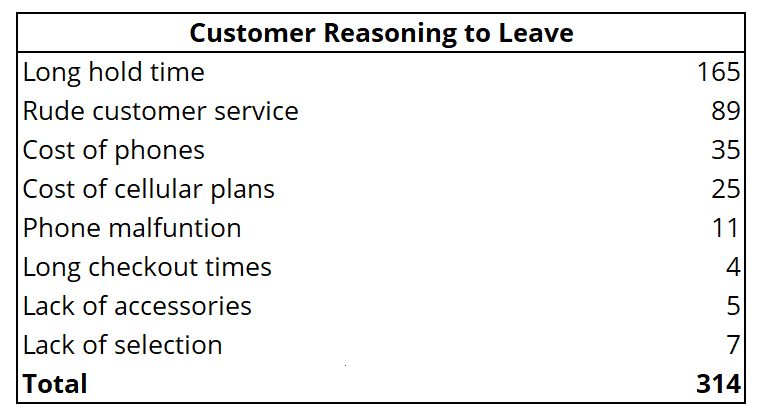
As you can see, the majority of complaints (about 80%) stem from either long hold times or rude customer service. The 80% can be seen in the graph below highlighted by the dotted line.

From a business strategy perspective, those two problems should be addressed first to achieve maximum impact. Judging by the comments, we can assume that hiring more staff and/or training them better would be the best course of action.
Benefits of Pareto Analysis
Pareto analysis offers several benefits, depending on what specific type of project it is being used for. It helps identify problems and prioritize task completion.
Pareto analysis can help improve efficiency, profitability, and much more. Ultimately, it optimizes the overall organization’s performance by coordinating the highest return activities to pursue.
Limitations of Pareto Analysis
Like all business analysis techniques, Pareto analysis comes with limitations. The most prevalent is the ease of overlooking small complications during the analysis, which can add up over time. Also, it does not factor in the severity of a defect or problem, only the quantity.
It is essential to use other types of research to make the most educated decision in problem-solving. Alternative types of problem-solving analytical tools that can be used in parallel to Pareto analysis include hazard analysis , fault tree analysis, and functional failure mode and effect analysis.
CFI is the official provider of the Certified Banking & Credit Analyst (CBCA)® certification program, designed to transform anyone into a world-class financial analyst.
In order to help you become a world-class financial analyst and advance your career to your fullest potential, these additional resources will be very helpful:
- Competitive Advantage
- Pareto Efficiency
- Corporate Strategy
- Strategic Financial Management
- See all management & strategy resources
- Share this article

Create a free account to unlock this Template
Access and download collection of free Templates to help power your productivity and performance.
Already have an account? Log in
Supercharge your skills with Premium Templates
Take your learning and productivity to the next level with our Premium Templates.
Upgrading to a paid membership gives you access to our extensive collection of plug-and-play Templates designed to power your performance—as well as CFI's full course catalog and accredited Certification Programs.
Already have a Self-Study or Full-Immersion membership? Log in
Access Exclusive Templates
Gain unlimited access to more than 250 productivity Templates, CFI's full course catalog and accredited Certification Programs, hundreds of resources, expert reviews and support, the chance to work with real-world finance and research tools, and more.
Already have a Full-Immersion membership? Log in
Everything You Need to Know About the Pareto Analysis and More
Table of Contents
Imagine being able to identify all the underlying causes of failure concerning your productivity, business, or personal matters.
As a matter of fact, you can — by employing a problem-solving technique that uses statistics to pinpoint issues causing most of the damage — the Pareto analysis.
But how does the Pareto analysis work?
To get to the bottom of this enigmatic principle, I tested the Pareto principle, too, and made sure I covered the following matters:
What is the Pareto analysis?
- What is the Pareto analysis used for?
- Steps on how to conduct the Pareto analysis and create a Pareto chart,
- The pros and cons of the Pareto analysis,
- The Pareto principle and time management, and
- The overall rating of the Pareto analysis.

The Pareto analysis, or Pareto principle, is based on the 80/20 rule — 20% of the input results in 80% of the output. For instance, 20% of products are making 80% of a company’s profit.
The Pareto analysis helps single out the vital few that cause the trivial many . In other words, the Pareto analysis helps identify both issues or strengths that cause impact on something, whether business or personal life .
Originally, the Pareto analysis was established by Vilfredo Pareto in the late 19th century, who noticed that 80% of the land in all of Italy was owned by 20% of the population. He then started noticing similar patterns elsewhere. Later on, his research and work were adapted by Joseph M. Juran, a management consultant, and the Pareto principle and analysis were born.
In practice, with proper implementation of the Pareto analysis, individuals can use it to boost their personal productivity by focusing on the vital few or to help them prioritize their tasks.
On the other hand, companies can use this method to determine the most impactful problems or strengths related to their operations. For instance, when they are aware of the most relevant issues that cause most of the damage, they can act on them by concentrating on the solutions and allocating the right resources to solve those issues.
💡 Clockify Pro Tip
Make a clear distinction between productivity and efficiency by reading the following blog post on the matter, and also, learn how to calculate them to achieve better results:
- Productivity vs efficiency: what is the difference and why it matters
Pareto analysis examples
Modern usages of the Pareto analysis further show that 80% of the problems within a project can often be traced back to 20% of the causes.
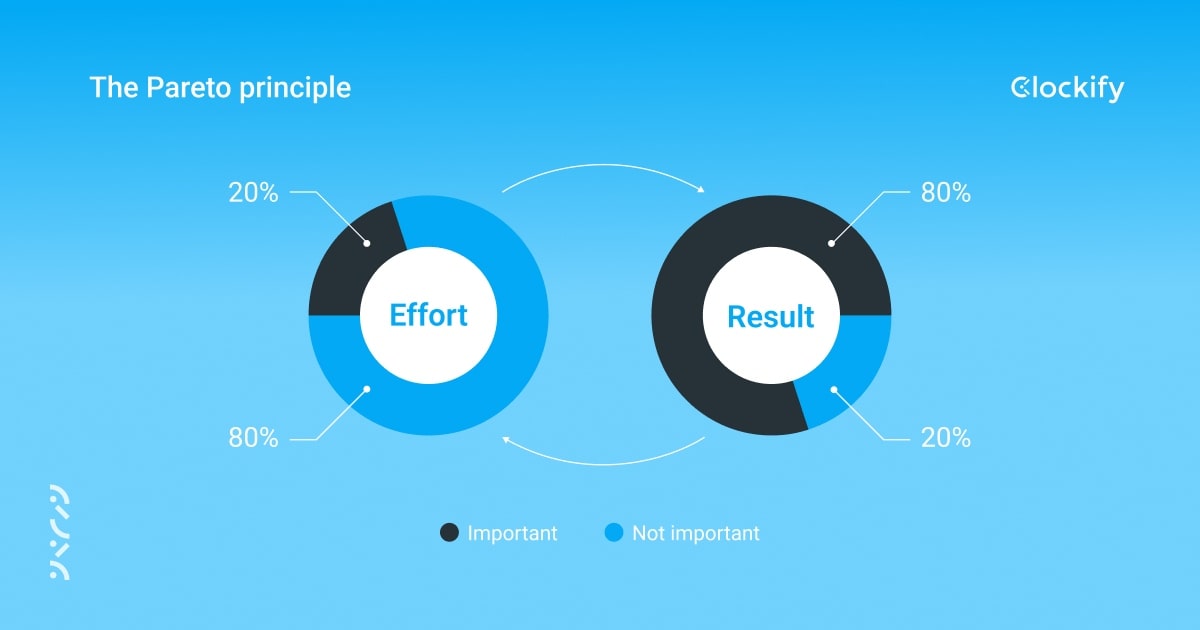
In other words, by focusing on the crucial 20% of the problem causes, you’ll subsequently be able to deal with the 80% of the issues that stem from them.
Let’s put this statement into perspective.
The Hard Rock Hotel conducted a guest survey and got 75 complaints in total, which were later grouped into 5 categories (room service, check-in issues, pool hours, minibar, and misc). It seemed like 20% of the guest complaint categories, room service and check-in issues, make up 80% of the total complaints.
This principle can be used in any other area of life, too:
- You wear 20% of your clothes 80% of the time.
- 80% of the air pollution comes from 20% of all factories in a city.
- 20% of the employees make 80% of a company’s profit.
- Only 20% of the students in a classroom have grades of 80% or higher.
Learn more about resource allocation and how to track it in this blog post:
- How to track resource allocation
How to make a Pareto chart (+ steps)
As explained above, the Pareto analysis can be your ally in sorting out problems and their impact on business operations (or your personal matters).
Now, take a look at the steps on how you can conduct the Pareto analysis and see what’s standing between you and success (I’ve also tested Pareto analysis and included my observations for better understanding).
Step #1: Collecting and grouping the issues
The first step in performing the analysis is forming a list of the issues that you want to evaluate . Whether it’s business or personal, create a list of the problems that will be your cornerstone for the future development of the analysis.
As a writer, I write huge blocks of text daily, and like any other job, mistakes are inevitable. When it’s time to review the text, a number of issues come to the surface, and I’ve collected and grouped some of the most frequent ones:
- Spelling mistakes — typos, misspelled words,
- Structural mistakes — unclear phrases, long headings, lack of transition words,
- Punctuation mistakes — run-on sentences, missing commas or quotation marks,
- Citation mistakes — missing references, outdated resources, or unnecessary citations,
- Formatting mistakes — different fonts used, double spacing, and
- Repeating mistakes — using certain words or phrases frequently.
Bear in mind that if the problems you discover concern your team too, you’ll need to include your team members in brainstorming potential issues.
Learn about the importance of team collaboration and effective strategies for building collaborative teams here:
- Team collaboration: why it’s important and how to foster it
Step #2: Identifying the causes
Now comes the hard part — i.e., the main point of the analysis.
This step requires you to think carefully and identify the root causes of an issue or issues at hand. Don’t forget that multiple underlying causes could be the main culprits for the ongoing issues.
To pinpoint your issues you could create a list of all the previously identified problems and connect them to the causes that may come to your mind.
For this purpose, I proofread one of my new texts and added up my writing mistakes, which totaled 98 .
Look at the table below for a breakdown of problems, causes, and number of issues related to my writing:
| Structural mistakes | Lack of formal knowledge | 26 |
| Citation mistakes | Lack of formal knowledge | 21 |
| Repeating mistakes | Lack of focus | 17 |
| Spelling mistakes | Lack of focus | 15 |
| Formatting mistakes | Lack of time (tight deadlines) | 10 |
| Punctuation mistakes | Lack of time (tight deadlines) | 9 |
The next step is to create the Pareto chart, where you will use your data to visually represent the connection between the total count of issues, their frequency, and final outcomes.
Step #3: Finalizing the Pareto chart
The Pareto chart contains bars showing problems, horizontal and vertical axes, together with a red line that represents the cumulative percentage of problems. The bars are shown in descending order, each representing an issue.
First, to get a graphical picture of the identified problems, you need to obtain the total count of the issues you’ve listed. In my case, that would be 98.
Then, you need to use a specific formula to obtain the exact percentages for each issue (to be able to represent the issues on a graph better):
(Frequency of occurrences) / (sum of total occurrences) * 100
In the substep below, we will use the above formula to calculate and determine each stop of your cumulative line on the chart.
Creating the cumulative line on your Pareto chart
Here’s how you will use the above formula to create the cumulative line on your chart.
So, the total count of all my issues is 98 — the sum of total occurrences.
I made Structural mistakes 26 times — that’s the frequency of my issue.
26 / 98 * 100 = 26,53%
Next, you need to create the route for each stop at your cumulative line.
Remember that the start of your cumulative line is at 26.53% .
To know the next stop of your cumulative line, you need to add up Structural mistakes with Citation mistakes, using the above given formula (the same formula that you will use to calculate each stop at your cumulative line) which is:
(26 + 21) \ 98 * 100 = 47,95%
Therefore, the 2nd stop of your cumulative line is at 47.95% .
The calculation for the 3rd stop is adding Structural, Citation, and Repeating mistakes:
(26 + 21 + 17) \ 98 * 100 = 65,30%
Your 3rd stop of the cumulative line is at 65,30% .
To know the 4th stop of your cumulative line, add up Structural, Citation, Repeating, and Spelling mistakes:
(26 + 21 + 17 + 15) \ 98 * 100 = 80,61%
The 4th stop of your cumulative line is at 80,61% .
Up next is the 5th stop, and add up Structural, Citation, Repeating, Spelling, and Formatting mistakes:
(26 + 21 +17 +15 +10) \ 98 * 100 = 90,81%
The 5th stop at your cumulative line is at 90,81% .
Your final, 6th stop requires you to add up all mistakes together — Structural, Citation, Repeating, Spelling, Formatting, and Punctuation mistakes:
(26 + 21 + 17 + 15 + 10 + 9) \ 98 * 100 = 100%
So, the last stop at your cumulative line is at 100% .
Now, let’s finalize the diagram by creating a y-axis (vertical axis) that represents the number of occurrences and drawing a straight, horizontal line (x-axis) that represents your mistakes.

Now we can see that three lines connected at the same spot, making a distinction between the crucial 20% (Structural and Citation mistakes) and the rest, 80% of mistakes that are marked as trivial .
According to the Pareto principle, only 20% of the mistakes make up 80% of the damage in my writing.
Pareto analysis pros and cons
If you want to carry out the Pareto analysis yourself, you must be aware of its advantages and disadvantages.
Among many advantages you may have already discovered up to this point , the Pareto analysis also helps you with:
- Identifying the problems and their root causes that slow you down,
- Sorting out errors and damages with the highest priority,
- Recognizing where you should be focusing more of your efforts (especially during your biological prime time ),
- Analyzing data and presenting results in a visual graph for a deeper understanding of your issues, and
- Improving overall performance by detecting time wasters .
On the other hand, Pareto analysis comes with its share of disadvantages . As a matter of fact, this method may:
- Fail to provide solutions to the identified problems and causes,
- Rely solely on past data and cannot be used to predict future challenges,
- Be somewhat time-consuming since it took me a while to carry out the whole analysis and get data, and
- Demonstrate qualitative data rather than quantitative data.
Want to know how to predict the future of your projects together with time, budget, and estimates? Take a look at Clockify’s handy feature for project forecasting here:
- Project forecasting software
How to use the Pareto analysis to manage time more effectively
You may be surprised, but the Pareto principle can be used as a very effective tool for time management. Take a look at the following tips that will help you implement the Pareto principle into your everyday life and boost your time management skills.
Tip #1: Use the Pareto analysis to prioritize your issues better
The Pareto analysis is a great prioritization method as it helps you see the problems that have higher priority and that need to be addressed first. As you can see from the example above, problems with the highest scores ended up causing most of the damage, so Pareto may help you or your business resolve top priority issues one by one.
For instance, after careful analysis, you found out that the causes for low product demand have to do with bad marketing. The Pareto analysis showed that poor marketing strategies are some of the main causes for the decrease in your product’s demand. Therefore, it’s time you question your marketing strategies to boost your sales.
Talking about prioritization, take a look at the following blog post that may help you focus on work priorities:
- How to (re-)prioritize your tasks
Tip #2: Make use of the Pareto analysis to beat distractions
Normally, after you identify the problems that are causing the damage (in this case, time wasting), you will be able to reduce them and increase your focus.
For instance, you’ve implemented the Pareto analysis to see why you can’t seem to finish your work tasks. It turns out that you do your chores during work hours rather than after work, so you end up working long hours .
Remember, the Pareto principle won’t help you find solutions to your problems but rather identify and make sure you are aware of them.
Tip #3: Combine the Pareto analysis with the Pomodoro technique
If your analysis shows that you spend 80% of your work hours taking breaks and sipping coffee with your colleague, you may want to consider trying out the Pomodoro technique .
While you can make use of the Pareto principle to help you identify time wasters, why not implement another time management method that will save you from overworking , such as the Pomodoro itself!
For this purpose (and to spare you from setting your alarm on and off each time), try using the Clockify’s Pomodoro timer .

The process is simple:
- Write what you are working on,
- Start a timer for 25 minutes,
- Focus on your work for those 25 minutes,
- When the alarm goes on, stop working, and
- Take a 5-minute break.
Repeat this cycle, as it will help you ensure that you finish your work and take regular breaks along the way, while the Pareto analysis will help you identify your most common time wasters that are draining your productivity. Combined together, the Pareto principle and the Pomodoro technique can be your ally in effective time management.
My overall rating of the Pareto analysis
Although it took me a while to figure it out (and to carry out the analysis itself), I must admit this technique truly works.
Once I looked back, I realized that the crucial 20% of the problems that Pareto pointed out were the ones I struggled with the most in general.
While it cannot solve problems per se, the Pareto analysis can definitely help individuals or businesses identify the causes that affect a particular outcome.
While I was testing out the method, my first thought was: “Obviously I know the reasons behind my writing mistakes!” But somehow, the mistakes would creep up on me every time I sat behind my keyboard. As it turned out, I wasn’t really aware that my formal knowledge wasn’t on such a high level as I thought it was. That’s why the Pareto analysis really had me put on my thinking cap.
Even though the whole process is a bit drawn-out, this method is great, effective, and truly makes you wonder — How did I not realize this sooner?
I certainly recommend it to everyone that struggles with determining the causes that make their workdays harder, and my final rating for this technique is:
FINAL RATING: ⭐⭐⭐⭐
Use Clockify to better implement the Pareto analysis and improve your time management skills
If you are struggling with time management, by implementing the Pareto principle into your everyday life, you’ll spend more time focusing on priorities and eliminating time wasters.
By using both Clockify and the Pareto analysis to boost up your time management skills, you may achieve peak performance.

Jelena is a productivity author and researcher who enjoys doing extensive research on proven time management techniques and skills. Writing about time management helped Jelena master her skills, and now she is more than eager to bring personal experience into her writing and help people sharpen their skills.
Where does the time go?
START TRACKING TIME
with Clockify
How to Make Time Go Faster at Work: 7 Easy Tips and Strategies
Learn more about our perception of time and get some tips on how to make time go faster at work in our blog post.
What Is Second Shift: Definition, Tips, Pros, and Cons
Learn about the second shift, its advantages and disadvantages, tips, and more.
How Many Work Days in a Year (2024)
Find out how many work days there will be in 2024, calculate your work days easily, and maintain your work-life balance.
What is the Third Shift: Benefits, Drawbacks, and Tips
Learn everything there is to know about working the third shift and use it to transform your business into a 24-hour functioning machine.
What Is First Shift: Benefits, Drawbacks, and Tips
Discover the pros and cons of first shift hours to make the best decision for your career path and achieve company goals.
How Many Work Hours Do You Work in a Year?
Learn how to calculate work hours per year, along with annual non-work hours, and understand why calculating work hours per year is important.
FREE FOREVER • UNLIMITED USERS
Free time tracker
Time tracking software used by millions. Clockify is a time tracker and timesheet app that lets you track work hours across projects.
- Schedule an Assessment
- [email protected]
- +1 678-971-4711
- Connect on LinkedIn
Culture Powers Business™
- Mastery Series
- June 21, 2024
Mastering Root Cause Analysis: Using Pareto Analysis to Uncover Productivity Killers

Among the various root cause analysis techniques critical to the success of the manufacturing industry, Pareto Analysis stands out for its effectiveness in pinpointing the most significant factors contributing to problems.
We dive deeper into the importance of Pareto Analysis, the steps to perform it, its applications, benefits, and potential challenges.
Understanding Pareto Analysis
Pareto Analysis is a statistical technique that helps identify the most significant factors contributing to a problem. Named after the Italian economist Vilfredo Pareto, this analysis is based on his observation that 80% of Italy’s wealth was owned by 20% of the population.* In a broader context, the Pareto Principle suggests that 80% of problems are typically caused by 20% of the causes.
This concept can be applied to various aspects of manufacturing, from identifying production defects to understanding equipment failures. Manufacturers can significantly improve their operations by identifying and addressing these critical issues.
Why Use Pareto Analysis in Manufacturing?
Pareto Analysis is an invaluable tool for the manufacturing industry because it enables companies to efficiently identify and address the most significant issues impacting the productivity of their operations. By focusing on the principle that 80% of problems are typically caused by 20% of the causes, manufacturers can prioritize their efforts on the areas that will have the highest impact.
This targeted approach enhances problem-solving efficiency and optimizes resource allocation, ensuring that time, money, and manpower are directed toward the most impactful issues. Moreover, Pareto Analysis helps uncover hidden patterns and trends in production data, providing deeper insights into underlying problems. As a result, manufacturers can achieve higher-quality products, reduce downtime, and increase overall productivity, making Pareto Analysis a cornerstone of effective root-cause analysis in the manufacturing sector.
Steps to Perform Pareto Analysis
Step 1 identify problems and causes.
The first step in Pareto Analysis is to collect data on the problems and their causes. This data can come from multiple sources, including production logs, maintenance records, quality control reports, and employee feedback. Gathering accurate and comprehensive information is crucial to ensure the analysis is effective. For instance, a manufacturer might record instances of machine breakdowns, noting the specific cause each time, such as lack of maintenance, operator error, or material defects.
Step 2 Categorize and Quantify Data
Once the data is collected, it needs to be categorized into groups, such as equipment failures, human errors, or material defects. Each category should then be quantified in terms of frequency and impact. This quantification helps in understanding which issues are the most prevalent and damaging. For example, if a manufacturer finds that equipment failures occur more frequently than human errors, they might categorize and quantify the types of equipment failures to understand which specific machines or components are most problematic.
Step 3 Create a Pareto Chart
A Pareto Chart is a visual tool used in Pareto Analysis. It consists of a bar graph showing each category’s frequency or impact and a cumulative line graph representing the cumulative percentage of the total problems. To create a Pareto Chart, plot the categories on the x-axis and their corresponding frequency or impact on the y-axis. The categories should be arranged in descending order of significance. This visual representation helps quickly identify the most significant issues. For example, a manufacturer might create a Pareto Chart showing that 80% of production defects are caused by 20% of the processes.
Step 4 Analyze the Chart
By examining the Pareto Chart, you can identify the ‘vital few’ causes that contribute to the majority of problems. The leftmost bars typically represent the most significant issues. Focus on these critical areas for problem-solving efforts. Understanding these key contributors allows for more targeted and effective interventions. For instance, if the chart shows that a specific machine causes the majority of downtime, the manufacturer can prioritize maintenance or replacement of that machine to reduce overall downtime.
Applications in Manufacturing
Pareto Analysis has numerous applications in manufacturing. For example, a manufacturer might use this technique to identify the most common causes of equipment downtime or determine which defects are most prevalent in their products. The manufacturer can significantly reduce downtime and improve product quality by addressing these top issues. Case studies have shown substantial improvements in production efficiency and quality through the application of Pareto Analysis. For instance, a manufacturer who applied Pareto Analysis to their quality control processes found that a significant portion of defects were due to a single type of material flaw, leading them to switch suppliers and reduce defects by 50%.
Benefits of Using Pareto Analysis
This leads to improved production quality and efficiency and enhances decision-making processes. Additionally, by continuously applying Pareto Analysis, manufacturers can maintain a cycle of continuous improvement. This iterative process helps adapt to new challenges and sustain high performance. For example, regular Pareto Analysis can help a manufacturer stay ahead of potential issues by identifying trends in equipment wear and tear, allowing for proactive maintenance.
Challenges and Limitations
While Pareto Analysis is a powerful tool, it does have its challenges and limitations. Collecting accurate data can be difficult, and there is a risk of overlooking minor issues that may be critical. It is essential to regularly update the analysis to ensure it remains relevant and comprehensive. Despite these challenges, the benefits of Pareto Analysis far outweigh the potential drawbacks. Complementing Pareto Analysis with other root cause analysis techniques is important to ensure a holistic problem-solving approach. For example, combining Pareto Analysis with Fishbone Diagrams can help in visualizing the relationships between different causes of a problem.
In conclusion, Pareto Analysis is an invaluable technique for root cause analysis in the manufacturing industry. By focusing on the most significant issues, manufacturers can achieve substantial improvements in productivity and efficiency. Implementing Pareto Analysis allows for a more strategic approach to problem-solving, driving continuous improvement. As manufacturing environments become more complex, quickly and effectively identifying and addressing key issues becomes increasingly important.
How POWERS Can Help Boost Productivity
At POWERS, we specialize in enhancing manufacturing productivity through tailored, results-based management consulting. Our unique approach, ‘Operationalizing Your Culture,’ aligns organizational culture with behaviors and skills that drive higher productivity and efficiency.
Contact us today to learn how we can help you identify and address your most pressing issues, driving continuous improvement and maximizing your manufacturing efficiency.
- Speak to an Expert: Call +1 678-971-4711 to discuss your specific challenges and goals.
- Email Us: Get tailored insights by emailing [email protected]
- Request an Assessment: Use our online contact form, and one of our productivity experts will reach out to schedule an in-depth analysis of your operations.
* “Causes, Consequences and Dynamics of ‘Complex’ Distributions of Technological Activities: The Case of Prolific Inventors”. https://core.ac.uk/download/pdf/6380749.pdf
Continue Reading from this Mastery Series
- Part 1 – The 5 Whys Technique Deep Dive
- Part 2 – Utilizing the Fishbone Diagram Deep Dive
- Part 3 – Fault Tree Analysis (FTA) in the Manufacturing Industry
- Part 4 – Failure Mode and Effects Analysis (FMEA) Deep Dive
- Part 5 – Using Pareto Analysis to Uncover Productivity Killers
Continue Reading from other Mastery Series

Unplanned Downtime: The Silent Thief Stealing Your Productivity and Profitability

Mastering Root Cause Analysis: How Ignoring It Can Lead to Big Productivity Issues

Productivity Vigilance: Why Manufacturing Success Depends on Keeping Your Eye on the Ball

Focus on OEE: 10 Ways Ignoring Overall Equipment Effectiveness (OEE) Hinders Manufacturing Performance

The Untapped Potential: Top 10 Issues Caused by Ignoring Capacity Utilization in Manufacturing

Maximizing Profitability: Sustainable Manufacturing Uncovers Hidden Financial Advantages and Avoids These Top 10 Bottom Line Busters
Connect Quickly to Content by Category
Get the latest Culture Performance Management insights delivered to your inbox
About the author.

CEO, Managing Partner
Sean Hart is an industrial engineer with a background in manufacturing supervision and project management. Sean’s background is in improving overall plant efficiencies and implementing Lean techniques to improve processes.
- Connect on Linkedin
- Read Full Bio

Dr. Donte Vaughn, DM, MSM
Chief Culture Officer Dr. Donte Vaughn is CEO of CultureWorx and Culture Performance Management Advisor to POWERS.

Randall Powers
Managing Partner Randall Powers concentrates on Operational and Financial Due Diligence, Strategic Development,, and Business Development.
Software Testing Help
Pareto Analysis Explained With Pareto Chart And Examples

This Tutorial Explains What is Pareto Analysis With Examples, Benefits & Limitations. Also learn What is a Pareto Chart, how to create it in Excel:
Pareto Analysis is a powerful quality and decision-making tool. If implemented properly, it will help in identifying the major pitfalls in any process flow which in turn improves the quality of the product/business. It is an excellent visualization tool to visualize the issues quickly.
Let’s see a real-life example where Pareto Analysis is applied.
Learning and Development [L&D] Manager in a company noticed that number of employees getting enrolled in skill up-gradation training was considerably reducing. To understand the reason, he did a feedback survey with the possible dissatisfaction factors and plotted a Pareto Chart.
And there it is!! all the information that he wanted is in front of him and now he knows how to improve the training sessions.

Let’s learn in detail about Pareto Analysis and Pareto Chart or Pareto Diagrams.
Table of Contents:
History Of Pareto Analysis
Pareto analysis examples, benefits & limitations, when to use pareto chart, steps to create a pareto chart, inbuilt tools in microsoft excel to create pareto chart, frequently asked questions, was this helpful, recommended reading, what is pareto analysis.
Pareto Analysis is a technique used for decision making based on the Pareto Principle. Pareto Principle is based on 80/20 rule which says “80% of impacts are due to 20% of causes”. It emphasizes that a major number of issues are created by a relatively smaller number of underlying causes.
Pareto Analysis is one of the 7 basic quality process tools and is applied across many industries by Managers to improve the business and quality.
When it is applied to the software industry, the Pareto Principle can be quoted as “80% of defects are contributed by 20% of the code”. 80/20 are just a figure, it can vary as 70/30 or 95/5. Also, it’s not necessary to add up to 100%, for example, 20% of products in a company can account for 120% profits.
Pareto Analysis was named after Vilfredo Pareto , an Italian Economist. He observed in the late 1800s that in Italy, 80% of the land was owned by 20% of people. Hence, it is also called the 80/20 rule.
Pareto Analysis was later updated by a quality evangelist Joseph Juran who observed that the logarithmic mathematical model which Pareto had developed is not only applicable to Economics but also in Quality Management and many other fields. Hence, he concluded that the 80/20 rule is universal and named it a Pareto Principle.
Pareto Principle is also called the law of “The Vital Few and Trivial Many ”. It is a prioritization tool that helps to find “VITAL FEW” and “TRIVIAL MANY” causes. Vital Few means many problems come from a relatively small number of causes. Trivial Many refer to a large number of remaining causes result in very few problems.
Pareto Analysis can be applied literally in any scenario we see around in our day-to-day life as well.
Here are some examples:
- 20% of employees do 80% of work.
- 20% of drivers cause 80% of accidents.
- 20% of the time spent in a day leads to 80% of work.
- 20% of clothes in the wardrobe are worn 80% times.
- 20% of things in the warehouse occupy 80% of storage space.
- 20% of employees are responsible for 80% of sick leaves.
- 20% of household items consume 80% of electricity.
- 20% of the book will have 80% of the content you are looking for.
- 20% of all people in the world receive 80% of all income.
- 20% of tools in the toolbox are used for 80% of tasks.
- 80% of crimes are committed by 20% of criminals.
- 80% of revenue is from 20% of company products.
- 80% of the complaints are from 20% of clients.
- 80% of cooking at home is from 20% of total utensils.
- 80% of loan repayment pending are from 20% defaulters.
- 80% of travel is to 20% of the places.
- 80% of customers use only 20% of the software App/website/smartphone features.
- 80% of the contribution comes from 20% of potential contributions available.
- 80% of the restaurant sale is from 20% of its menu.
And such examples are endless. If you observe the nature and things happening around, you can cite many examples like this. It’s applied in almost every field be it business, sales, marketing, quality control, sports, etc.
The benefits are as follows:
- It helps to identify top root causes.
- Helps to prioritize the top issue for a problem and try to eliminate it first.
- Gives an idea of the cumulative impact of issues.
- Corrective and Preventive action can be better planned.
- Gives a focussed, simple, and clear way to find vital few causes.
- Helps to improve problem-solving and decision-making skills.
- Improves the effectiveness of quality management.
- Useful in every form of leadership decision.
- Helps in time management, be at work, or personal.
- Helps in general performance management.
- Helps in planning, analysis, and troubleshooting as well.
- Helps in problem-solving and decision making.
- Helps in change management.
- Helps in time management.
The limitations are as follows:
- Pareto Analysis cannot find root causes by itself. It needs to be used along with other Root Causes Analysis tools to derive the root causes.
- It doesn’t show the severity of the problem.
- It focuses on past data where damage has already happened. Sometimes it might not be relevant for future scenarios.
- It cannot be applied to all cases.
What Is A Pareto Chart?
A Pareto Chart is a statistical chart which orders the causes or problem in the descending order of their frequency and their cumulative impact. Histogram chart is used inside the Pareto chart to rank the causes. This chart is also known as Pareto Diagram.
Below is an example of a Pareto Chart which was published in Disease Management Journal which depicts what’s are the top diagnostic categories for hospital admissions.

Pareto Chart has a bar chart and a line graph co-existing together. In Pareto Chart, there is 1 x-axis and 2 y-axes. The left x-axis is the number of times[frequency] a cause category has occurred. The right y-axis is the cumulative percentage of causes. Cause with the highest frequency is the first bar.
Suggested reading =>> Bar chart vs Histogram – Main differences
Bar Chart represents causes in descending order. Line Graph presents a cumulative percentage in ascending order.
These are used in cases like,
- When there is a lot of data and needs to be organized.
- When you want to communicate the top issues to stakeholders.
- When there is a need to prioritize tasks.
- When the relative importance of data needs to be analyzed.
Below flowchart summarises the steps to create the Pareto Chart.

#1) Select Data
List down the data that needs to be compared. Data can be a list of issues, items, or cause categories.
To better understand how Pareto Analysis is applied, let’s take an example where a Software Development Manager wants to analyze the top reasons which contribute to defect at the Coding Phase. To get the data, Manager will get the list of coding issues that contributed to defect from the defect management tool.
#2) Measure Data
Data can be measured in terms of:
- Frequency ( for example, no. of times problem has occurred) OR
- Duration (how long it takes) OR
- Cost (how many resources it utilizes)
In our scenario, the defect management tool is listed with a dropdown for the reviewer to select the reason for the defect. So, we will take the no. of times [frequency] a specific coding issue has occurred over a period.
#3) Select timeframe
The next step is to choose the duration during which data has to be analyzed say a month, a quarter, or a year. In our scenario, let’s take a span of defects reported in the last 4 software releases to analyze where the team is going wrong.
#4) Calculate Percentage
Once the data is collected, put it in an Excel Sheet as shown in the below image.

Then, create a Percentage column. Calculate the percentage of each Issue type by dividing frequency with TOTAL.

Change the Percentage columns using the Percent Style button (Home tab -> Number group) to display the resulting decimal fractions as percentages.

Final percentage will be displayed as below:

#5) Sort in ascending order
Sort the percentage from largest to smallest as explained below:
Select the first 2 columns and click on Data->Sort and select Sort by “ Frequency” column and Order by “ Largest to Smallest ”.

Sorted categories are displayed as below:

#6) Calculate the cumulative percentage
The cumulative percentage is calculated by adding the percentage to the previous root cause category percentage. The last cumulative percent will be always 100%.
Start the first column with the value the same as the Percentage column and keep adding the percentage above for the rest of the rows.

After filling the Cumulative percentage, Excel Sheet will look like below:

#7) Draw Bar Graph
Create a Bar graph with x-axis denoting the different causes for coding errors, left y-axis denoting the no. of times coding issues have happened, and percentages on the right y-axis.
Click on the table and Insert -> Charts -> 2D column .

Right-click and select data

Unselect Percentage and TOTAL in Select Data Source .

The chart will look like below:

#8) Draw Line Graph
Draw the line graph by joining the cumulative percentages.
Select cumulative percentage and right-click on the chart and select “Change Series Chart Type”

Modify Cumulative Percentage as a Line graph and select “Secondary Axis”.

Here is the final Pareto Chart:

#9) Analyse the Pareto Diagram
Imagine a line from 80% on the y-axis to the line graph and then drop to the x-axis. This line will separate the “trivial many” from “vital few”. Based on the observations from the Pareto Chart, Pareto Principle or 80/20 rule is applied and improvement actions will be planned.
In our scenario, the first 2 causes contribute to 70% of defects.

We have explained the process of creating a Pareto chart in Microsoft Excel to understand how its plot. But ideally, you don’t need to do all calculations by yourself because Microsoft office provides an inbuilt option to create a Pareto Chart. We just have to source the data to be fed to the Excel Sheet and plot the Pareto Chart. It’s that simple!!
Pareto Chart can be created easily using the Microsoft Word/Excel/PowerPoint .
Let’s take another example of a list of continents ranked by the current population.

Collect all the required data in Excel Sheet as shown in the above image. Now, we will draw the Pareto Chart for population per continent. For that, first select the rows from B1, C1 to B9, C9.

Then click on “ Insert ” and then “ Insert Statistic Chart ”.

Then click on “ Pareto ” under Histogram .

As you can see, the chart is small and the font is not visible. Now, drag the chart below the data table and right-click on the x-axis text area, select font, and update as required.

Update the font as required.

After updating the font, expand the picture to see the fonts clearly.

Pareto Chart is ready!! Now it’s time to analyze.
2 continents Asia and Africa (out of 7 continents) contribute to 83% of the world population and rest 5 continents (Europe, North America, South America, Australia, Antarctica) contribute to 17% of the rest of the world population.
More Pareto templates are available at Microsoft Support Website which you can download and modify as per your requirement. It’s also used in other analytics tools such as SAS , Tableau , etc.
Q #1) Why do you use Pareto Chart?
Answer: Pareto Chart is a decision-making tool used by improvement teams to derive the top causes contributing to a problem. In quality management, it can be defined as root causes contributing to the maximum number of defects.
Q #2) What do Pareto Chart tell you?
Answer: Pareto Chart is a visual graph that has a bar graph and line graph. It will divide the chart into a vital few and trivial many with few causes on the left side and more causes in the right side of the chart.
Q #3) What are the benefits of Pareto Analysis?
Answer: It is useful to segregate defects to major and minor issues. It helps to focus on problems and gives significant improvement.
Q #4) How is Pareto calculated?
Answer: Follow the steps below:
Step 1: Identify the data and its total count. Step 2: Reorder from largest to smallest. Step 3: Determine the cumulative percentage of all. Step 4: Draw horizontal axis with causes, vertical axis on left with occurrences, and the vertical axis on left with cumulative percentage. Step 5: Draw the bar graph and line graph depending on data. Step 6: Analyze the Pareto Chart.
Q #5) What is the 80/20 rule in Pareto Chart?
Answer: It’s based on the famous Pareto Principle which states that 80% of output is from 20% input.
Q #6) Is the Pareto principle true?
Answer: Pareto Principle is based on the universal observation that there is a disproportion between the inputs and outputs. The percentage of input/output ratio is not strictly 80/20 percentage.
Q #7) What is the other name of the Pareto Principle?
Answer: It is also called “80/20 rule” or “law of vital few and trivial many”.
Q #8) What are the common limitations of the Pareto Principle?
Answer: Pareto Principle usually measures the occurrence of defects rather than the severity of defects. If a severe defect falls in the 20% category, then it would be missed.
Effective implementation of Pareto Analysis requires the right source of data. The tutorial covers the concept of Pareto Analysis, its uses, limitations, and when/how this technique needs to be used.
If done appropriately, Pareto Analysis will help to break a big problem into smaller pieces and help to focus on where to put efforts and hence guide in better usage of resources.
- 7 Principles of Software Testing: Defect Clustering and Pareto Principle
- 7 Basic Quality Tools: Quality Management, Control and Improvement Tools
- 10 Steps To Improve Software Quality By Improving Process
- Continuous Integration Process: How to Improve Software Quality and Reduce Risk
- 8 Key Performance Indicators for Quality Releases (Panaya Test Dynamix Review)
- 9 Best VoIP Test Tools: VoIP Speed and Quality Test Tools [2024 LIST]
- Important Software Test Metrics and Measurements – Explained with Examples and Graphs
- 10 BEST Reporting Tools in 2024 For Better Decision Making
Leave a Comment Cancel reply
Marketing91
Pareto Analysis – Definition, Principle, Applications, Chart and Examples
June 10, 2023 | By Hitesh Bhasin | Filed Under: Management
Table of Contents
Pareto analysis is defined as a tool that is used for decision making in which multiple courses of action are competing to gain attention. Primarily, Pareto analysis makes use of Pareto principles which is also so known famously as 80/20 rule.
In theory , the benefits of pareto analysis which are followed after each action are estimated by the problem solver and the selection of the most effective actions which deliver the benefit, which is very close to one, are selected.
It is considered as a creative way of identifying and looking at the causes of a problem because Pareto analysis helps them in thinking and organizing thoughts.
Because of the exclusion of probability important problems that may seem to be minor initially, they may grow with time, and because of this, the scope may be limited.
But the combination of other analytical tools such as fault-tree analysis or failure mode and effects analysis is done to get better results.
Pareto principle
Pareto analysis technique is considered to solve the majority of problems. Once the primary causes of the problem are identified than with the help of tools like fishbone analysis or Ishikawa diagram, identification of the root cause affecting the problem can be made, and the measures to address it can be devised.
Commonly this rule is called as 80/20 principle, which follows is that in every situation 20% of causes are responsible for 80% of problems.
When should be used?
Pareto charts are seen to have a common function of optimization, and it does not matter whether the optimization is in a business process workflow for documentation practice, but Pareto analysis can be applied for any optimization in any industry.
Thumb rule can be said that the chart is to be used when and a pattern is to be found that will generate a greater impact .
In general, two criteria are required to be fulfilled before using Pareto diagram
- That should be two categories in which data can be arranged.
- The rankings of the categories should be e off importance because if the ranking does not matter then and the frequency generated from this data will not be relevant.
How to solve problems?
Following are the steps to be followed to solve a problem:
#1. Identification of problem

Identification of the problem is the most important and first step in solving any problem. There maybe one problem there may be multiple problems present at a time that needs to be registered and return out so that they can be addressed.
In the case of multiple problems, priority needs to be assigned to each of the problems, and it should be adjusted accordingly. Sometimes different problems crop up as we proceed to solve the problem and in such cases as of those should be listed out and written and they need to be addressed.
#2. Identify the root cause:
Once the problem or multiple problems are identified and listed down the causes of each of the problems are to be found out. There may be some problems whose cause may be superficial, and there are some causes which are the root or the fundamental cause of the problem.
Pareto analysis causes of fundamental needs to be identified with different techniques such as brainstorming or cause and effect analysis or even root cause analysis with the help of different team members.
#3. Prioritize problem:

There may be multiple problems that crop up during the process of problem-solving. In such cases, the problems need to be scored or ranked according to the priority so that they can be adjusted accordingly.
The problem with the highest priority will have a high rank or score, and the others will have a lower score comparatively. This will help the problem solver to focus on problems with high ranks first and then focus on the rest of the problems.
#4. Grouping together of similar problems:
One may often find that there are multiple problems around the primary problem, which the problem solver segregates in a smaller group of problems with a similar root cause. The approach to solving problems of these small groups will be the same, which is why the segregation makes sense.
This also helps the problem solver to save time by applying the same solution multiple times. Apart from solving the problem, similar problems require a systems approach, which is why putting them in some other groups saves time and effort but also will be more productive for the problem solver.
#5. Take action for every problem:
Once the problem is identified, the root cause is addressed, and similar problems are grouped, then actions to be taken in order to solve the problem.
For a successful Pareto chart , the components and their interrelationships with each other need to be understood. Graphically Pareto chart is represented as a bar chart with primarily two variables which are x-axis and y-axis.
Different categories are plotted on the x-axis where the data is broken down and on the y-axis the number or count of occurrences for a specific category are shown. Whether presenting the bars, they are represented as the highest frequency from left slowly progressing towards over frequency towards the right.
All the parts are arranged in descending order with respect to their frequency and a line graph which depicts the humidity percentage of the total of occurrences is drawn.
The line graph is used to depict whether or not a certain set of data follows the rules of Pareto that is 80/20 principle.
Following are few of the components which can be found in the Pareto chart
- X and y-axis – which represent data categories and a number of occurrences, respectively.
- Bars in descending order – they represent the order in which the bars are aligned vis-a-vis the frequency of the event.
- Percentage curve – the percentage curve shows the humidity percentage from left to right.
Examples of solving a problem with Pareto analysis
The company has taken to solve the problem of failing pharmacy. There are multiple problems that need to be solved.
Following is the list of identified problems and their causes along with the score assigned to them
Use Pareto to solve problems
#1. customers are not attended quickly.
Cause – very few to staff members
Score – 12
#2. One staff member takes a long time with one customer
Cause – identification of the prescription and deciphering it takes a long time
Score – 6
#3. It takes a lot of time to find a particular medicine
Cause – incorrect shelving of medicines.
Score – 5
#4. The pharmacy always seems out of order because of scattered customers.
Cause – lack of management of customers
Score – 1
#5. The staff is unable to understand the medicinal terms
Cause – lack of proper training
Score – 30
The score can be plotted on the graph can be represented by causes versus scores, and once the graph is presented to the pharmacy corrective action can be taken to prevent it.
Applications
Applications of Pareto analysis can be found in day to day activities. For example, in a store, 80% of the sales come from 20% of the customers, on the other hand, 20% of the sales come from 80% of the customers.
When the store owner understands this, he will ensure that more time is allocated to that 20% of customers rather than spending time with the rest of the 80% customers.
Similarly, in industries, 20% of the customers account for 80% of the business volume.
In the case of clothing apparel, 80% of the customers would demand regular sizes of clothes, while 20% of the customers would demand non-regular sizes of clothes.
From a retailer’s point of view, 80% come from 20% of regular-sized clothes, which is why he will keep a huge stock of these 20% clothes.
In the case of alphabets, 20% of alphabets sound 80% of words, and these 20% alphabets are vowels.
Pareto analysis and quality control
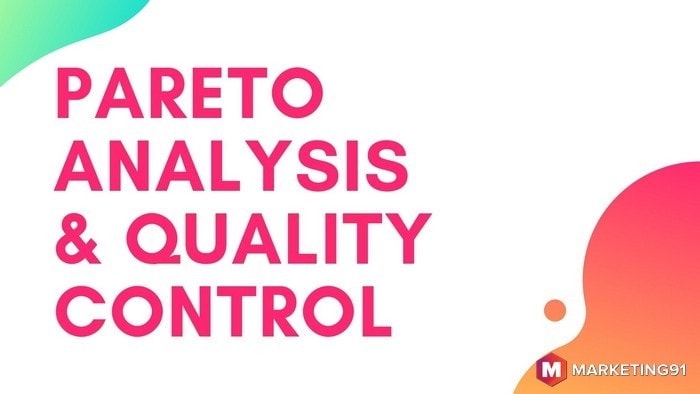
One of the important applications of Pareto chart analysis is to the field of QTC, i.e. Total quality control . It is one of the important tools which is used within the six sigma framework and used as mathematical models in order to track the performance of the company.
The statistical tool and the charts can be used for the analysis of data and thus forms one of the important competencies in project management . It is classified under the measurement and improvement of DMAIC, which is also known as define, measurement, analysis, improvement, and control.
Understanding if the Pareto principle is applied for a specific process is supposed to be very helpful for six sigma. While selecting the project, managers should ensure that the focus of their resources should be on such projects which are expected to deliver the most significant results.
Liked this post? Check out the complete series on Time Management
Related posts:
- The Pareto Principle – Meaning, Examples, Advantages and Application
- Project Organization – Definition, Types and Chart
- Organizational Justice – Meaning, Types and Applications
- What is Decision Analysis (DA)? Definition, Methods and Importance
- Key Opinion Leaders – Definition, Role, Benefits and Examples
- Charismatic Leadership – Definition, Characteristics, Examples, Pros and Cons
- What is Social Responsibility? – Definition, Understanding, Examples
- Ethical Leadership – Definition, Meaning, Importance, Principles and Examples
- Adaptive Leadership – Definition, Principles, Examples and Advantages
- Communication Design: Definition, Meaning, Types and Examples
About Hitesh Bhasin
Hitesh Bhasin is the CEO of Marketing91 and has over a decade of experience in the marketing field. He is an accomplished author of thousands of insightful articles, including in-depth analyses of brands and companies. Holding an MBA in Marketing, Hitesh manages several offline ventures, where he applies all the concepts of Marketing that he writes about.
All Knowledge Banks (Hub Pages)
- Marketing Hub
- Management Hub
- Marketing Strategy
- Advertising Hub
- Branding Hub
- Market Research
- Small Business Marketing
- Sales and Selling
- Marketing Careers
- Internet Marketing
- Business Model of Brands
- Marketing Mix of Brands
- Brand Competitors
- Strategy of Brands
- SWOT of Brands
- Customer Management
- Top 10 Lists
Leave a Reply Cancel reply
Your email address will not be published. Required fields are marked *
- About Marketing91
- Marketing91 Team
- Privacy Policy
- Cookie Policy
- Terms of Use
- Editorial Policy
WE WRITE ON
- Digital Marketing
- Human Resources
- Operations Management
- Marketing News
- Marketing mix's
- Competitors

Pareto Diagrams and Pareto Analysis

The Power of Pareto Diagrams and Pareto Analysis in Lean Six Sigma
In the process improvement and quality management world, Lean Six Sigma has long reigned as a potent methodology for enhancing efficiency and minimizing defects. A cornerstone of this methodology is the systematic approach to problem-solving, and one of the essential tools in this arsenal is the Pareto Diagram and the accompanying Pareto Analysis.
These tools empower organizations to identify and tackle the most significant issues plaguing their operations, resulting in substantial improvements and tangible benefits.
Understanding the Pareto Principle
At the heart of Pareto Diagrams and Pareto Analysis lies the Pareto Principle, also known as the 80/20 rule. This principle suggests that a significant majority of the effects come from a minority of the causes. In Lean Six Sigma, this translates to the idea that 80% of the problems stem from 20% of the causes. However, it’s essential to note that these percentages are not always rigid and can vary based on the context.
What is a Pareto Diagram?
A Pareto Diagram is a bar chart that displays data in descending order, with the tallest bars on the left and the shortest on the right. Each bar represents a specific issue or cause, and the height of the bar corresponds to the frequency, count, or cost of that issue. By presenting data in this manner, the Pareto Diagram allows for a quick visual assessment of the most critical issues within a process.
How to Create a Pareto Diagram
Creating a Pareto Diagram involves a few simple steps:
- Identify the Problem : Identify the problem you want to address or the data you wish to analyze.
- Gather Data : Collect data on the causes or factors contributing to the problem. This data can be in the form of defects, errors, complaints, or any other relevant metric.
- Categorize and Count : Group similar causes and count the occurrences. This categorization helps condense the data into a manageable form.
- Rank Causes : Arrange the causes in descending order based on their frequency or impact. The most significant cause should be on the left, and the least significant on the right.
- Create the Chart : Construct the Pareto Diagram with bars representing each cause and their respective counts.

The Power of Pareto Analysis
While the Pareto Diagram helps visualize the distribution of issues, Pareto Analysis delves deeper into problem-solving by prioritizing these issues. The essential steps of Pareto Analysis include:
- Calculate Cumulative Percentage : Determine the cumulative percentage of the causes by adding up the percentages as you move down the list.
- Set a Threshold : Decide on a threshold for the cumulative percentage, often around 80%. This threshold helps identify the vital few causes.
- Focus on Vital Few : Concentrate efforts on addressing the causes that cross the threshold. These are the “vital few” that contribute significantly to the problem.
Application in Lean Six Sigma
Pareto Diagrams and Pareto Analysis are invaluable tools in the Lean Six Sigma methodology for various reasons:
- Focus on High-Impact Issues : By identifying the most significant issues, Lean Six Sigma teams can prioritize their efforts and resources effectively. This focus ensures that the most pressing problems are addressed first, leading to substantial improvements in a shorter time frame.
- Data-Driven Decision Making : These tools are based on concrete data, allowing organizations to make decisions backed by facts rather than assumptions or intuition.
- Efficient Resource Allocation : Lean Six Sigma projects often operate under constraints, be it time, budget, or personnel. Pareto Analysis helps allocate resources where they matter most, optimizing the return on investment.
- Continuous Improvement : The Pareto Principle isn’t static; it can change over time. As a result, organizations can continuously monitor their processes and adapt to evolving circumstances.
- Enhanced Communication : Pareto Diagrams are an excellent communication tool for sharing insights with team members, stakeholders, and leadership. They provide a clear visual representation of the problem landscape.
An Example of Pareto Analysis
Let’s consider a hypothetical example of Pareto Analysis in a manufacturing setting to illustrate how this technique is used to prioritize and address issues.
Scenario: Imagine a company that produces electronic devices, and they have been experiencing a growing number of product defects. To improve product quality, they decide to conduct a Pareto Analysis to identify and address the most significant causes of these defects.
Steps in the Pareto Analysis:
- Data Collection: The first step is to collect data on the various causes of defects. This may involve categorizing defects based on their root causes, such as manufacturing process errors, supplier issues, design flaws, and so on.
- Manufacturing Process Errors: 60% of defects
- Supplier Issues: 25% of defects
- Design Flaws: 10% of defects
- Operator Errors: 5% of defects
- Manufacturing Process Errors (60%)
- Supplier Issues (25%)
- Design Flaws (10%)
- Operator Errors (5%)
- Manufacturing Process Errors + Supplier Issues (60% + 25% = 85%)
- Manufacturing Process Errors + Supplier Issues + Design Flaws (60% + 25% + 10% = 95%)
- All Causes (100%)
- Setting a Threshold: In many cases, a common threshold is 80%. In this example, we’ll use 80% as the threshold for identifying the “vital few” causes.
- Focus on Vital Few: Based on the Pareto Analysis, the “vital few” causes, which cross the 80% threshold, are Manufacturing Process Errors (60%) and Supplier Issues (25%). These are the top priority causes to address.
Action Plan: With this analysis, the company can now focus its improvement efforts on addressing manufacturing process errors and supplier issues. By doing so, they are likely to experience a significant reduction in defects and an improvement in product quality.
This is a simplified example, but in a real-world context, the causes and defects may be more numerous and complex. Pareto Analysis, however, remains a valuable tool for identifying and prioritizing the key issues that need attention, enabling organizations to target their resources and efforts where they will have the most significant impact on process improvement.
How a Six Sigma Black Belt would use Pareto Diagrams and Pareto Analysis.
A Six Sigma Black Belt is a highly skilled and experienced professional in the field of Lean Six Sigma. They play a critical role in driving process improvement and quality management within an organization. When it comes to using Pareto Diagrams and Pareto Analysis, a Six Sigma Black Belt would leverage these tools in the following ways:
- Problem Identification and Selection: A Black Belt begins by identifying areas within the organization that require improvement. They may use data, feedback, or performance metrics to pinpoint problems or opportunities for enhancement. Once a problem is identified, a Pareto Diagram can be employed to assess which issues within that problem are most critical. For example, suppose they are dealing with customer complaints. In that case, they might categorize the complaints by type (e.g., product defects, shipping issues, billing problems) and use a Pareto Diagram to prioritize the most frequent or severe complaint types.
- Data Collection and Analysis: Data is the lifeblood of any Six Sigma project, and Black Belts are experts at collecting, organizing, and analyzing data. They would gather data related to the identified issues, and then use Pareto Analysis to determine which factors or causes contribute the most to those issues. This involves counting occurrences and calculating percentages to rank the causes in order of importance.
- Root Cause Analysis: Once the Pareto Analysis is complete, a Black Belt will delve into the “vital few” causes identified by the analysis. They would conduct a more detailed investigation to determine the root causes of these problems. This might involve process mapping, Fishbone diagrams (Ishikawa), or other tools to understand why these issues occur.
- Solution Development: With a clear understanding of the root causes, a Black Belt can then develop and propose solutions to address the vital few issues. These solutions are typically data-driven and aim to eliminate or mitigate the root causes identified. The goal is to improve processes and reduce defects or problems in a meaningful way.
- Project Planning and Execution: Black Belts are skilled project managers and will create a project plan for implementing the proposed solutions. This plan includes setting goals, defining tasks, assigning responsibilities, and establishing timelines. The Black Belt will work with cross-functional teams to ensure the project is executed effectively.
- Continuous Monitoring and Control: A Black Belt’s job is not over even after the project is completed and solutions are implemented. They will continue monitoring the process to ensure that the improvements are sustained and the issues do not reoccur. Pareto Diagrams can be used for ongoing monitoring, with data collected over time to ensure that the vital few causes remain under control.
- Reporting and Communication: Black Belts will use Pareto Diagrams and Pareto Analysis throughout the project to communicate progress and results to stakeholders. The visual representation of data in the form of Pareto Diagrams is often more accessible and persuasive than raw data.
- Training and Coaching: Black Belts often train and mentor Green Belts and other team members involved in Lean Six Sigma projects. They would teach them how to effectively use tools like Pareto Diagrams and Pareto Analysis.
A Six Sigma Black Belt uses Pareto Diagrams and Pareto Analysis as part of a comprehensive approach to identifying, prioritizing, and solving problems in a data-driven, systematic manner. These tools help them target their efforts efficiently, resulting in significant improvements in quality, efficiency, and customer satisfaction within an organization.
Common Issues Associated with Using Pareto Diagrams and Pareto Analysis.
While Pareto Diagrams and Pareto Analysis are powerful tools for problem prioritization and decision-making, they are not without their common challenges and issues. Understanding these challenges is essential for effectively employing these techniques in Lean Six Sigma projects and other problem-solving contexts.
- Data Quality and Availability: One of the primary challenges associated with Pareto Analysis is the quality and availability of data. You need accurate and comprehensive data to create a meaningful Pareto Diagram and conduct a reliable analysis. In practice, data may be incomplete, inconsistent, or unreliable, which can lead to inaccurate prioritization and flawed decision-making. Therefore, ensuring data quality through data validation and cleansing processes is critical. Additionally, there may be instances where the data needed for analysis is simply not available, making it impossible to conduct a thorough Pareto Analysis.
- Subjectivity in Cause Categorization: Another common issue with Pareto Analysis is the subjective nature of cause categorization. When identifying and categorizing the causes of a problem, there can be room for interpretation and bias. Different individuals or teams may categorize causes differently, which can result in variations in the Pareto Diagram’s outcome. To mitigate this issue, it’s important to establish clear criteria and guidelines for cause categorization and involve cross-functional teams in the process to ensure a more objective assessment.
- Static Nature of Analysis: Pareto Analysis provides valuable insights at a specific point in time. However, it is essential to recognize that the Pareto Principle and the factors contributing to problems can change over time. What was a vital few cause today might not hold the same importance in the future. Therefore, the static nature of Pareto Analysis can be limiting in dynamic environments. Organizations should incorporate regular data collection and analysis into their continuous improvement efforts to address this challenge, ensuring that the analysis remains relevant and up-to-date as processes evolve.
Pareto Diagrams and Pareto Analysis are indispensable tools for prioritizing problems and driving improvement. However, practitioners should remain vigilant about data quality, subjectivity in categorization, and the need for ongoing analysis to effectively address the common challenges associated with these tools. By acknowledging and addressing these issues, organizations can leverage Pareto Analysis to make data-driven decisions and achieve sustainable improvements in their operations.
In conclusion, Pareto Diagrams and Pareto Analysis are powerful tools within the Lean Six Sigma methodology that enable organizations to tackle their most significant operational challenges. By focusing efforts on the vital few causes, teams can drive meaningful improvements, enhance quality, and, ultimately, boost their competitiveness in today’s fast-paced business environment. In the pursuit of operational excellence, these tools are indispensable, enabling organizations to work smarter, not harder.
Six Sigma Certifications
Six Sigma Resource Center
Pareto Diagrams and Pareto Analysis Datasheet (.pdf)
- All Certifications
- Accessibility

Connect With Us
Copyright MSI. All Rights Reserved.
Many-Objective Grasshopper Optimization Algorithm (MaOGOA): A New Many-Objective Optimization Technique for Solving Engineering Design Problems
- Research Article
- Open access
- Published: 14 August 2024
- Volume 17 , article number 214 , ( 2024 )
Cite this article
You have full access to this open access article

- Kanak Kalita 1 , 2 ,
- Pradeep Jangir 3 , 4 , 5 ,
- Robert Čep 6 ,
- Sundaram B. Pandya 7 &
- Laith Abualigah 8 , 9 , 10 , 11
56 Accesses
Explore all metrics
In metaheuristic multi-objective optimization, the term effectiveness is used to describe the performance of a metaheuristic algorithm in achieving two main goals—converging its solutions towards the Pareto front and ensuring these solutions are well-spread across the front. Achieving these objectives is particularly challenging in optimization problems with more than three objectives, known as many-objective optimization problems. Multi-objective algorithms often fall short in exerting adequate selection pressure towards the Pareto front in these scenarios and difficult to keep solutions evenly distributed, especially in cases with irregular Pareto fronts. In this study, the focus is on overcoming these challenges by developing an innovative and efficient a novel Many-Objective Grasshopper Optimisation Algorithm (MaOGOA). MaOGOA incorporates reference point, niche preserve and information feedback mechanism (IFM) for superior convergence and diversity. A comprehensive array of quality metrics is utilized to characterize the preferred attributes of Pareto Front approximations, focusing on convergence, uniformity and expansiveness diversity in terms of IGD, HV and RT metrics. It acknowledged that MaOGOA algorithm is efficient for many-objective optimization challenges. These findings confirm the approach effectiveness and competitive performance. The MaOGOA efficiency is thoroughly examined on WFG1-WFG9 benchmark problem with 5, 7 and 9 objectives and five real-world (RWMaOP1- RWMaOP5) problem, contrasting it with MaOSCA, MaOPSO, MOEA/DD, NSGA-III, KnEA, RvEA and GrEA algorithms. The findings demonstrate MaOGOA superior performance against these algorithms.
Similar content being viewed by others

Many-Objective Whale Optimization Algorithm for Engineering Design and Large-Scale Many-Objective Optimization Problems

A Novel Hybrid Grasshopper Optimization Algorithm for Numerical and Engineering Optimization Problems

Multi-objective Geometric Mean Optimizer (MOGMO): A Novel Metaphor-Free Population-Based Math-Inspired Multi-objective Algorithm
Explore related subjects.
- Artificial Intelligence
Avoid common mistakes on your manuscript.
1 Introduction
Numerous practical scenarios are categorized as many-objective optimization problems (MaOPs), encompassing areas like engineering design, drone routing and large-scale issues [ 1 , 2 , 3 ]. This study investigates a specific MaOP,
where \(\boldsymbol{\Omega }\subseteq {\mathbb{R}}^{n}\) identifying the decision space as the realm of \({\varvec{x}}={({x}_{1},{x}_{2},\dots ,{x}_{n})}^{T}\) potential solutions. The objective space \(f:\boldsymbol{\Omega }\to {\mathbb{R}}^{m}\) is defined by multiple \(m\ge 4\) objectives, each requiring minimization. The Pareto Optimal Set (PS) is characterized as the decision-making domain formed by the aggregation of Pareto optimal solutions. In the realm of objective space, this set representation is known as the Pareto Optimal Front (PF). The primary objective in addressing a Multi-Objective Problem (MaOP) lies in pinpointing the PS shown in Fig. 1 .

Many-objective all definitions in search space of MaO-Problem
Approaches such as many-objective evolutionary algorithms (MaOEAs) [ 4 ] have been widely acknowledged in literature [ 5 ]. These population-driven methodologies strive to derive a suite of optimal solutions, which effectively converge and exhibit diversity [ 6 ] on the true Pareto front (PF) associated with MaOPs. Recent decades have seen the emergence of numerous MaOEAs, tailored for MaOPs [ 7 ] and demonstrating their effectiveness [ 8 ]. Despite their successes, the performance of MaOEAs, particularly those based on Pareto principles [ 9 ], in high-dimensional scenarios warrants further examination. A key challenge [ 10 ] in such contexts is the comparability of solutions; in high-dimensional spaces, the proportion of nondominated solutions escalates. This issue is exacerbated as the number of objectives increases, leading to diminished selection pressure [ 11 ]. A secondary challenge is the preservation of population diversity [ 12 ]. Traditional methods for diversity maintenance [ 13 ], like the \(k\) th nearest distance [ 14 ], crowding distance [ 15 ] etc. are not suitable for vast objective spaces. In order to overcome these challenges, a number of algorithms have been proposed and these can be classified into three main categories:
Pareto dominance-based strategies: Pareto dominance-based strategies redefine classical Pareto dominance as a way to better compare solutions. Methods such as fuzzy dominance [ 16 ], ϵ-dominance [ 17 ] and θ-dominance [ 18 ] utilize these advanced techniques for picking the solutions. For instance, Tian et al. [ 19 ] proposed a new dominance relation that combines convergence and diversity based on adaptive approaches. Also, Qiu et al. [ 20 ] introduced fractional dominance which makes the convergence faster by comparing the objective values of two solutions. Furthermore, a new method integrating classical dominance with convergence-based approach has been proposed and Zhang et al. [ 21 ] proposed the KnEA to improve convergence speed.
Indicator-based MaOEAs: Indicator-based MaOEAs employ certain metrics to assess the nondomination of solutions and steer the search procedure. Some of the commonly used metrics in this category are R2 indicator [ 22 ], S-metric [ 23 ], \({I}_{\varepsilon }\) indicator [ 24 ] and the hypervolume (HV) indicator [ 25 ]. HV-based MaOEAs [ 26 , 27 , 28 ] estimate the solutions by their contributions to the HV value and this flexibility allows the use of indicators within the IBEA framework [ 24 ].
Decomposition-based methods: Decomposition-based methods simplify complex multi-objective optimization problems (MaOPs) into subproblems [ 29 ] or a series of single-objective problems (SOPs) [ 30 ]. Algorithms such as MOEA/D [ 30 ], RVEA [ 31 ], Many-Objective Particle Swarm Optimizer (MaOPSO) [ 32 ], Many-Objective Sine Cosine Algorithm (MaOSCA) [ 33 ] and Non-Dominated Sorting Genetic Algorithm-III (NSGA-III) [ 13 ] are prominent in this area. MOEA/D optimizes each subproblem with data from adjacent subproblems to minimize computational complexity. NSGA-III uses a set of reference points to partition the objective space, enhancing diversity. From these principles, various environmental selection strategies have emerged, such as integrating dominance with decomposition methods (MOEA/DD) by Li et al. [ 34 ] and utilizing perpendicular distances from solutions to reference vectors by Yuan et al. [ 35 ]. Innovations such as adaptive weight adjustments during the evolutionary process [ 36 ], learning the distribution of reference vectors via a growing neural gas (GNG) network [ 37 ] and generating reference vectors through a modified k-means clustering technique [ 38 ].
Additionally, many MaOEAs do not align strictly with the above categories, such as the determinantal point process-based algorithm [ 39 ], adaptive clustering-based algorithm [ 40 ] and the two-archive algorithm [ 41 , 42 ], which maintains separate archives for convergence and diversity. Other notable methods are the dimension reduction and knowledge-guided solving algorithm [ 43 ], the voting-based algorithm [ 44 ], the two-stage algorithm [ 45 ] and the decision variable classification-based algorithm [ 46 ]. Ding et al. [ 44 ] introduced a multi-stage evolutionary strategy that uses knowledge fusion and a statistical guidance vector to identify concentrations of elite solutions through a voting method. Li et al. [ 45 ] structured objective optimization into two phases: a convergence stage where individuals compete and a diversity stage that focuses on selecting well-spaced solutions. Liu et al. [ 46 ] developed a novel decision variable classification method, increasing the likelihood of generating offspring with superior convergence and diversity.
Although there are numerous studies on MaOEAs, more work is required to address the issue of balance in terms of convergence [ 47 ] and diversity [ 48 ], particularly in high-dimensional problems [ 49 ]. There are other methods that have been proposed to address the issue of diversity in many-objective optimization such as the Grid-based Evolutionary Algorithm (GrEA) [ 50 ]. GrEA, therefore, effectively controls population diversity without using explicit density estimation through dividing the search space into a grid structure. Bi-goal Evolution (BiGE) [ 51 ] is another approach that focuses on two goals only, thus making the optimization process easier but without losing the ability to explore and exploit the search space effectively. Shift-based Density Estimation (SDE) [ 52 ] is another interesting approach to density estimation that shifts according to the distribution of solutions to guarantee the maintenance of solution diversity in high-dimensional objective space. These algorithms must not only retain variation in the population but also must have high selection pressure towards actual PFs.
This research paper is motivated by the need for effective approaches that can handle the intricacies of many-objective problems particularly, the challenges related to convergence to the Pareto front and maintaining solution diversity across it. Current strategies either fail to adequately converge or cannot ensure a well-spread set of solutions, especially when dealing with irregular Pareto fronts. This leads to suboptimal decision-making in practical applications. To address these gaps, the MaOGOA is proposed, an innovative approach that integrates Grasshopper Optimisation Algorithm (GOA) [ 53 ], reference point strategies, niche preservation and an IFM. It is specifically designed to improve both the convergence and diversity of solutions in many-objective problems.
This paper primary contributions are
The selection of GOA algorithm due to its distinct characteristics that are particularly suited to addressing the challenges of MaOPs. The key reasons for this choice are
GOA simulates the swarming behaviors of grasshoppers, which is a natural phenomenon noted for its efficiency in exploring and exploiting spatial resources.
The algorithm’s ability to dynamically balance between the different phases of search driven by its inherent components of social interaction, gravitational forces and wind advection.
It is shown that GOA is highly scalable and flexible, which are essential when addressing the fact that the objective space can be quite diverse in many-objective problems. Some of these are the degree of attraction or repulsion amongst the individuals which can be adjusted depending on the problem at hand to ensure that there is a reasonable spread of the population and yet getting close to the Pareto front.
Many-objective optimization problems have Pareto fronts that are complex and can be non-contiguous. GOA model, which is based on the differential movement of agents (grasshoppers), is best suited to tackle such scenarios. It can search for a larger set of regions in the search space and thus, identify more potential Pareto-optimal solutions.
This paper offers an IFM approach to overcome previous shortcomings that are related to the non-consideration of valuable information. In the IFM, the decision-making process is made using the weighted sum method to promote the historical information of the whole population to the next generation in order to increase the convergence.
The selection process is based on the reference point approach, which makes it possible to reach not just the true Pareto frontier and its closest solutions (convergence), but also to distribute solutions across the entire Pareto diagram (diversity). This is done by assigning each solution to the nearest reference point with the help of perpendicular distance measurement which helps in identifying the well explored region of the objective space. An NSGA-II algorithm uses non-dominated sorting which sorts solutions closer to the Pareto-optimal front and thus improves convergence.
A niche preservation strategy specifically targets boundary individuals to enhance diversity and mitigate overcrowding in certain areas of the objective space, thus improving the overall convergence rate of the algorithm. Additionally, a density estimation strategy is detailed to maintain diversity, ensuring both uniformity and broad coverage in the population distribution.
The efficacy of the newly developed MaOGOA is demonstrated through comparative analysis against algorithms such as MaOSCA, MaOPSO, MOEA/DD, NSGA-III, KnEA, RvEA and GrEA across the WFG1-WFG9 benchmark sets with objectives ranging from 5 to 9, as well as five real-world problems (RWMaOP1- RWMaOP5). These experiments highlight MaOGOA ability to adeptly handle a variety of problem types and its robust performance.
The structure of this paper is organized as follows: Sect. 2 offers an overview of GOA algorithm. Section 3 provides a detailed description of the proposed MaOGOA. Experimental results and discussions are presented in Sect. 4 . Finally, Sect. 5 concludes the paper and outlines future research directions.
2 Grasshopper Optimisation Algorithm
The GOA, initially introduced by Saremi et al. [ 53 ], is inspired by the swarming patterns of grasshoppers in nature and is utilized for addressing optimization challenges. Center of Gravity is based on the cohesive social behavior of grasshoppers. This swarming characteristic makes them fit naturally for explorative and exploitative tasks in a many-dimensional search domain. The GOA mathematical model successfully provides an overall representation of this balance. The social interaction, gravitational pull and wind advection in the model enable the specific elements of the algorithm to change their search behavior in an appropriate manner. This algorithm represents potential solutions to optimization problems through the positions of grasshoppers within a swarm. Grasshoppers exhibit a distinctive flight pattern, which is mathematically modeled in GOA shown in Fig. 2 . This model suggests that grasshopper movement is predominantly influenced by three components—social interaction, gravitational pull and wind advection.

Basic interaction patterns among individual grasshoppers within a group
The position of each grasshopper, labeled as \({X}_{i}\) , is expressed as
where \({S}_{i}\) signifies social interaction, \({G}_{i}\) denotes gravitational force and \({A}_{i}\) represents wind advection. The pivotal element in this model is social interaction which is calculated as
In these equations, \({d}_{ij}\) represents the distance between the \(i\) th and \(j\) th grasshopperand \(\widehat{{d}_{ij}}\) a unit vector directs from the \(i\) th and \(j\) th grasshopper. The social force, defined by the s function, is modifiable through parameters \(f\) and \(l\) . It important to note that the s function social forces diminish with increasing distances between grasshoppers. For effective interaction, grasshopper distances are mapped within the range of [ 1 , 4 ]. Gravitational influence on a grasshopper is described as,
In this context, \(g\) stands for the gravitational constant and \(\widehat{{e}_{g}}\) a unit vector points towards Earth center. The wind advection effect on grasshoppers is given as
where \(u\) is a constant drift and \(\widehat{{e}_{w}}\) a unit vector indicates wind direction. Consequently, Eq. ( 2 ) is elaborated as,
\(N\) denotes the total grasshoppers in the swarm. to enhance the optimization process, additional parameters are incorporated into the model, optimizing exploration and exploitation phases. The gravitational impact on grasshoppers is relatively minor and generally disregarded, while the wind direction (A component) is presumed to always orient towards the optimal solution \(\widehat{{T}_{d}}\) . The final form of the mathematical model is as,
In this equation, \(u{b}_{d}\) and \(l{b}_{d}\) are the upper and lower bounds in the \(d\) th dimension, respectively. \(\widehat{{T}_{d}}\) represents the \(d\) th dimension value in the optimal solution discovered so far. The parameter \(c\) evolves according to the equation below:
where \(cmax\) and \(cmin\) are the maximum and minimum values, respectively, \(l\) is the current iteration and \(L\) signifies the maximum iteration limit.
3 Proposed Many-Objective Grasshopper Optimization Algorithm
3.1 overview of maogoa.
MaOGOA is designed to address the complexities of many-objective optimization problems by effectively balancing exploration and exploitation, ensuring diversity and converging towards the Pareto front. This algorithm leverages the natural swarming behaviors of grasshoppers, modeled through social interaction, gravitational pull and wind advection mechanisms, to navigate the search space dynamically.
3.2 Initialization
MaOGOA commences with an initialization phase where a random population of size \(N\) is established. Each individual in this population represents a potential solution within a \(d\) -dimensional decision space, where \(d\) stands for the number of decision variables. The initial population is evaluated based on \(M\) objective functions, which define the initial objective space.
3.3 Generation of Reference Points
Following initialization, a set of reference points is generated using Das and Dennis technique. This technique strategically partitions the objective space to enhance the diversity of solutions and guide the search towards covering the entire Pareto front effectively. The number of reference points is approximately equal to the population size \(N\) , calculated as \(H=(\begin{array}{c}M+p-1\\ p\end{array})\) , where \(p\) is the number of partitions.
3.4 Grasshopper Optimization Mechanism
Each iteration of MaOGOA involves updating the position of each grasshopper (solution) in the search space. The position update is influenced by three main components:
Social Interaction \({S}_{i}\) : Each grasshopper adjusts its position relative to others based on their proximity, promoting local exploration.
Gravitational Pull \({G}_{i}\) : A collective movement towards better solutions, facilitating exploitation.
Wind Advection \({A}_{i}\) : Random perturbations that prevent premature convergence and encourage global exploration.
The position update formula for each grasshopper \({X}_{i}\) is given in Eq. ( 1 ).
3.5 Information Feedback Mechanism (IFM)
A novel aspect of MaOGOA is the incorporation of an IFM. This mechanism integrates historical performance data to adjust the search dynamically. For each grasshopper, a weighted combination of its own past position and the best positions encountered so far is used to update its position, enhancing the algorithm ability to converge on optimal solutions while maintaining diversity.
3.6 Environmental Selection and Niche Preservation
After updating the positions of grasshoppers, the total population, including both parents and offspring, undergoes evaluation. The individuals are organized into non-dominated fronts and selection is focused on preserving a diverse and high-quality solution set. This process are
Niche Preservation: Ensuring that solutions spread across all regions of the objective space, particularly focusing on less crowded niches.
Density Estimation: Evaluating the density around each solution to avoid overcrowding and maintain diversity.
The selection process emphasizes maintaining a balance between convergence towards the Pareto front and diversity across it.
3.7 Algorithm Termination
The MaOGOA algorithm progresses through these stages until a specified termination criterion is met, which may be a predefined number of generations, a convergence threshold, or another problem-specific benchmark. At the end of the process, the algorithm delivers a set of diverse, high-quality solutions that approximate the Pareto front effectively. The main process of MaOGOA can be expressed as follows:
MaOGOA algorithm starts with a random population of size \(N\) , \(M\) no. of objectives, \(p\) no. of partitions and generate a set of reference points using Das and Dennis technique \(H=(\begin{array}{c}M+p-1\\ p\end{array})\) , as \(H\approx N\) . the current generation is \(t,{x}_{i}^{t}\) and \({x}_{i}^{t+1}\) the \(i\) th individual at \(t\) and \((t+1)\) generation. \({u}_{i}^{t+1}\) the \(i\) th individual at the \((t+1)\) generation generated through the GOA algorithm and parent population \({P}_{t}\) . the fitness value of \({u}_{i}^{t+1}\) is \({f}_{i}^{t+1}\) and \({U}^{t+1}\) is the set of \({u}_{i}^{t+1}\) . Next, \({x}_{i}^{t+1}\) is computed according to \({u}_{i}^{t+1}\) generated through the GOA algorithm and IFM as per Eq. ( 12 )
where \({x}_{k}^{t}\) is the \(k\) th individual we chose from the \(t\) th generation, the fitness value of \({x}_{k}^{t}\) is \({f}_{k}^{t},{\partial }_{1}\) and \({\partial }_{2}\) are weight coefficients. Generate offspring population \({Q}_{t}\) . \({Q}_{t}\) is the set of \({x}_{i}^{t+1}.\) The combined population \({R}_{t}={P}_{t}\cup {Q}_{t}\) is sorted into different w -non-dominant levels \(\left({F}_{1},{F}_{2},\dots ,{F}_{l}\dots ,{F}_{w}\right)\) . Begin from \({F}_{1}\) , all individuals in level 1 to \(l\) are added to \({S}_{t}\) and remaining members of \({R}_{t}\) are rejected. If \(\left|{S}_{t}\right|=N\) ; no other actions are required and the next generation is begun with \({P}_{t+1}={S}_{t}\) . Otherwise, solutions in \({S}_{t}/{F}_{l}\) are included in \({P}_{t+1}={S}_{t}/{F}_{l}\) and the rest \(\left(K=N-\left|{P}_{t+1}\right|\right)\) individuals are selected from the last front \({F}_{l}\) (presented in Algorithm 1). For selecting individuals from \({F}_{l}\) , we use a niche-preserving operator First, each population member of \({P}_{t+1}\) and \({F}_{l}\) is normalized (presented in Algorithm 2) using the current population spread so that all objective vectors and reference points have commensurate values. Thereafter, each member of \({P}_{t+1}\) and \({F}_{l}\) is associated (presented in Algorithm 3) with a specific reference point using the shortest perpendicular distance \((d())\) of each population member with a reference line created by joining the origin with a supplied reference point. Then, a careful niching strategy (described in Algorithm 4) that improve the diversity of MaOGOA algorithm is employed to choose those \({F}_{l}\) members that are associated with the least represented reference points niche count \({\rho }_{i}\) in \({P}_{t+1}\) and check termination condition is met. If the termination condition is not satisfied, \(t=t+1\) than repeat and if it is satisfied, \({P}_{t+1}\) is generated, it is then applied to generate a new population \({Q}_{t+1}\) by GOA algorithm. Such a careful selection strategy is found to computational complexity of \(M\) -Objectives \(O\left({N}^{2}{\text{log}}^{M-2}N\right)\) or \(O\left({N}^{2}M\right)\) , whichever is larger. The MaOGOA algorithm, integrating the IFM, effectively directs the search towards improved convergence, coverage and diversity, essential for many-objective optimization. Importantly, the algorithm operates without requiring additional parameters beyond standard GOA settings such as population size and termination criteria.

The flowchart of MaOGOA algorithm can be shown in Fig. 3 .

Flowchart of MaOGOA algorithm
4 Results and Discussion
4.1 experimental settings, 4.1.1 benchmarks.
To evaluate the MaOGOA effectiveness, this research utilizes the WFG1-WFG9 [ 54 ] benchmark (Appendix A) along with five real-world engineering design challenges (Appendix B). Car cab design (RWMaOP1) [ 55 ], 10-bar truss structure (RWMaOP2) [ 56 ], water and oil repellent fabric development (RWMaOP3) [ 57 ], ultra-wideband antenna design (RWMaOP4) [ 58 ] and liquid-rocket single element injector design (RWMaOP5) [ 59 ] are the five considered real-world engineering design problems. The WFG problems define the number of decision variables as \(k+l\) , with \(k\) equating to \(M-1\) and \(l\) being 10.
4.1.2 Comparison Algorithms and Parameter Settings
The performance of MaOGOA is assessed by conducting empirical comparisons against leading multi-objective algorithms (MOAs) like MaOPSO [ 32 ], MaOSCA [ 33 ], MOEA/DD [ 34 ], NSGA-III [ 13 ], KnEA [ 21 ], RvEA [ 31 ] and GrEA [ 50 ]. The testing environment consists of Matlab R2020a on an Intel Core i7-9700 CPU. Each algorithm is executed 30 times with varying population sizes: \(N\) is set to 210, 156 and 276, corresponding to objective problems with \(M\) =5, 7 and 9, respectively. The maximum number of function evaluations ( \(MaxFEs\) ) for each test is capped at 10,000.
4.1.3 Performance Measures
To ensure a robust assessment of the proposed algorithm, this paper adopts quality evaluation metrics Hypervolume \((HV)\) and Run Time \((RT)\) , each chosen for their proven reliability and relevance in current many-objective optimization where the true Pareto fronts are unknown [ 60 ]. Additionally, Inverse Generational distance \((IGD)\) metric is also used where the true Pareto fronts are known. \(HV\) and \(IGD\) metric help in providing a more accurate representation of an algorithm performance across both convergence and diversity, shown in Table 1 and Fig. 4 . A higher value of \(HV\) , lower value of \(IGD\) and \(RT\) refers to better performance. As per the guidelines outlined in [ 61 ], using IGD without a known Pareto front can indeed result in biased evaluations. This insight is vital, especially for the real-world application scenarios, where the true Pareto fronts are not predetermined. The Wilcoxon rank sum test (WRST), conducted at a 0.05 significance level, is used to analyze performance variations—indicating superior (“ + ”), inferior (“−”), or equivalent (“ = ”) outcomes when compared to MaOGOA. Additional statistical evaluations, such as the Friedman rank test, are employed to comprehensively assess the differences in performance between MaOGOA and other algorithms.

Mathematical and schematic view of a IGD and b HV metrics
4.2 Experimental Results on WFG Problems
Table 2 illustrates MaOGOA effectiveness relative to established algorithms like MaOSCA, MaOPSO, MOEA/DD, NSGA-III, KnEA, RvEA and GrEA within the WFG benchmark suite. This effectiveness is measured using the Inverted Generational Distance (IGD) metric, which evaluates the solution sets’ convergence and diversity towards the true Pareto front. Lower IGD values are preferred as they signify solution sets that are not only closer to, but also more diverse within, the Pareto front. In the WFG1 problem with 5 objectives and 14 decision variables, MaOGOA outperforms all the other algorithms with an IGD value of 0.963 ± 0.033, suggesting its superior ability to PF closely while maintaining diversity in the solutions. As the complexity increases to 7 objectives and 16 decision variables in WFG1, MaOGOA maintains a commendable IGD value of 1.328 ± 0.101, standing out as the algorithm with the closest proximity to the PF like MaOPSO and MOEA/DD, which exhibit higher IGD values. A trend of MaOGOA efficiency is further seen in WFG2, where for 5 objectives and 14 decision variables, it achieves an IGD of 0.528 ± 0.023, again surpassing other algorithms in finding a diverse and accurate representation of the Pareto front. Notably, in WFG3 for 9 objectives and 18 decision variables, MaOGOA demonstrates a significantly better performance with an IGD of 1.813 ± 0.032, highlighting its scalability and robustness even in higher dimensional objective spaces. In WFG6 with 7 objectives, MaOGOA performance remains strong, recording an IGD of 2.583 ± 0.021, which is considerably lower than MaOPSO and MOEA/DD. This reflects MaOGOA persistent ability to generate high-quality solutions across various problem configurations. WFG8 and WFG9 follow the same pattern, with MaOGOA consistently showing lower IGD values such as 2.679 ± 0.012 and 2.497 ± 0.007, respectively, for problems with 7 objectives and 16 decision variables. This is indicative of MaOGOA efficient exploration and exploitation capabilities, resulting in better coverage of the Pareto front.
The \(p\) values from the Wilcoxon signed-rank test are detailed in Table 3 , indicating significant superiority of MaOGOA over other conventional algorithms. Specifically, MaOGOA outperformed MaOSCA, MaOPSO, MOEA/DD, NSGA-III, KnEA, RvEA and GrEA in 5, 6, 1, 6, 3, 5 and 3 instances, respectively, with \(p\) values below 0.05, showcasing notable effects. Moreover, the Friedman test revealed fewer instances where MaOGOA performed worse than the mentioned algorithms: 2, 1, 6, 1, 4, 2 and 4 cases, respectively.
To visually demonstrate MaOGOA’s efficiency, the average Inverted Generational Distance (IGD) convergence curves and box plots over 30 runs of all algorithms on the WFG benchmark problems are displayed in Figs. 5 and 6 , respectively. MaOGOA is significantly superior to MaOSCA, MaOPSO, MOEA/DD, NSGA-III, KnEA, RvEA and GrEA algorithms, which shows that the MaOGOA has the ability to jump out from the local optimal in the iterative process and reaches a near-optimal solution more quickly. From these results, it is evident that MaOGOA is not only competitive but often surpasses the performance of other state-of-the-art algorithms in terms of the IGD metric across the WFG test suite. The consistently lower IGD values achieved by MaOGOA shown its capacity for generating well-distributed and accurate approximations of the Pareto front shown in Fig. 7 , making it a highly reliable option for complex many-objective optimization problems.

Convergence curve based on the IGD metric for WFG problems

Box plot based on the IGD metric for WFG problems

Best Pareto optimal fronts for WFG problems
Table 4 presents the Hypervolume (HV) performance metrics for the optimization algorithms MaOSCA, MaOPSO, MOEA/DD, NSGA-III, KnEA, RvEA, GrEA and MaOGOA across WFG test problems involving 5, 7 and 9 objectives. The Hypervolume metric is crucial in many-objective optimization because it quantitatively assesses an algorithm’s ability to cover the Pareto front. A higher HV value is preferable, as it signifies a more extensive coverage of the objective space by the algorithm’s solutions, indicating superior performance in terms of both convergence to and diversity within the Pareto front. In WFG1, the MaOGOA algorithm exhibits commendable results with HV values of 0.671, 0.664 and 0.493 for the 5, 7 and 9-objective cases, respectively. These values consistently outperform those achieved by other algorithms like MaOSCA, MaOPSO and NSGA-III, highlighting MaOGOA dominance in various many-dimensional objective spaces. In WFG2, MaOGOA maintains a leading stance, with HV values consistently above 0.943, 0.947 and 0.947 for the 5, 7 and 9-objective instances, respectively. The algorithm demonstrates superior performance, although closely followed by GrEA and RvEA. WFG3 presents a unique challenge where for the 5-objective case, MaOGOA achieves the highest HV value reported as 0.103, significantly surpassing all compared algorithms. However, for the 7-objective case, the HV metric drops to 0.242, respectively, indicating a diminishing performance as the number of objectives increases, a trend observed across all algorithms for this problem. In the WFG4 scenario, MaOGOA consistently displays robust HV values of 0.718, 0.78 and 0.845 for 5, 7 and 9-objective problems, respectively. It demonstrates not only the ability of MaOGOA to handle an increasing number of objectives but also its potential to outperform other algorithms such as KnEA and MOEA/DD, especially as the complexity of the problem space increases. For WFG5, the HV metric for MaOGOA is impressive, indicating better Pareto front coverage than most other algorithms across all objective instances, although it sees some competition from GrEA and RvEA in the 5-objective case. In WFG6, the HV values for MaOGOA are consistently high, although it is closely followed by other algorithms, especially in the 9-objective case. This suggests that while MaOGOA is effective, there is strong competition and it does not always hold a clear lead. WFG7 results show that MaOGOA has HV values indicating superior Pareto front coverage across the 5, 7 and 9-objective cases, with performance generally superior to that of MOEA/DD and NSGA-III, although it does not always outperform RvEA. For WFG8, MaOGOA performance is robust in the 5-objective case but sees a slight decrease in the 7 and 9-objective scenarios, where it remains competitive but does not always secure the top position, particularly against the strong performance of GrEA in the 9-objective case. Lastly, in WFG9, MaOGOA shows a high HV in the 5-objective case and remains competitive in the 7 and 9-objective instances, although it is closely matched by RvEA and surpassed by GrEA in the 9-objective scenario.
In addition to the initial experiments, Table 5 outlines the \(p\) values from the Wilcoxon signed-rank test, highlighting MaOGOA’s significant advantage over other foundational algorithms. Specifically, MaOGOA outperformed MaOSCA, MaOPSO, MOEA/DD, NSGA-III, KnEA, RvEA and GrEA in 11, 11, 11, 9, 9, 11 and 1 instances, respectively, with all corresponding \(p\) values falling below 0.05, indicating a significant effect. Furthermore, the Friedman test shows fewer instances where MaOGOA performed worse than these algorithms: 0, 0, 0, 2, 2, 0 and 11 cases, respectively. Collectively, these results highlight MaOGOA’s statistical significance in comparison to these established algorithms. To show the efficiency of MaOGOA clearly, the average HV convergence curves and box plot over 30 times run of all algorithms on WFG benchmark problems are plotted in Figs. 8 and 9 , respectively. MaOGOA is significantly superior to MaOSCA, MaOPSO, MOEA/DD, NSGA-III, KnEA, RvEA and GrEA algorithms, which shows that the MaOGOA has the ability to jump out from the local optimal in the iterative process and reaches a near-optimal solution more quickly. The overall performance of the MaOGOA algorithm, characterized by high HV values, elucidates its ability to cover a larger volume of the Pareto front effectively. It exhibits robustness in problems with a lower number of objectives and maintains competitive efficacy as the complexity increases, although it faces stiff competition from other algorithms, notably RvEA and GrEA, in higher dimensional objective spaces.

Convergence curve based on the HV metric for WFG problems

Box plot based on the HV metric for WFG problems
Table 6 demonstrates the runtime efficiency (RT) of MaOGOA against other leading many-objective evolutionary algorithms across various WFG test problems. The RT metric, where lower values are indicative of superior computational efficiency, is utilized as the basis for this comparative analysis. For instance, in the WFG1 problem with 5 objectives (M) and 14 decision variables (D), MaOGOA showcases its computational prowess with a RT of 0.59 s. This outperforms MaOSCA, MOEA/DD and NSGA-III, which have higher RTs of 1.86 s, 2.04 s and 1.19 s, respectively. Notably, as the complexity of the problem increases to 9 objectives and 18 decision variables in WFG1, MaOGOA maintains its efficiency with a RT of 0.52 s, whereas algorithms like MOEA/DD and KnEA show RTs of 3.20 s and 7.26 s, demonstrating a more significant computational load. In the WFG2 scenario with 7 objectives and 16 decision variables, MaOGOA still maintains a higher RT of 0.48 s while others such as MaOPSO and RvEA have RTs of 0.8 s and 0.76. In WFG3 with 5 objectives and 14 decision variables which have shown RT of 0.44 s. This is considerably lower than the RTs claimed by MaOSCA and MOEA/DD at 1.81 s and 3.77 s, which further supports MaOGOA’s ability to efficiently explore the search space with less computational power. For WFG7 problem with 9 objectives and 18 decision variables in the higher dimensional objective space, MaOGOA achieves an RT of 0.5 s. This is in stark contrast to KnEA and MOEA/DD which have RTs of 1.02 s and 5.5 s, respectively, highlighting the scalability and efficiency of MaOGOA in handling complex many-objective optimization problems. MaOGOA consistent outperformance in RT across the WFG suite, such as on an average 0.51 s in WFG8 and 0.53 s in WFG9 respectively, signifies its superiority in speed efficiency. This trend of fast solution convergence towards better solutions using MaOGOA is evident irrespective of the types of WFG problems and configurations. This enables MaOGOA to be an excellent choice for solving LSMOP problems where computational time is of the essence.
4.3 Experimental Results on RWMaOP Problems
As seen in Table 7 , for RWMOPs, MaOGOA demonstrates exceptional performance as per HV metric. In RWMaOP1, with 9 objectives and 7 decision variables, the HV of MaOGOA is 0.003 ± 0.00016, which is the highest among the compared algorithms indicating it provides the most exhaustive coverage of the Pareto front for this problem. Similarly, for RWMaOP2 with 4 objectives and 10 decision variables, MaOGOA has an HV of 0.085 ± 0.00017, significantly outperforming the other algorithms. In the case of RWMaOP3 with 7 objectives and 3 decision variables, MaOGOA HV achieves 0.018 ± 0.00019. In RWMaOP4, with 5 objectives and 6 decision variables, MaOGOA exhibits an excellent HV of 0.523 ± 0.0003, which is the highest among the tested algorithms. For RWMaOP5, which has 4 objectives and 4 decision variables, MaOGOA HV value of 0.553 ± 0.00085 is once again the highest, showing its consistent performance in capturing a wide and diverse set of optimal solutions.
Table 8 details the results of the Friedman test and the \(p\) values from the Wilcoxon signed-rank test, affirming MaOGOA significant superiority over other algorithms. Specifically, MaOGOA demonstrated better performance compared to MaOSCA, MaOPSO, MOEA/DD, NSGA-III, KnEA, RvEA and GrEA. Each of these comparisons yielded \(p\) values less than 0.05, highlighting the substantial impact and effectiveness of MaOGOA. To show the efficiency of MaOGOA clearly, the average HV convergence curves and box plot over 30 times run of all algorithms on RWMaOP problems are plotted in Figs. 10 and 11 , respectively. MaOGOA is significantly superior to MaOSCA, MaOPSO, MOEA/DD, NSGA-III, KnEA, RvEA and GrEA algorithms, which shows that the MaOGOA has the ability to jump out from the local optimal in the iterative process and reaches a near-optimal solution more quickly. Overall, the HV results indicate that MaOGOA is highly capable of identifying solutions that cover a large extent of the Pareto front shown in Fig. 12 , outperforming other algorithms in all the given cases. This capacity is essential for obtaining a broad representation of the optimal trade-offs between objectives in many-objective optimization problems. The consistent high performance of MaOGOA across various real-world problems establishes it as a robust and proficient algorithm for solving complex optimization problems that require a rich diversity of high-quality solutions.

Convergence curve based on HV metric for RWMaOPs

Box plots based on the HV metric for RWMaOPs

Best Pareto optimal fronts for RWMaOPs
From Table 9 , the overall running time of the MaOGOA is consistently the lowest among the compared algorithms, indicating its superior computational efficiency. For the Car Cab Design problem (RWMaOP1), MaOGOA running time is 0.47 s, which represents approximately 21%, 18%, 64% and 10% of the runtimes of NSGA-III, MaOPSO, MaOSCA and RvEA, respectively. Similarly, for the 10-Bar Truss Structure problem (RWMaOP2), MaOGOA running time of 5.68 s accounts for 94%, 78% and 75% of the runtimes of NSGA-III, MaOPSO and MaOSCA, respectively. In each of these cases, MaOGOA running time is significantly lower than that of its competitors, particularly excelling with running times of 0.31 s for RWMaOP3, 0.29 s for RWMaOP4 and 0.29 s for RWMaOP5, which are significantly lower than the next best performing algorithms. In comparison to MOEA/DD, NSGA-III, MaOPSO, MaOSCA, KnEA, GrEA and RvEA. The MaOGOA algorithm showcased enhanced performance across all five evaluated cases, featuring significantly reduced running times, which highlights its efficiency in various engineering optimization contexts. Consequently, the experimental data in Table 9 lead to the conclusion that MaOGOA not only operates at a swifter pace but also achieves greater search efficiency and effectiveness in addressing many-objective optimization challenges.
4.4 Discussion
MaOGOA incorporates a sophisticated niche preservation strategy which is crucial for maintaining diversity in the population. This method is highly useful in preventing the elimination of better solutions at the initial stages, a common occurrence in competitive environments; a weakness inherent in most algorithms. The incorporation of the IFM in MaOGOA represents a marked improvement over conventional feedback procedures in evolutionary algorithms. It uses past performance information to modify the search process on the fly, directing the computation towards promising areas of the search space. Through gathering and applying feedback data across generations, MaOGOA provides for a more directed and efficient search, which is faster in terms of convergence, while also providing for better quality of solutions. Unlike static reference point methods that are employed by other algorithms, MaOGOA incorporates dynamic reference points that adjust with the population. This dynamic adjustment helps in achieving a better coverage and spread of the nondominated solutions since the reference points better reflect the current Pareto front. Compared to other optimization techniques, MaOGOA has less sensitivity to changes in parameters, thereby making the algorithm more versatile to different problem contexts. This robustness is due to mechanisms that are able to learn and adjust the trade-off between exploration and exploitation without the need for fine-tuning of parameters. It was found that the performance advantage of MaOGOA is more significant in higher dimensional objective spaces. This is due to its high performance in dealing with non-linear Pareto fronts and its capacity in keeping the distribution of solutions reasonable across these fronts especially in many-objective problem. These features in combination result in slightly better performance of MaOGOA compared to other algorithms. However, it should also be emphasized that the extent of improvement depends on certain parameters of the problem and the decision space, including the number of objectives. Additional statistical analysis and more comprehensive comparisons supported these observations, showing that MaOGOA has comparable or even better performance than the other methods and outperforms other algorithms when it is difficult to find a meaningful balance between convergence and diversity.
5 Conclusions
In this research, a new Many-Objective Grasshopper Optimization Algorithm known as MaOGOA is proposed to solve MaOPs due to difference PF shapes. Likewise, MaOGOA employs a reference point and niche preserve, which successfully partitions a favorable subset in the objective space. This process ensures both high-quality convergence and the preservation of solution diversity for subsequent selection phases. The algorithm further integrates to IFM improve both the convergence and the spread of solutions. The efficacy of MaOGOA was validated by benchmarking it against four established algorithms—MaOSCA, MaOPSO, MOEA/DD, NSGA-III, KnEA, RvEA and GrEA across test suite like WFG1-WFG9 with 5, 7and 9 objectives. Results demonstrate MaOGOA robust capability to balance solution convergence and diversity in terms of IGD, HV and RT. Additionally, its application to the real-world RWMaOP1-RWMaOP5 problems showcased MaOGOA competitive edge in practical scenarios. The standout feature of MaOGOA is its overall excellence, primarily due to the IFM mechanism that adeptly balances convergence, uniformity and diversity in solution distribution.
Future research directions exploring more potent techniques for many-objective optimization challenges and developing finer strategies for these issues. Investigating the application of MaOGOA preselection strategy in different contexts, such as multi-objective neural architecture search within deep neural networks for medical image segmentation, also presents a promising avenue for further study.
Data Availability
The data presented in this study are available through email upon request to the corresponding author.
Palakonda, V., Kang, J.-M.: Pre-DEMO: preference-inspired differential evolution for multi/many-objective optimization. IEEE Trans. Syst. Manand Cybern. Syst. 53 (12), 7618–7630 (2023). https://doi.org/10.1109/TSMC.2023.3298690
Article Google Scholar
Ishibuchi, H., Tsukamoto, N. and Nojima, Y., 2008, June. Evolutionary many-objective optimization: A short review. In: 2008 IEEE congress on evolutionary computation (IEEE world congress on computational intelligence) (pp. 2419–2426). IEEE.
Li, B., Li, J., Tang, K., Yao, X.: Many-objective evolutionary algorithms: a survey. ACM Comput. Surv. (CSUR) 48 (1), 1–35 (2015)
Liu, S., Lin, Q., Li, J., Tan, K.C.: A survey on learnable evolutionary algorithms for scalable multiobjective optimization. IEEE Trans. Evol. Comput. 27 (6), 1941–1961 (2023). https://doi.org/10.1109/TEVC.2023.3250350
Yuan, J., Liu, H.-L., Gu, F., Zhang, Q., He, Z.: Investigating the properties of indicators and an evolutionary many-objective algorithm using promising regions. IEEE Trans. Evol. Comput. 25 (1), 75–86 (2021). https://doi.org/10.1109/TEVC.2020.2999100
Fonseca, C. M., Fleming, P. J., Zitzler, E., Deb, K., & Thiele, L. (2003). Evolutionary multicriterion optimization. In Second International Conference, EMO 2003. Springer.
Wang, Y., Liu, Z., Wang, G.-G.: Improved differential evolution using two-stage mutation strategy for multimodal multi-objective optimization. Swarm Evol. Comput. 78 , 101232 (2023). https://doi.org/10.1016/j.swevo.2023.101232
Torres, L.C.B., Castro, C.L., Rocha, H.P., Almeida, G.M., Braga, A.P.: Multi-objective neural network model selection with a graph-based large margin approach. Inf. Sci. 599 , 192–207 (2022). https://doi.org/10.1016/j.ins.2022.03.019
Wang, Z., Qi, F., & Zou, L. (2022). ‘Continuous Evolution for Efficient Neural Architecture Search Based on Improved NSGA-III Algorithm.’ signal and information processing, networking and computers. In Proceedings of the 8th International Conference on Signal and Information Processing, Networking and Computers (ICSINC). Springer Nature Singapore.
Lin, A., Yu, P., Cheng, S., Xing, L.: One-to-one ensemble mechanism for decomposition-based multi-objective optimization. Swarm Evol. Comput. 68 , 101007 (2022). https://doi.org/10.1016/j.swevo.2021.101007
Taghanaki, S.A., Kawahara, J., Miles, B., Hamarneh, G.: Pareto-optimal multi-objective dimensionality reduction deep auto-encoder for mammography classification. Comput. Methods Programs Biomed. 145 , 85–93 (2017). https://doi.org/10.1016/j.cmpb.2017.04.012
Purshouse, R.C., Fleming, P.J.: On the evolutionary optimization of many conflicting objectives. IEEE Trans. Evol. Comput. 11 (6), 770–784 (2007). https://doi.org/10.1109/TEVC.2007.910138
Jain, H., Deb, K.: An evolutionary many-objective optimization algorithm using reference-point based nondominated sorting approach, part II: Handling constraints and extending to an adaptive approach. IEEE Trans. Evol. Comput. 18 (4), 602–622 (2013). https://doi.org/10.1109/TEVC.2013.2281534
Celik, H., Karaboga, N.: Blind source separation with strength Pareto evolutionary algorithm 2 (SPEA2) using discrete wavelet transform. Electronics 12 (21), 4383 (2023). https://doi.org/10.3390/electronics12214383
Deb, K., Pratap, A., Agarwal, S., Meyarivan, T.: A fast and elitist multiobjective genetic algorithm: NSGA-II. IEEE Trans. Evol. Comput. 6 (2), 182–197 (2002). https://doi.org/10.1109/4235.996017
He, Z., Yen, G.G., Zhang, J.: Fuzzy-based Pareto optimality for many-objective evolutionary algorithms. IEEE Trans. Evol. Comput. 18 (2), 269–285 (2014). https://doi.org/10.1109/TEVC.2013.2258025
Hadka, D., Reed, P.: Borg: An auto-adaptive many-objective evolutionary computing framework. Evol. Comput. 21 (2), 231–259 (2013). https://doi.org/10.1162/EVCO_a_00075
Yuan, Y., Xu, H., Wang, B., Yao, X.: A new dominance relation-based evolutionary algorithm for many-objective optimization. IEEE Trans. Evol. Comput. 20 (1), 16–37 (2015). https://doi.org/10.1109/TEVC.2015.2420112
Tian, Y., Cheng, R., Zhang, X., Su, Y., Jin, Y.: A strengthened dominance relation considering convergence and diversity for evolutionary many-objective optimization. IEEE Trans. Evol. Comput. 23 (2), 331–345 (2019). https://doi.org/10.1109/TEVC.2018.2866854
Qiu, W., Zhu, J., Wu, G., Fan, M., Suganthan, P.N.: Evolutionary many-objective algorithm based on fractional dominance relation and improved objective space decomposition strategy. Swarm Evol. Comput. 60 , 100776 (2021). https://doi.org/10.1016/j.swevo.2020.100776
Zhang, X., Tian, Y., Jin, Y.: A knee point-driven evolutionary algorithm for many-objective optimization. IEEE Trans. Evol. Comput. 19 (6), 761–776 (2014). https://doi.org/10.1109/TEVC.2014.2378512
Tahernezhad-Javazm, F., Rankin, D., Coyle, D.: R2-HMEWO: Hybrid multi-objective evolutionary algorithm based on the equilibrium optimizer and whale optimization algorithm IEEE Congress on Evolutionary Computation (CEC). IEEE Publ. (2022). https://doi.org/10.1109/CEC55065.2022.9870371
Li, X., Song, Y., Gao, J., Zhang, B., Gui, L., Yuan, W., Li, Z., Han, S.: Multi-objective optimization method for reactor shielding design based on SMS-EMOA. Ann. Nucl. Energy 194 , 110097 (2023). https://doi.org/10.1016/j.anucene.2023.110097
Hsieh, T.-J.: Performance indicator-based multi-objective reliability optimization for multi-type production systems with heterogeneous machines. Reliab. Eng. Syst. Saf. 230 , 108970 (2023). https://doi.org/10.1016/j.ress.2022.108970
Liu, S., Handing, W., Wen, Y., Wei, P.: Surrogate-assisted environmental selection for fast hypervolume-based many-objective optimization. IEEE Trans. Evolut. Comput. 28 (1), 132–146 (2023). https://doi.org/10.1109/TEVC.2023.3243632
Wang, B., Singh, H.K., Ray, T.: Adjusting normalization bounds to improve hypervolume based search for expensive multi-objective optimization. Complex Intell. Syst. 9 (2), 1193–1209 (2023). https://doi.org/10.1007/s40747-021-00590-9
Emmerich, M., Beume, N., & Naujoks, B. (2005). An EMO algorithm using the hypervolume measure as selection criterion. In International Conference on Evolutionary Multi-Criterion Optimization. Springer, pp. 62–76
Chen, H., Cheng, R., Wen, J., Li, H., Weng, J.: Solving large-scale many-objective optimization problems by covariance matrix adaptation evolution strategy with scalable small subpopulations. Inf. Sci. 509 , 457–469 (2020). https://doi.org/10.1016/j.ins.2018.10.007
Article MathSciNet Google Scholar
Liu, H., Gu, F., Zhang, Q.: Decomposition of a multiobjective optimization problem into a number of simple multiobjective subproblems. IEEE Trans. Evol. Comput. 18 (3), 450–455 (2013). https://doi.org/10.1109/TEVC.2013.2281533
Zhang, Q., Li, H.: MOEA/D A multiobjective evolutionary algorithm based on decomposition. IEEE Trans. Evol. Comput. 11 (6), 712–731 (2007)
Cheng, R., Jin, Y., Olhofer, M., Sendhoff, B.: A reference vector guided evolutionary algorithm for many-objective optimization. IEEE Trans. Evol. Comput. 20 (5), 773–791 (2016). https://doi.org/10.1109/TEVC.2016.2519378
Figueiredo, E.M.N., Ludermir, T.B., Bastos-Filho, C.J.A.: Many objective particle swarm optimization. Inf. Sci. 374 , 115–134 (2016). https://doi.org/10.1016/j.ins.2016.09.026
Narayanan, R.C., Ganesh, N., Čep, R., Jangir, P., Chohan, J.S., Kalita, K.: A novel many-objective sine–cosine algorithm (MaOSCA) for engineering. Appl. Math. 11 (10), 2301 (2023)
Google Scholar
Li, K., Deb, K., Zhang, Q., Kwong, S.: An evolutionary many-objective optimization algorithm based on dominance and decomposition. IEEE Trans. Evol. Comput. 19 (5), 694–716 (2014). https://doi.org/10.1109/TEVC.2014.2373386
Yuan, Y., Xu, H., Wang, B., Zhang, B., Yao, X.: Balancing convergence and diversity in decomposition-based many-objective optimizers. IEEE Trans. Evol. Comput. 20 (2), 180–198 (2015). https://doi.org/10.1109/TEVC.2015.2443001
Li, M., Yao, X.: What weights work for you? Adapting weights for any Pareto front shape in decomposition-based evolutionary multiobjective optimisation. Evol. Comput. 28 (2), 227–253 (2020). https://doi.org/10.1162/evco_a_00269
Liu, Q., Jin, Y., Heiderich, M., Rodemann, T., & Yu, G. (2020). An adaptive reference vector guided evolutionary algorithm using growing neural gas for many-objective optimization of irregular problems [Tech. rep.]. University of Surrey.
Liu, S., Lin, Q., Wong, K.-C., Coello Coello, C.A.C., Li, J., Ming, Z., Zhang, J.: A self-guided reference vector strategy for many-objective optimization. IEEE Trans. Cybern. 52 (2), 1164–1178 (2020). https://doi.org/10.1109/TCYB.2020.2971638
Cheng, X., Gong, W., Ming, F., Zhu, X.: Multimodal multi-objective optimization via determinantal point process-assisted evolutionary algorithm. Neural Comput. Appl. 36 (3), 1381–1411 (2024). https://doi.org/10.1007/s00521-023-09110-x
Wang, W., Dong, H., Wang, P., Wang, X., Shen, J.: A clustering-based surrogate-assisted evolutionary algorithm (CSMOEA) for expensive multi-objective optimization. Soft. Comput. 27 (15), 10665–10686 (2023). https://doi.org/10.1007/s00500-023-08227-4
Wang, H., Jiao, L., Yao, X., Two.: Arch2: An improved two-archive algorithm for many-objective optimization. IEEE Trans. Evol. Comput. 19 (4), 524–541 (2014)
Chen, Y., Yuan, X., Cang, X.: A new gradient stochastic ranking-based multi-indicator algorithm for many-objective optimization. Soft. Comput. 23 (21), 10911–10929 (2019). https://doi.org/10.1007/s00500-018-3642-7
Cai, X., Guo, W., Zhao, M., Cui, Z., Chen, J.: A knowledge graph-based many-objective model for explainable social recommendation. IEEE Trans. Comput. Soc. Syst. 10 (6), 3021–3030 (2023). https://doi.org/10.1109/TCSS.2023.3283574
Ding, Z., Chen, L., Sun, D., Zhang, X.: A multi-stage knowledge-guided evolutionary algorithm for large-scale sparse multi-objective optimization problems. Swarm Evol. Comput. 73 , 101119 (2022). https://doi.org/10.1016/j.swevo.2022.101119
Li, J., Wang, P., Dong, H., Shen, J.: A two-stage surrogate-assisted evolutionary algorithm (TS-SAEA) for expensive multi/many-objective optimization. Swarm Evol. Comput. 73 , 101107 (2022). https://doi.org/10.1016/j.swevo.2022.101107
Liu, Q., Zou, J., Yang, S., Zheng, J.: A multiobjective evolutionary algorithm based on decision variable classification for many-objective optimization. Swarm Evol. Comput. 73 , 101108 (2022). https://doi.org/10.1016/j.swevo.2022.101108
Li, D., Wang, L., Guo, W., Zhang, M., Hu, B., Wu, Q.: A particle swarm optimizer with dynamic balance of convergence and diversity for large-scale optimization. Appl. Soft Comput. 132 , 109852 (2023). https://doi.org/10.1016/j.asoc.2022.109852
Yang, L., Hu, X., Li, K.: A vector angles-based many-objective particle swarm optimization algorithm using archive. Appl. Soft Comput. 106 , 107299 (2021). https://doi.org/10.1016/j.asoc.2021.107299
Liu, Y., Gong, D., Sun, J., Jin, Y.: A many-objective evolutionary algorithm using a one-by-one selection strategy. IEEE Trans. Cybern. 47 (9), 2689–2702 (2017). https://doi.org/10.1109/TCYB.2016.2638902
Yang, S., Li, M., Liu, X., Zheng, J.: A grid-based evolutionary algorithm for many-objective optimization. IEEE Trans. Evol. Comput. 17 (5), 721–736 (2013)
Li, M., Yang, S., Liu, X.: Bi-goal evolution for many-objective optimization problems. Artif. Intell. 228 , 45–65 (2015)
Li, M., Yang, S., Liu, X.: Shift-based density estimation for Pareto-based algorithms in many-objective optimization. IEEE Trans. Evol. Comput. 18 (3), 348–365 (2013)
Saremi, S., Mirjalili, S., Lewis, A.: Grasshopper optimisation algorithm: Theory and application. Adv. Eng. Softw. 105 , 30–47 (2017). https://doi.org/10.1016/j.advengsoft.2017.01.004
Huband, S., Hingston, P., Barone, L., While, L.: A review of multiobjective test problems and a scalable test problem toolkit. IEEE Trans. Evol. Comput. 10 (5), 477–506 (2006). https://doi.org/10.1109/TEVC.2005.861417
Tanabe, R., Ishibuchi, H.: An easy-to-use real-world multi-objective optimization problem suite. Appl. Soft Comput. 89 , 106078 (2020). https://doi.org/10.1016/j.asoc.2020.106078
Panagant, N., Kumar, S., Tejani, G.G., Pholdee, N., Bureerat, S.: Many objective meta-heuristic methods for solving constrained truss optimisation problems: a comparative analysis. MethodsX 10 , 102181 (2023). https://doi.org/10.1016/j.mex.2023.102181
Ahmad, N., Kamal, S., Raza, Z.A., Hussain, T.: Multi-objective optimization in the development of oil and water repellent cellulose fabric based on response surface methodology and the desirability function. Mate. Res. Express 4 (3), 035302 (2017). https://doi.org/10.1088/2053-1591/aa5f6a
Chen, Y.-S.: Performance enhancement of multiband antennas through a two-stage optimization technique. Int. J. RF Microw. Comput. Aided Eng. 27 (2), e21064 (2017). https://doi.org/10.1002/mmce.21064
Goel, T., Vaidyanathan, R., Haftka, R.T., Shyy, W., Queipo, N.V., Tucker, K.: Response surface approximation of Pareto optimal front in multi-objective optimization. Comput. Methods Appl. Mech. Eng. 196 (4–6), 879–893 (2007). https://doi.org/10.1016/j.cma.2006.07.010
Li, M., Yao, X.: Quality evaluation of solution sets in multiobjective optimisation: a survey. ACM Comput. Surv. (CSUR) 52 (2), 1–38 (2019). https://doi.org/10.1145/3300148
Li, M., Chen, T., Yao, X.: How to evaluate solutions in Pareto-based search-based software engineering: a critical review and methodological guidance. IEEE Trans. Softw. Eng. 48 (5), 1771–1799 (2020). https://doi.org/10.1109/TSE.2020.3036108
Download references
This article was supported by the project Students Grant Competition SP2024/087, “Specific Research of Sustainable Manufacturing Technologies”, financed by the Ministry of Education, Youth and Sports of Czech Republic and Faculty of Mechanical Engineering VŠB-TUO.
Author information
Authors and affiliations.
Department of Mechanical Engineering, Vel Tech Rangarajan Dr, Sagunthala R&D Institute of Science and Technology, Avadi, 600062, India
Kanak Kalita
University Centre for Research & Development, Chandigarh University, Mohali, 140413, India
Department of Biosciences, Saveetha School of Engineering, Saveetha Institute of Medical and Technical Sciences, Chennai, 602105, India
Pradeep Jangir
Jadara University Research Center, Jadara University, Irbid, 21110, Jordan
Applied Science Research Center, Applied Science Private University, Amman, 11931, Jordan
Department of Machining, Assembly and Engineering Metrology, Faculty of Mechanical Engineering, VSB-Technical University of Ostrava, 70800, Ostrava, Czech Republic
Department of Electrical Engineering, Shri K.J. Polytechnic, Bharuch, 392 001, India
Sundaram B. Pandya
Computer Science Department, Al Al-Bayt University, Mafraq, 25113, Jordan
Laith Abualigah
MEU Research Unit, Middle East University, Amman, 11831, Jordan
Centre for Research Impact & Outcome, Chitkara University, Rajpura, 140401, India
Artificial Intelligence and Sensing Technologies (AIST) Research Center, University of Tabuk, 71491, Tabuk, Saudi Arabia
You can also search for this author in PubMed Google Scholar
Contributions
Conceptualization: Kanak Kalita, Pradeep Jangir, and Sundaram B. Pandya; formal analysis: Kanak Kalita, Pradeep Jangir, and Sundaram B. Pandya; investigation: Kanak Kalita, Pradeep Jangir, and Sundaram B. Pandya; methodology: Kanak Kalita, Pradeep Jangir, Sundaram B. Pandya, Robert Čep, and Laith Abualigah; software: Kanak Kalita, Pradeep Jangir, Sundaram B. Pandya, Robert Čep, and Laith Abualigah; writing—Kanak Kalita, Pradeep Jangir, Sundaram B. Pandya, Robert Čep, and Laith Abualigah; writing—review and editing: Kanak Kalita, Pradeep Jangir, Sundaram B. Pandya, Robert Čep, and Laith Abualigah. All authors have read and agreed to the published version of the manuscript.
Corresponding author
Correspondence to Kanak Kalita .
Ethics declarations
Conflict of interest.
The authors declare no conflict of interest.
Informed Consent
Not applicable.
Institutional Review Board Statement
Additional information, publisher's note.
Springer Nature remains neutral with regard to jurisdictional claims in published maps and institutional affiliations.
Supplementary Information
Below is the link to the electronic supplementary material.
Supplementary file1 (DOCX 26 KB)
Rights and permissions.
Open Access This article is licensed under a Creative Commons Attribution 4.0 International License, which permits use, sharing, adaptation, distribution and reproduction in any medium or format, as long as you give appropriate credit to the original author(s) and the source, provide a link to the Creative Commons licence, and indicate if changes were made. The images or other third party material in this article are included in the article's Creative Commons licence, unless indicated otherwise in a credit line to the material. If material is not included in the article's Creative Commons licence and your intended use is not permitted by statutory regulation or exceeds the permitted use, you will need to obtain permission directly from the copyright holder. To view a copy of this licence, visit http://creativecommons.org/licenses/by/4.0/ .
Reprints and permissions
About this article
Kalita, K., Jangir, P., Čep, R. et al. Many-Objective Grasshopper Optimization Algorithm (MaOGOA): A New Many-Objective Optimization Technique for Solving Engineering Design Problems. Int J Comput Intell Syst 17 , 214 (2024). https://doi.org/10.1007/s44196-024-00627-0
Download citation
Received : 27 May 2024
Accepted : 31 July 2024
Published : 14 August 2024
DOI : https://doi.org/10.1007/s44196-024-00627-0
Share this article
Anyone you share the following link with will be able to read this content:
Sorry, a shareable link is not currently available for this article.
Provided by the Springer Nature SharedIt content-sharing initiative
- Many-objective optimization
- Grasshopper optimization algorithm
- Reference point strategies
- Information feedback mechanism
- Diversity maintenance
- Find a journal
- Publish with us
- Track your research

IMAGES
COMMENTS
The 80/20 Rule. Pareto Analysis uses the Pareto Principle - also known as the "80/20 Rule" - which was coined by Italian economist, Vilfredo Pareto, in his 1896 book, "Cours d'économie politique." [1] The Pareto Principle states that 80 percent of a project's benefit comes from 20 percent of the work. Or, conversely, that 80 percent of ...
This video has been updated (2023) with better content, audio, and video quality. Go to: https://youtu.be/vHlvdy3elpY
In addition to being a static technique, the Pareto Analysis is a creative and practical way of looking at the causes of problems. It stimulates ideas about thinking and organizing. This method helps identify the main causes (20%) that lead to 80% of the problems that need are to be solved. As soon as the main causes have been identified, the ...
Pareto Analysis, also known as the 80/20 rule, is a decision-making tool that suggests that a significant portion of results (80%) is usually derived from a small number of causes (20%). In other words, by identifying and addressing these vital few causes, organizations can achieve maximum impact and improve efficiency. The Power of the 80/20 Rule.
Problem-Solving Techniques: #1 Pareto Analysis. I have started a new series of videos on YouTube - "Problem-Solving Techniques". I plan to do several of these over the next few weeks and months - hopefully up to about 20 altogether. The first one is about Pareto Analysis and is 6 minutes and 50 seconds long. It is a quick summary of what Pareto ...
The Pareto chart displays the few, most significant defects, that make up most of the overall problem. By ordering the bars from the largest to the smallest, a Pareto chart helps you to visualize which factors comprise the 20% that are the vital few, and which factors make up the trivial many.
The Role of Pareto Analysis in Problem Solving and Decision Making. Explanation of how Pareto Analysis aids in identifying problems: Pareto Analysis is particularly powerful in problem identification, offering clarity by quantifying which issues have the most profound effects on a system. It serves to eliminate the noise of less significant ...
What is Pareto Analysis. Pareto Analysis (also referred to as Pareto Chart or Pareto Diagram) is one of the Seven Basic Quality Tools [1] for process improvement. These seven basic tools form the fixed set of visual exercises most helpful in troubleshooting issues related to quality. They are called "basic" because they require little ...
Pareto Analysis is a simple decision-making technique that can help you to assess and prioritize different problems or tasks by comparing the benefit that solving each one will provide. It's based on the Pareto Principle (also known as the 80/20 Rule) - the idea that 80 percent of problems may be the result of as little as 20 percent of ...
Arrange the factors in descending order of frequency/impact. Identify the cut-off for the vital few factors. Focus efforts on the top 20% of factors identified. Continually collect data to re-analyze and validate results. Use Pareto analysis along with other problem-solving tools.
Let's dive into seven widely utilized RCA techniques and explore how they can empower your team's problem-solving efforts. 1. The Ishikawa Fishbone Diagram (IFD) Named after Japanese quality control statistician Kaoru Ishikawa, the Fishbone Diagram is a visual tool designed for group discussions.
The Pareto Principle can also highlight the 20% of products or services that generate 80% of revenue, so these can be focused on and offered more. In general, some other advantages of using the Pareto Principle include: Greater productivity. Efficient use of energy. Better problem-solving skills. Improved decision-making skills
Pareto Analysis is a powerful problem-solving tool and process improvement technique that helps businesses and organizations identify the most significant problems and prioritize their efforts for maximum impact.This academic blog post will explore the meaning, application, and benefits of Pareto Analysis and delve into various examples and case studies from different industries.
Pareto Analysis is a technique used for business decision making based on the 80/20 rule. It is a decision-making technique that statistically separates a limited number of input factors as having ...
The 80/20 rule. The Pareto Principle is named after Italian economist Vilfredo Pareto, who observed in the 19th century that 80% of outcomes come from 20% of causes. Examples of the Pareto principle include that: 80% of results come from 20% of the work. 80% of the land is owned by 20% of the people. 80% of sales are attributed to 20% of customers.
Pareto analysis is a decision-making technique used to statistically separate the data entries into groups with the most or least effect on the data. It is commonly used in business to find the best strategies or problems to pursue. Overall, Pareto analysis focuses on the 80/20 rule, which believes that 80% of the benefit will come from doing ...
A Pareto chart is the graphical representation of the Pareto analysis, showing the variables in effect within an organization and the ratio between them, which is always 80/20. For example, the chart might show that 20% of an organization's employees handle 80% of the work. The main point made by a Pareto chart is that 80% of events occur ...
Pareto Principle Analysis Explained. Steps of Pareto Analysis. #1 - Identify the Problems. #2 - List the Causes. #3 - Score the Problems. #4 - Group the Problems. #5 - Add up Scores. #6 - Take Action. Examples.
Step #1: Collecting and grouping the issues. The first step in performing the analysis is forming a list of the issues that you want to evaluate. Whether it's business or personal, create a list of the problems that will be your cornerstone for the future development of the analysis.
It is essential to regularly update the analysis to ensure it remains relevant and comprehensive. Despite these challenges, the benefits of Pareto Analysis far outweigh the potential drawbacks. Complementing Pareto Analysis with other root cause analysis techniques is important to ensure a holistic problem-solving approach.
Pareto Analysis can be applied literally in any scenario we see around in our day-to-day life as well. Here are some examples: 20% of employees do 80% of work. 20% of drivers cause 80% of accidents. 20% of the time spent in a day leads to 80% of work. 20% of clothes in the wardrobe are worn 80% times.
Pareto analysis causes of fundamental needs to be identified with different techniques such as brainstorming or cause and effect analysis or even root cause analysis with the help of different team members. ... Examples of solving a problem with Pareto analysis. The company has taken to solve the problem of failing pharmacy. There are multiple ...
Understanding the Pareto Principle. At the heart of Pareto Diagrams and Pareto Analysis lies the Pareto Principle, also known as the 80/20 rule. This principle suggests that a significant majority of the effects come from a minority of the causes. In Lean Six Sigma, this translates to the idea that 80% of the problems stem from 20% of the causes.
In metaheuristic multi-objective optimization, the term effectiveness is used to describe the performance of a metaheuristic algorithm in achieving two main goals—converging its solutions towards the Pareto front and ensuring these solutions are well-spread across the front. Achieving these objectives is particularly challenging in optimization problems with more than three objectives, known ...
The paper is organized as follows. Section 2 details the background and related work, while Section 3 introduces the benchmark approximation sets that are used in the rest of the paper. Visualization of exact and approximated EAFs is presented in Sections 4 and 5, respectively, and summarized in Section 6.The steel casting use case is depicted in Section 7.
1.Introduction. The human brain is a complex system that controls thought, memory, emotion, touch, motor skills, and almost every physiological process in our body (Shine, 2021, Pang et al., 2022, Deco et al., 2021).Understanding the human brain's diverse structural, functional, and metabolic mechanisms across the lifespan often relies on developing effective and precise technical pipelines ...